
.
.
Streetcar / Trolley “Line” Transfers
Before progressing into this chapter of surface transfers, it should be noted that:
Page 5A: Continuing Ride Tickets & Transfers - Surface - Bus Routes; Brooklyn
Page 5B: Continuing Ride Tickets & Transfers - Surface - Bus Routes; Bronx, Manhattan Queens, Staten Island
In some cases, even after the first unification in June 1940; and upon payment of initial 7 cent fare after 1948; the first transfer was free to intersecting lines; but, second or third leg transfers could be purchased for 2 cents.
Designs of Transfers:
There were many types of different designs around the turn of the century, and it appears anybody and everybody marketed their own design of transfer to transportation companies around the United States:
Stedman Patent, Pope Patent, Smith, Moran, Globe, among several others.
And there was little if any standardization between the manufacturers not to mention there being two transfer orientation formats: horizontal or vertical. Eventually, this wide assortment of designs eventually were whittled down and consolidated into but a few. For the sake of recognition, I will briefly touch upon the more prevalent types used throughout New York City.
One of the more historically important of surface transfers, is the Stedman Transfer dating from 1900-1910. It was patented by John Harry Stedman of Rochester, NY. It featured the date and time in grid form in 10 minute intervals, and for 31 days and 12 months. With this type of transfer, a conductor did not have to carry a new date of transfer each day and the company could save on costs as one transfer would be good all year. The only discerning mark to differentiate it from other transfers was the Run or Conductor Number.
The very first Stedman Transfer featured several different faces of people and was patented in 1892. The conductor, not only punching date and time, but also punched the face that most closely resembled that of the paying passenger to prevent reuse by someone other than the paying passenger. This was to prevent fraudulent reuse.
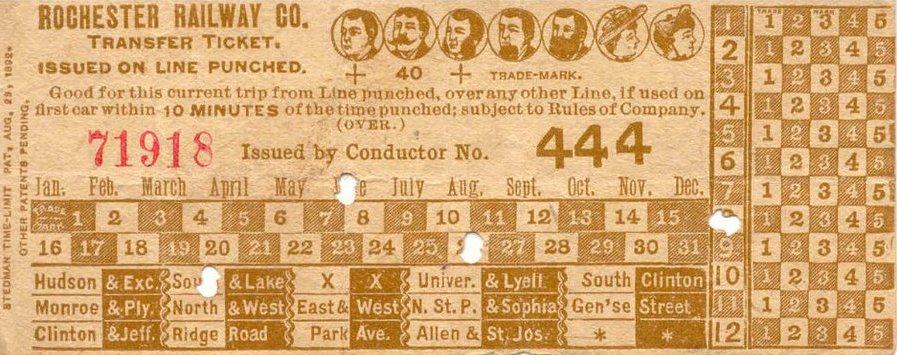
However, and for the record, we have yet to witness this particular design having been issued for any transportation company in the City of New York or other boroughs.
Furthermore, this design did not go over too well for several reasons. First, there were too many varieties of people. Second, mostly everyone dressed the same, sported similar styles of beards, etc. Third, there was a lot of discontent amongst the passengers whom complained, "I beg your pardon, but sir, I do not look that way!"
John Harry Stedman also came to be famous for the pipe cleaner. Yes, that pipe cleaner; the fuzzy wire things most of us used in elementary school to make "art". Originally they were all white, and when invented, they were made to clean tobacco pipes, not art projects. But I digress.
|
The Smith Patent, seems to have had a propensity for being used
in Manhattan and the Bronx, sporadically
in Queens and hardly at all in Brooklyn. Most of these were divided into three parts, the center section containing the route it was initially issued upon, and the date issued. This center section also contained 12 boxes marked 1 through 12 (to denoted the hour) and a box marked for AM or PM which would covered a 24 hour period on the bottom. The two end pieces (left side and right side) were used for second and even a third connection. These transfers were only issued upon payment of a supplementary fare on top of the initial fare. Some varieties of this ticket omitted the side stubs, had boxes for 4 to 12, a box for PM and a single box to denote 1 - 4 AM. This was because a lot of streetcar lines severely reduced service or ceased operating altogether in the wee hours of the morning. |
 |
There were usually four issues of the Smith Patent for each route: one for each direction: either north and south or east and west; and one for AM and one for PM.
A paying passenger paid the conductor / operator for your initial fare on the streetcar that one initially boarded. If one desired a transfer to a connecting or intersecting route, the passenger requested the transfer ticket, and if necessary paid any supplemental fare. The conductor / operator punched a transfer ticket with a ticket punch (as the conductors would for cash fare tickets on regular trains) and the conductor would give to you the transfer ticket. Upon alighting at your next segment and boarding that car, you presented the transfer ticket to the conductor. He removed one of the end stubs. If you needed to ride on the third segment, you repeated this process at which time you were only left with the center section of the original transfer.
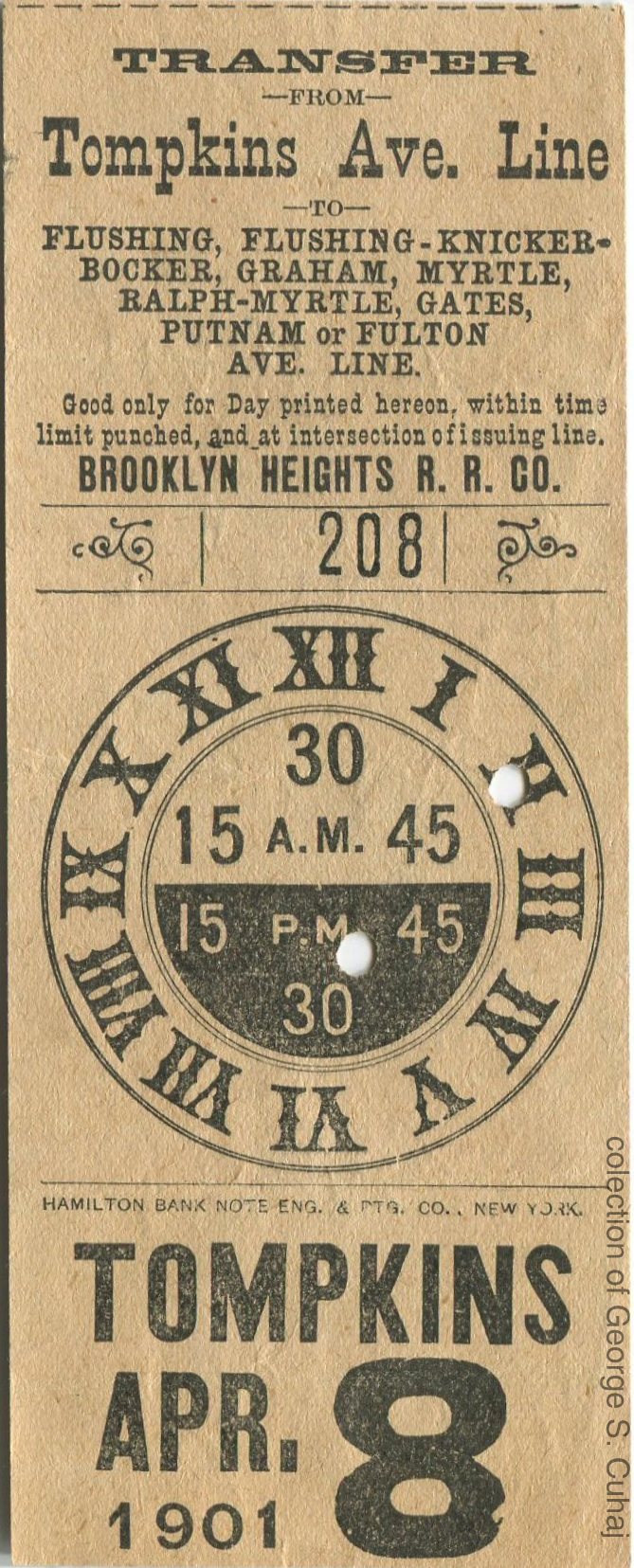 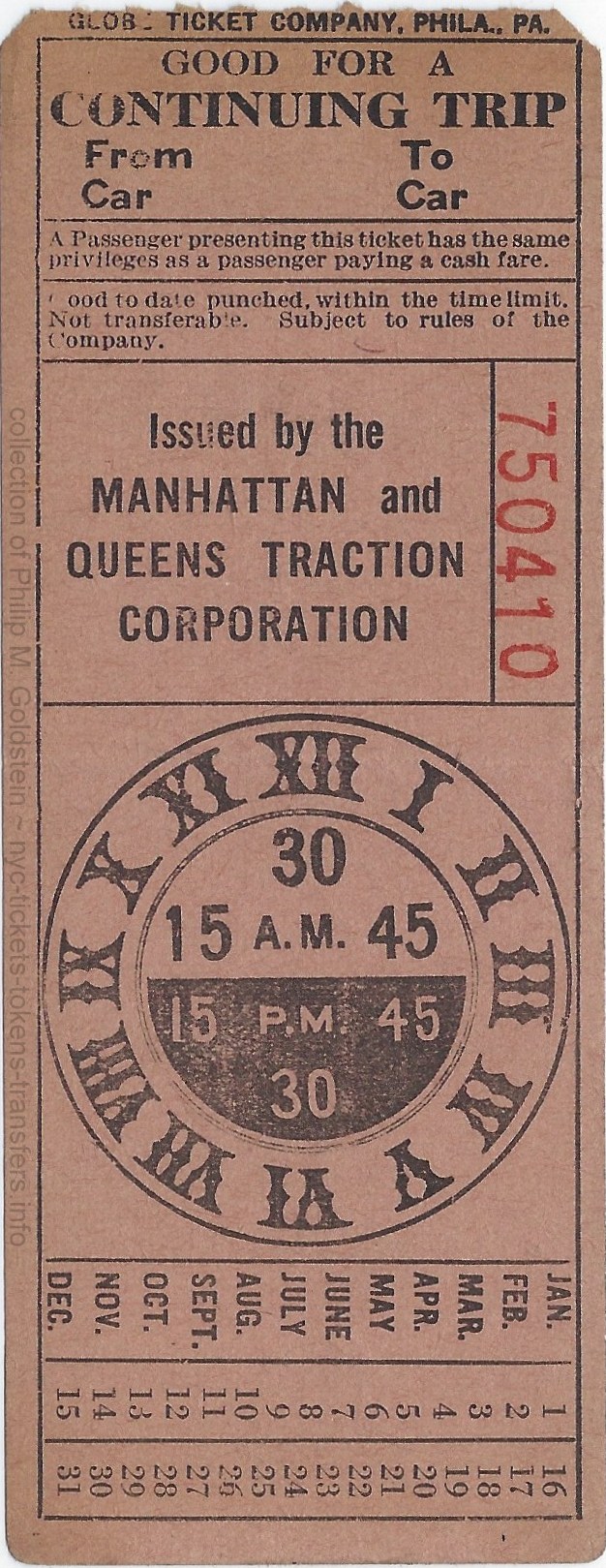 |
"Clock" style: (Hamilton, Globe) Hamilton Bank Note; Globe Ticket This design featured a round clock, and 15 minute increments in the center. The conductor punched the hour in the top half for AM, or in the bottom half for PM; and closest fifteen minutes. On the Tompkins Ave transfer seen at left, the time punched is 2 PM A listing at top reflected which lines the transfer was applicable for. |
.......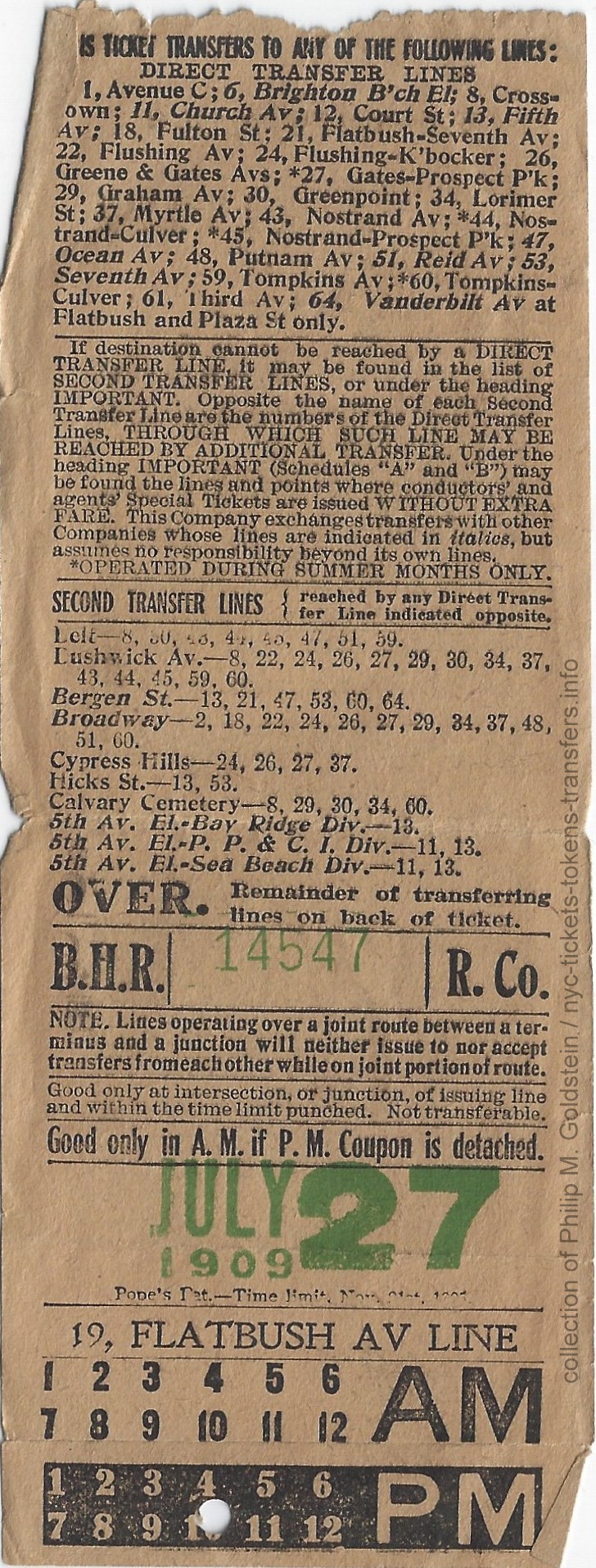 |
Pope Patent Appears to have been used in Brooklyn only; I have yet to see one issued for another borough; and used from ca. 1905 through 1933 This design utilizes two lines of 12 hour increments at the bottom: 1-6 and 7-16. One set for AM; and another set for PM, with the PM tab being detachable to prevent use on an AM only issue. Hour and issuing route punched by conductor. Without the ornate clock taking up the center of the ticket, there was much more room to list the specific lines the transfer was good for, as well the explaining the conditions for transfer use. As one can see, the excessive small type made this design difficult to read. |
When the patent expired on a particular design; then we will the same design continue to be used, however the patent holders name removed. Again, there were other minor transfer printers that saw use around the New York City area; so please keep in mind those transfers shown above were not the only types; just the most prevalent.
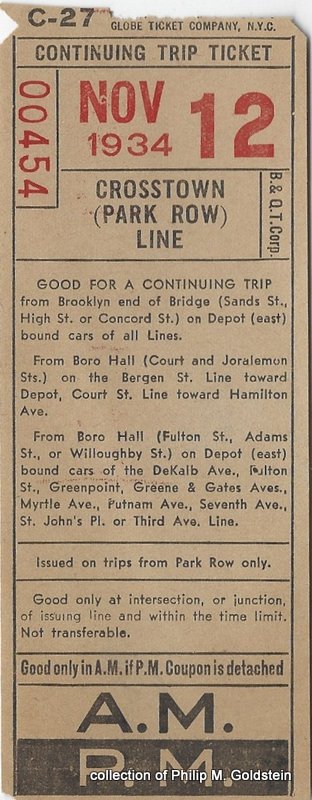 |
Globe AM/PM The Globe transfer can be considered the first "standardized" non-punchable transfer type throughout the City of New York. This design would come be used by almost all the municipal run routes in the other boroughs after the formation of the New York City Transit Authority in 1953. Furthermore, it was simplified to be issued without the need for punching time, date or direction. This is believed to be because the transit companies were in the process of eliminating the conductors position on the streetcars, and having the motorman / operator operate the streetcar and collect the fare and issue the transfers from the seated position in front of the bus, leaving the rear doors for exit only. Instead of an hourly listing, these have simple perforated PM tear off tab at the bottom. So if the transfer was issued in the morning, the PM stub was torn off as it was issued, making the transfer valid for use only in the morning hours and preventing the passenger of getting a ride later in the day. These tickets had all information printed on the face, and a blank back; which also saved on printing expenses. By this time, almost all the companies operating streetcars and buses have migrated to this simple ticket and made it the standard for all their lines and routes, and issuing agencies are B & QT Corp. (Brooklyn & Queens Transit Corp.), So B Ry. Co (South Brooklyn Railway Company). or N.Y.C.T.S . (New York City Transit System, Board of Transportation) |
These tickets were also easier to read than previous issue; and of which became even easier with the adaptation of a sans-serif typeface.
This Globe type seems to have really become widespread in 1934
In short, this nomenclature specifies what kind of transfer should be issued under the circumstances at that moment and intersection, from what type of line they were coming from and what type of line they were getting on. This was all for accounting purposes. Keep in mind, while one transfer may not have been used in one direction or at one terminal, but may have been needed in the opposite direction or other terminal. So yes, a conductor would be required to have on hand each and every type of transfer they needed along their assigned route. |
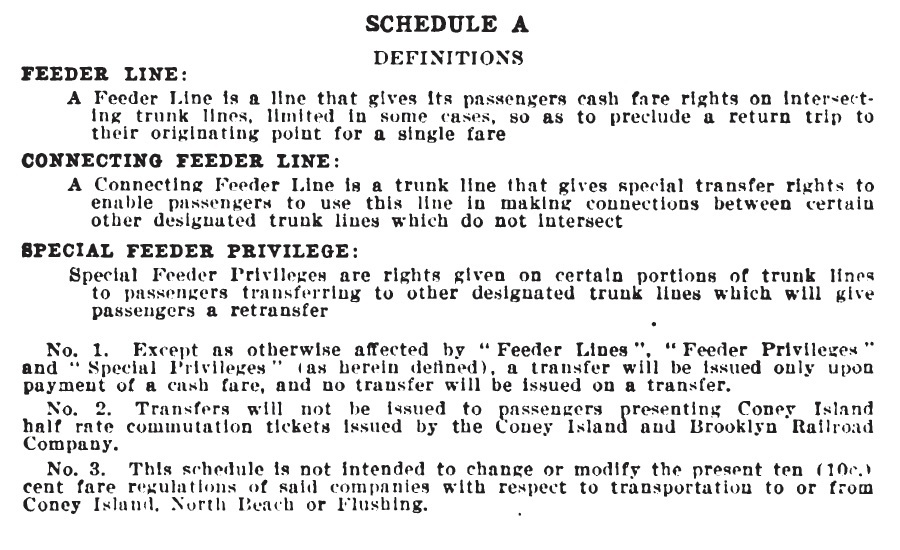 |
|
Colors
As previously mentioned, there were varying colors that the transfers were printed and issued in, to help denote their usage to conductors and operators. The colors so far observed are: |
|
|
White as mentioned in reference to transfer color: it is important to note; while in
the present we have come to accept a piece of white printer paper as
being
bright and true white; in the context of collecting or cataloging
transfers, what is called "white" is actually buff or the natural,
unbleached, undyed
pulp paper. True white, bleached paper (the backdrop), as far as known; was not used for NYCTA transfers or tickets until 1974 with the Half Fare Sunday issues. So for cataloging purposes on this website; I use buff to refer to the natural undyed color of pulp / newsprint paper, and "white" when used when referring to bright white writing / bond paper. Red and pink appears to only have been used on later special bus issues in 1966. The photo at right was taken indoors, because we as collectors will catalog the issues under indoor lighting. It goes without saying, that view the colors outside, under true sunlight, would render different shades. Furthermore, in regards to collecting transfers and tickets, determining these colors can be confusing as well, for two reasons: First: because of age and the fading process over the seventy plus years since the transfers were first printed. Purple appears to fade to brown, and the orange and the brown fades to buff. I had originally thought buff faded or got dirty to varying degrees; but upon carefully reading the notations on the transfers, it was learned there was in fact a "brown" transfer issued. So, those darkish "buffs", are actually brown. As such, I had to amend the catalog entries. |
|
Further compounding the proper identification of transfers by color can also be troublesome for the green issues as well. The green has a very nasty habit of also fading to a buff appearance. Many an issue I thought was buff, was actually green (upon finding a darker green issue and the stock & plate number and the revision date to matching up exactly to one already recorded in my collection and then reexamining the one in my collection more closely). Careful examination of the edges, around the staple holes, and the backs, is a must in attempting to identify a faded green issue from a buff. As such, I attempt to acquire better green issues as I encounter them when they match faded examples and these are updated accordingly on this page. That should help a little bit in most cases for the other transfer collectors out there. But if a collector notices where I present a transfer as buff, and their transfer matches in every way and is green, please feel free to contact me with a quick photo or scan so I can confirm and amend. Secondly, it cannot be relied upon that a color denoted a particular direction of travel. At least not until the late 1960's. For earlier issues, both trolley lines and bus routes alike; colors are now known to have changed on a monthly basis. This further complicates matters because you will witness aparticular transfer plate number (for the same route, same direction) only one month apart that that exists in two different colors. This was realized when I procured a large collection of transfers in 2023; and despite the text and plate numbers being identical on two different transfers, the colors were blatantly different. The only difference between the two was the issue month. Some routes used a one color / one direction system, but others did not; and again this was not a universal standard until much later where a particular color was reserved for a specific direction and throughout the system. Furthermore, the corresponding colors pre-1948 were not always were carried over to the later Board of Transportation - NYCTS - BMT Division Surface Lines issues. As they simplified issues with the color noting the direction of travel: green in one direction / buff in the other; with salmon or red issues noting a special transfer; and the the brown and purple issues discontinued. |
|
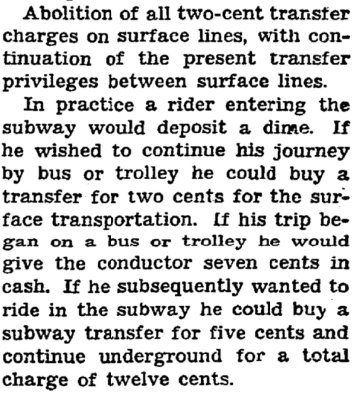
"New York state public-benefit corporations and authorities operate like quasi-private corporations, with boards of directors appointed by elected officials, overseeing both publicly operated and privately operated systems. Public-benefit nonprofit corporations share characteristics with government agencies, but they are exempt from many state and local regulations. Of particular importance, they can issue their own debt, allowing them to bypass limits on state debt contained in the New York State Constitution. This allows public authorities to make potentially risky capital and infrastructure investments without directly putting the credit of New York State or its municipalities on the line. As a result, public authorities have become widely used for financing public works, and they are now responsible for more than 90% of the state's debt."

| Nassau Electric Railroad |
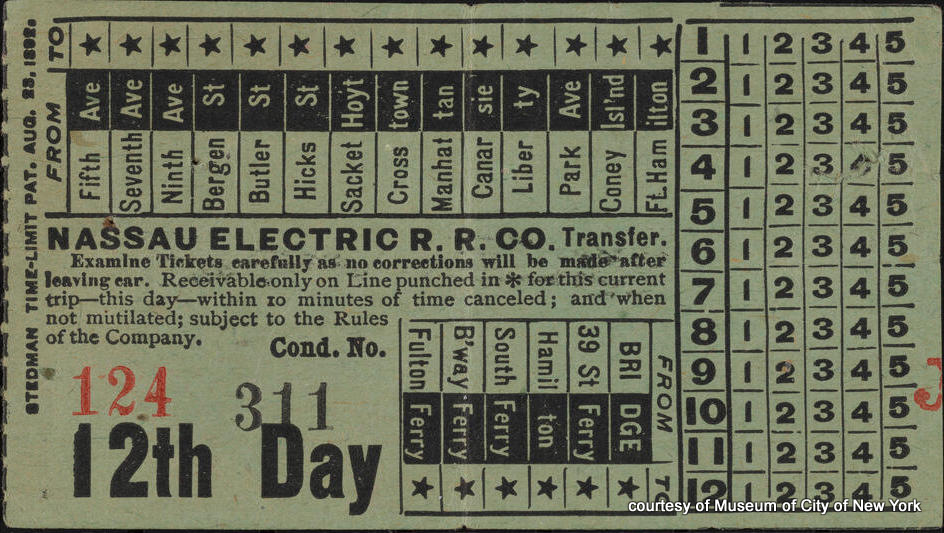 |
| Stedman Time-Limit - Pat August 23, 1892 |
| old Line Numbering - ca. 1905 | |||||||||||||
| 1 | Avenue C | 11 | Church Avenue | 21 | Flatbush - Seventh Avenue | 30 | Greenpoint | 40 | Marcy Avenue | 51 | Reid Avenue | 60 | Tompkins - Culver |
| 2 | Belt | 12 | Court Street | 22 | Flushing Avenue | 32 | Hamburg Avenue | 41 | Metropolitan Avenue | 53 | Seventh Avenue | 61 | Third Avenue |
| 4 | Bergen Street | 13 | Fifth Avenue | 24 | Flushing - Knickerbocker | 34 | Lorimer Street | 42 | Metropolitan Avenue Shuttle | 54 | St. Johns Place | 62 | Union Avenue |
| 5 | Broadway | 18 | Fulton Street | 26 | Greene & Gates Avenues | 36 | Montague Street | 43 | Nostrand Avenue | 55 | Sumner Avenue | 63 | Union Street |
| 6 | Brighton Beach Elevated | 27 | Gates - Prospect Park | 37 | Myrtle Avenue | 44 | Nostrand - Culver | 56 | Ralph Rockaway | 64 | Vanderbilt Avenue | ||
| 8 | Crosstown | 29 | Graham Avenue | 45 | Nostrand - Prospect Park | 59 | Tompkins Avenue | 65 | Wyckoff Avenue | ||||
| 9 | Hicks Street | 47 | Ocean Avenue | ||||||||||
| 48 | Putnam Avenue | ||||||||||||
| 49 | Park Avenue | ||||||||||||
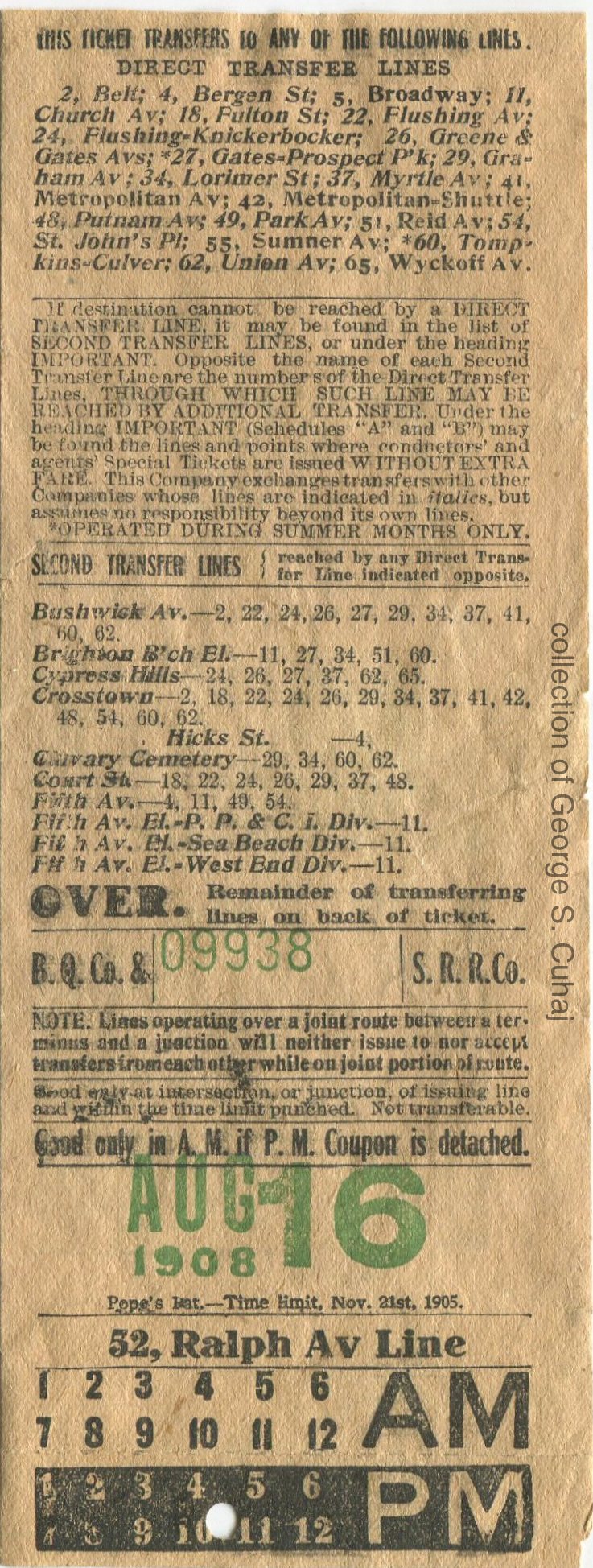 |
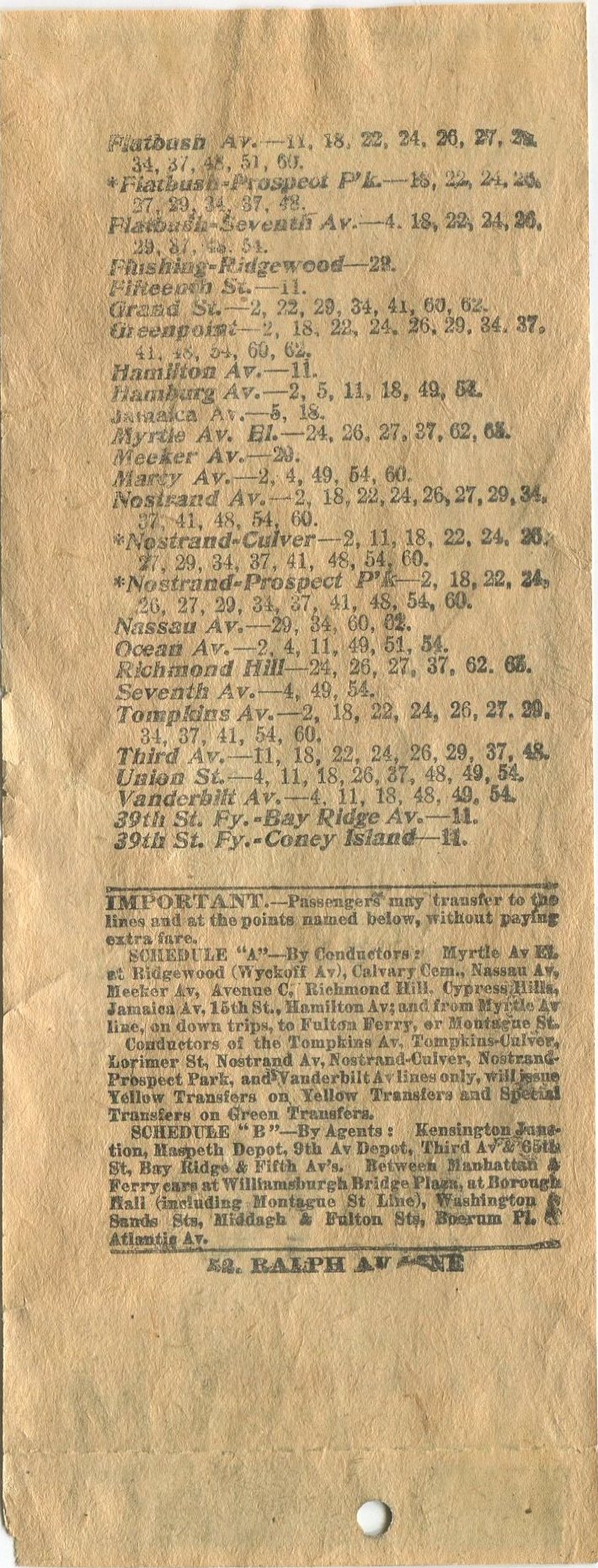 |
intentionally left blank | 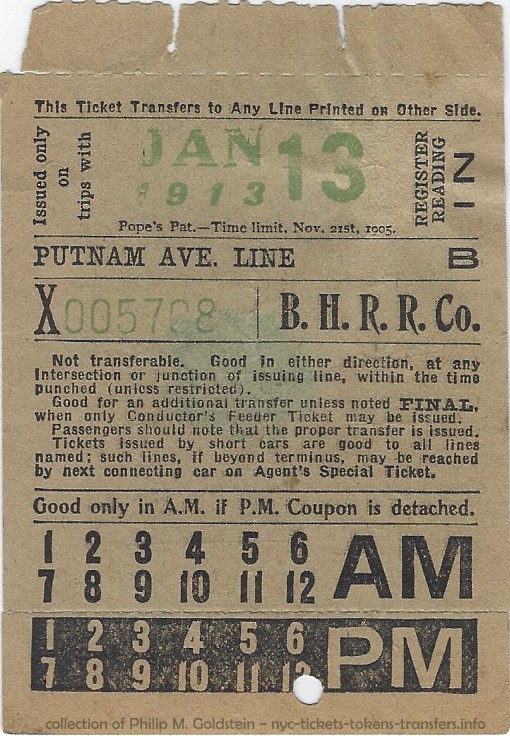 |
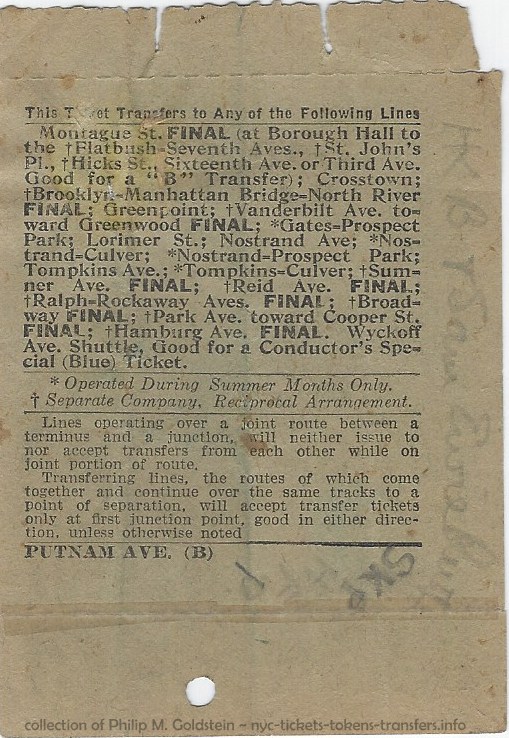 |
|
52 - Ralph Avenue - Aug 16, 1908
two sided, early type Brooklyn, Queens County & Suburban RR 2 5/8" x 6 1/8" |
Putnam Avenue - Jan 13, 1913
two sided, early type Brooklyn Heights Railroad 2 1/2" x 3 5/8" w/ 5/16" selvage |
|||
 |
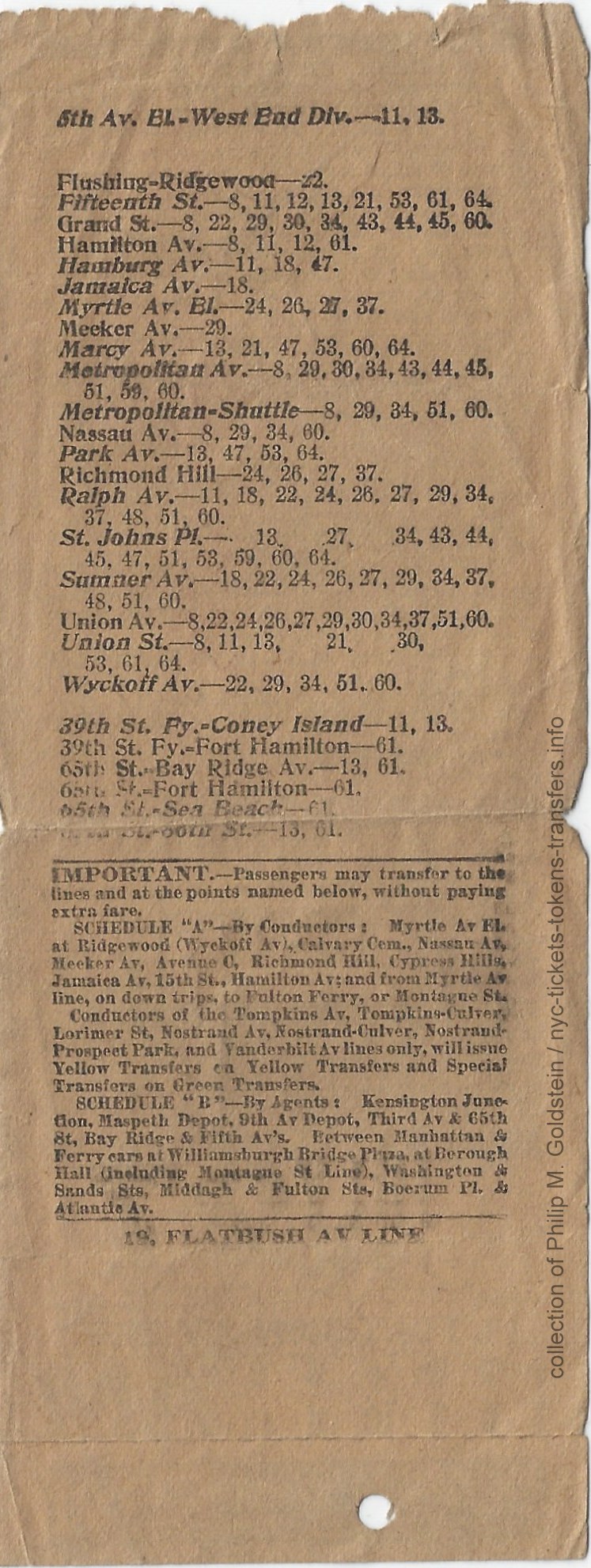 |
intentionally left blank | 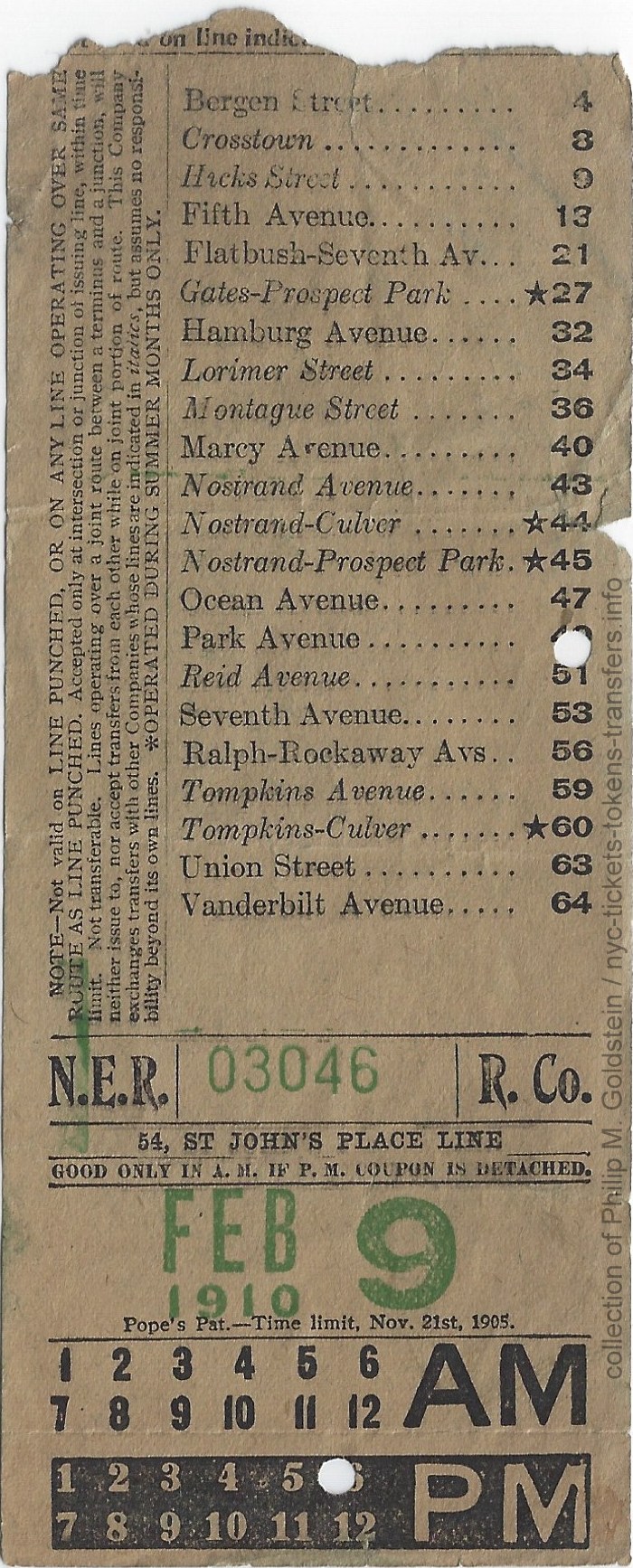 |
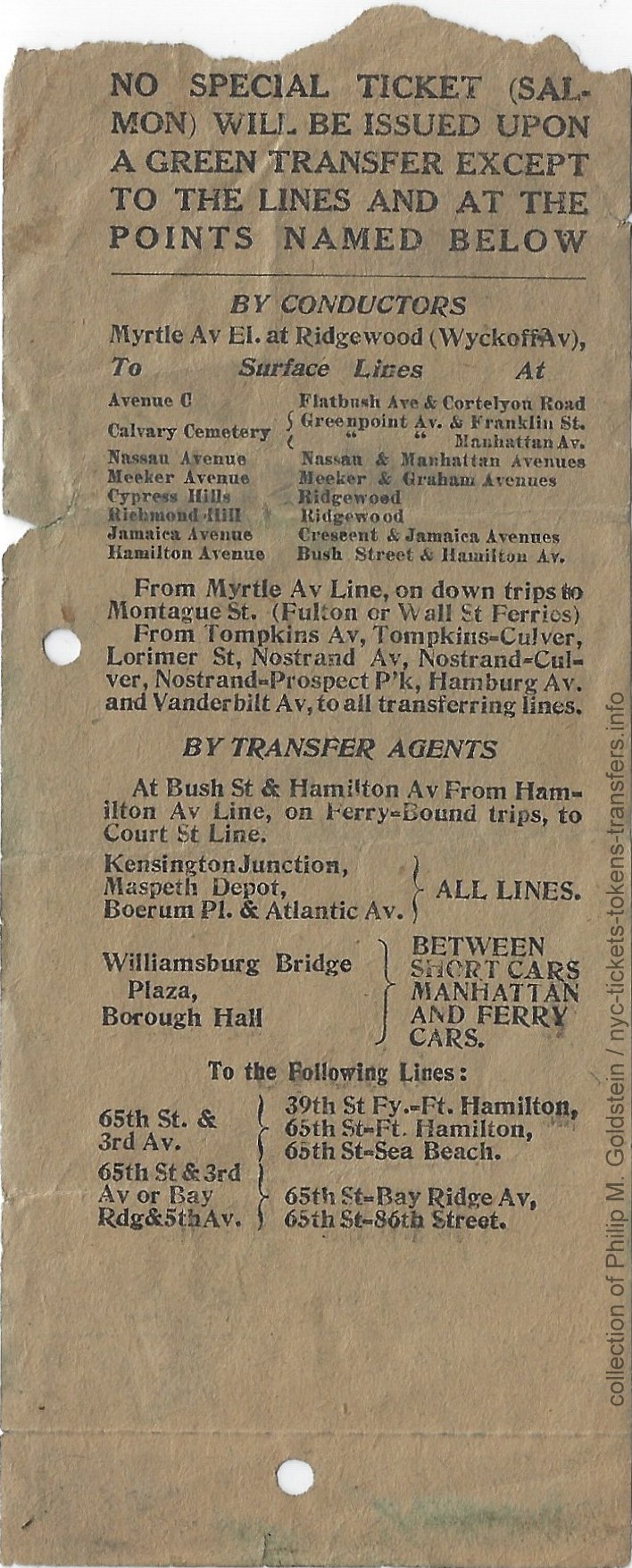 |
|
19 - Flatbush Avenue - July 27, 1909
two sided, early type Brooklyn Heights Railroad 2 5/16" x 6 1/8" |
54 - St. Johns Place - Feb 9, 1910
two sided, early type Brooklyn Heights Railroad Note restriction: no special ticket (salmon) will be issued upon a green transfer except to the lines and the points named below) 2 5/16" x 5 5/8" |
|||
| . | ||||
|
.
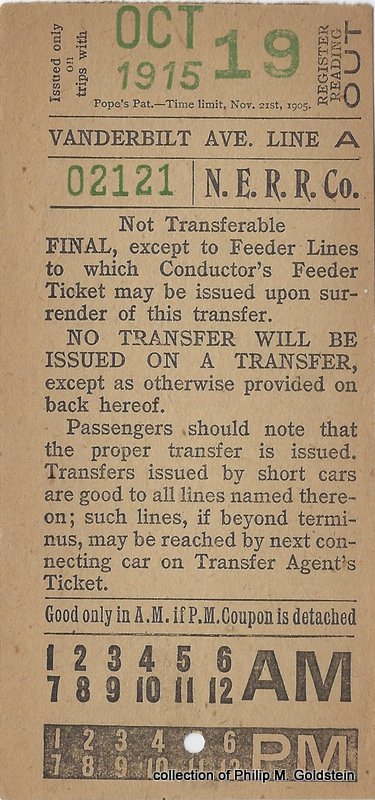 |
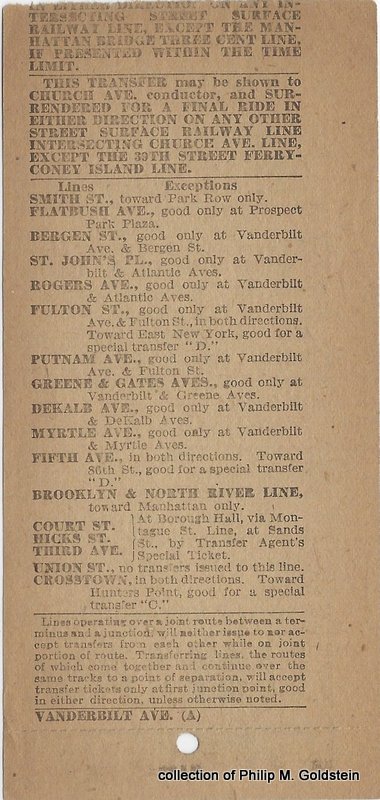 |
intentionally left blank | intentionally left blank | intentionally left blank |
| Vanderbilt Avenue Line - A - Oct 19, 1915 Nassau Electric RR two sided, later type 2 3/8" x 5 1/8" without selvage |
||||
| . . |
||||
|
Pope's Patent Type with advertising on, or blank; reverse
route numbers removed |
||||
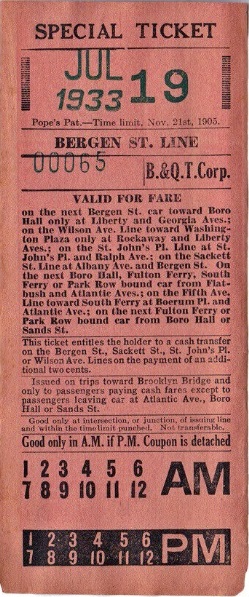 |
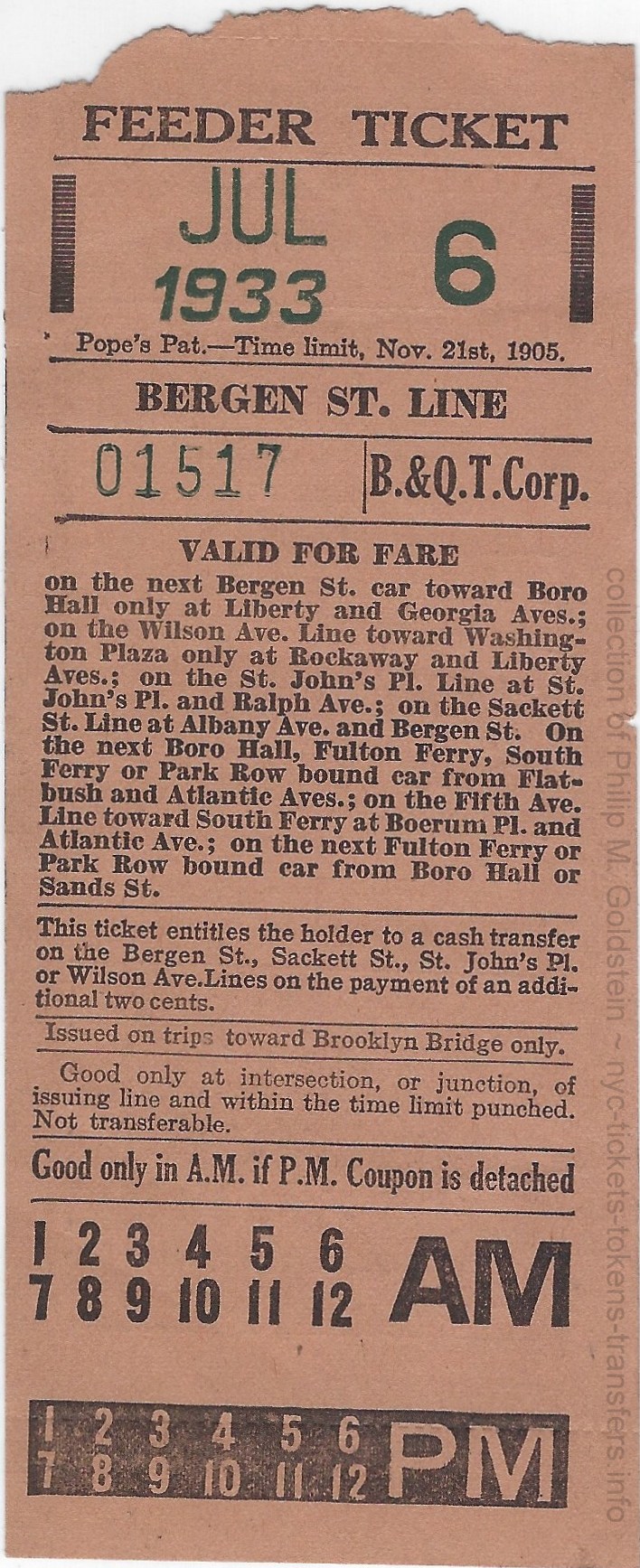 |
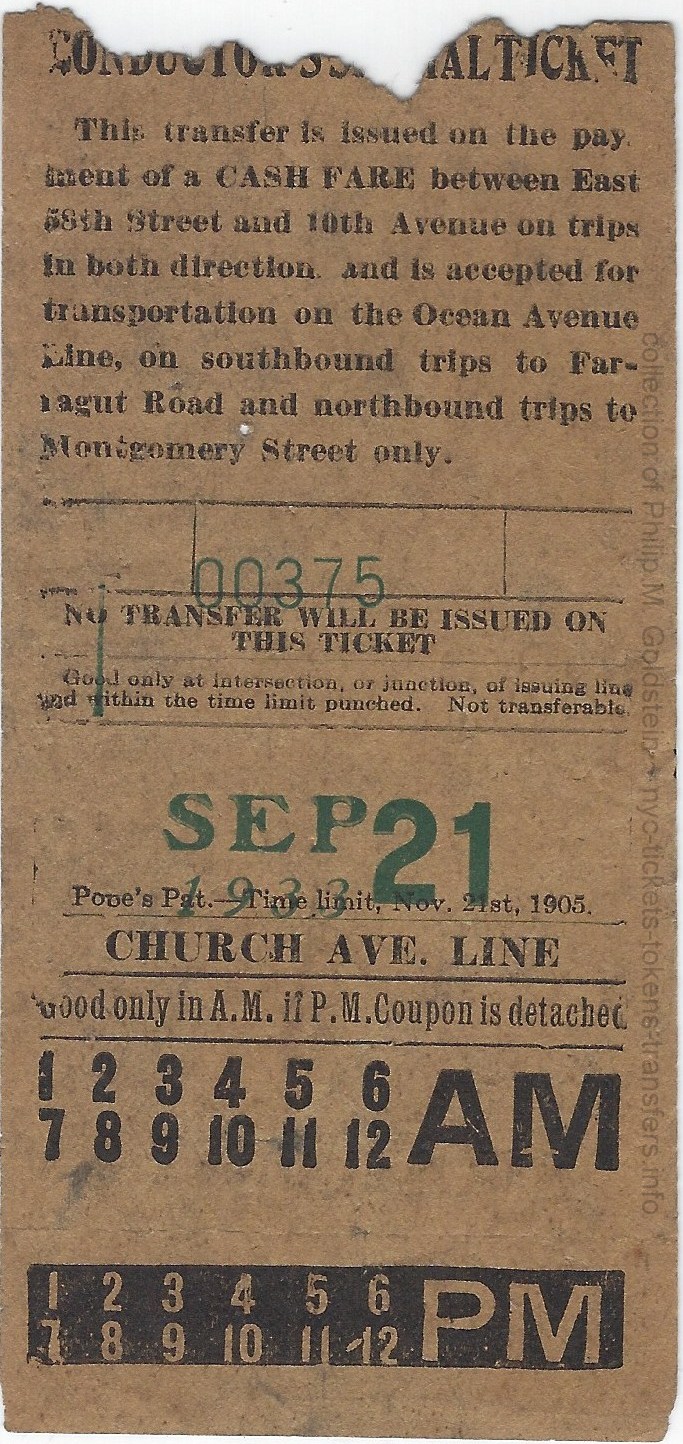 |
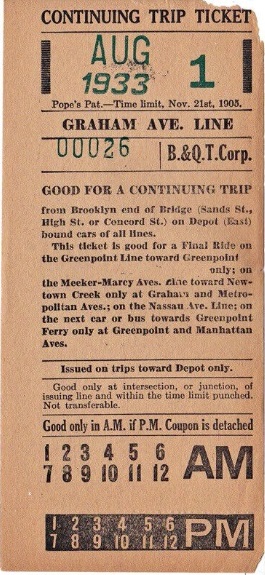 |
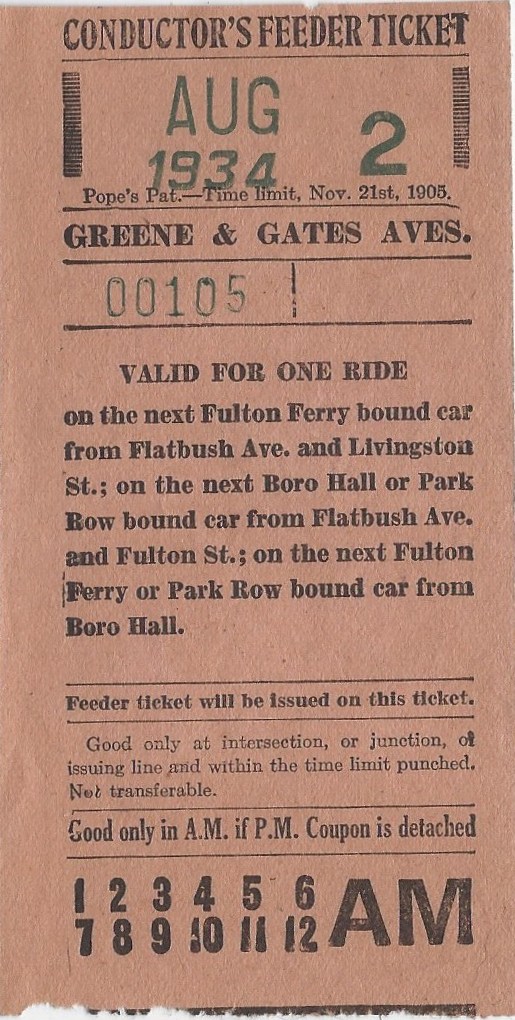 |
| Special Ticket - Jul 19, 1933 Bergen Street B&QT Corp. (Brooklyn Queens Transit) |
Feeder Ticket - Jul 6, 1933 Bergen Street B&QT Corp. (Brooklyn Queens Transit) |
Conductors Special Ticket - Sep 21 1933 Church Avenue |
Continuing Trip Ticket - Aug 1, 1933 Graham Avenue B&QT Corp. (Brooklyn Queens Transit) |
Conductor's Feeder Ticket - Aug 2, 1934 Greene & Gates Aves. 2 1/2" x 5" without selvage |
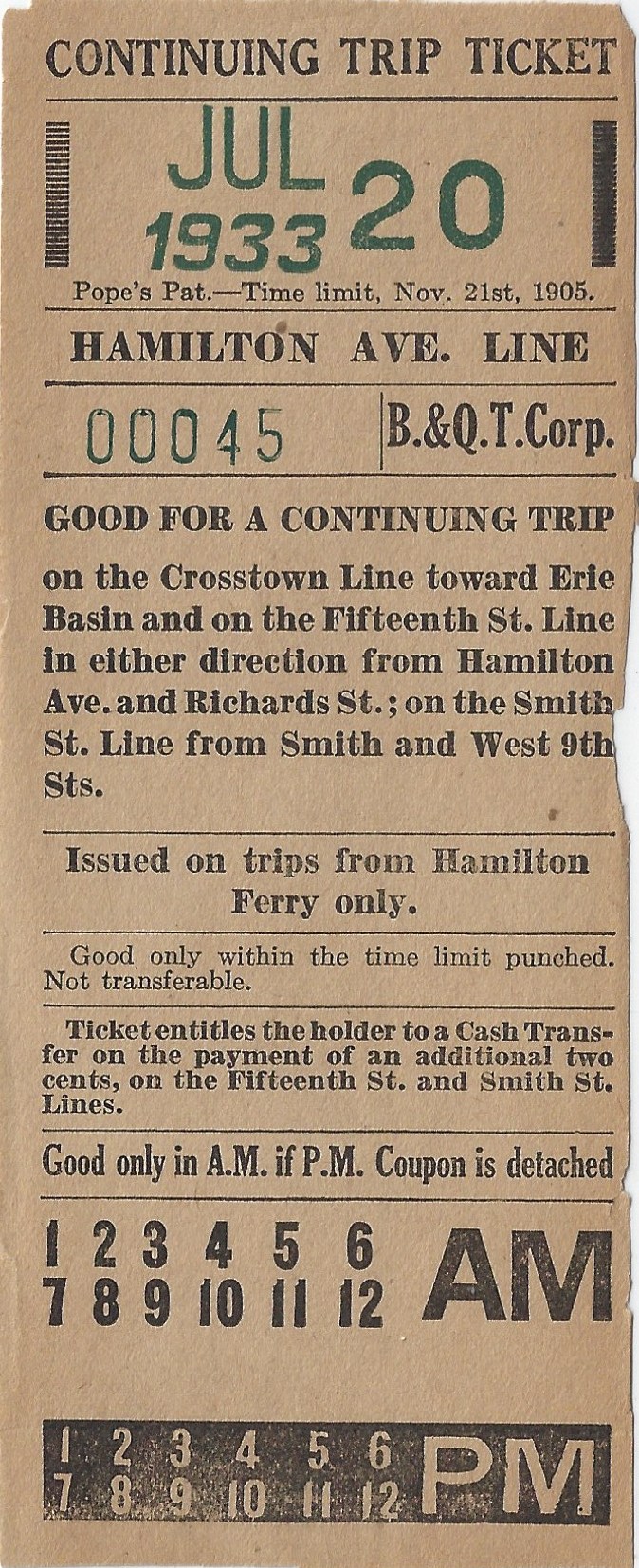 |
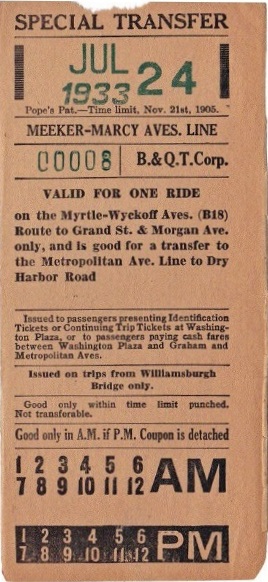 |
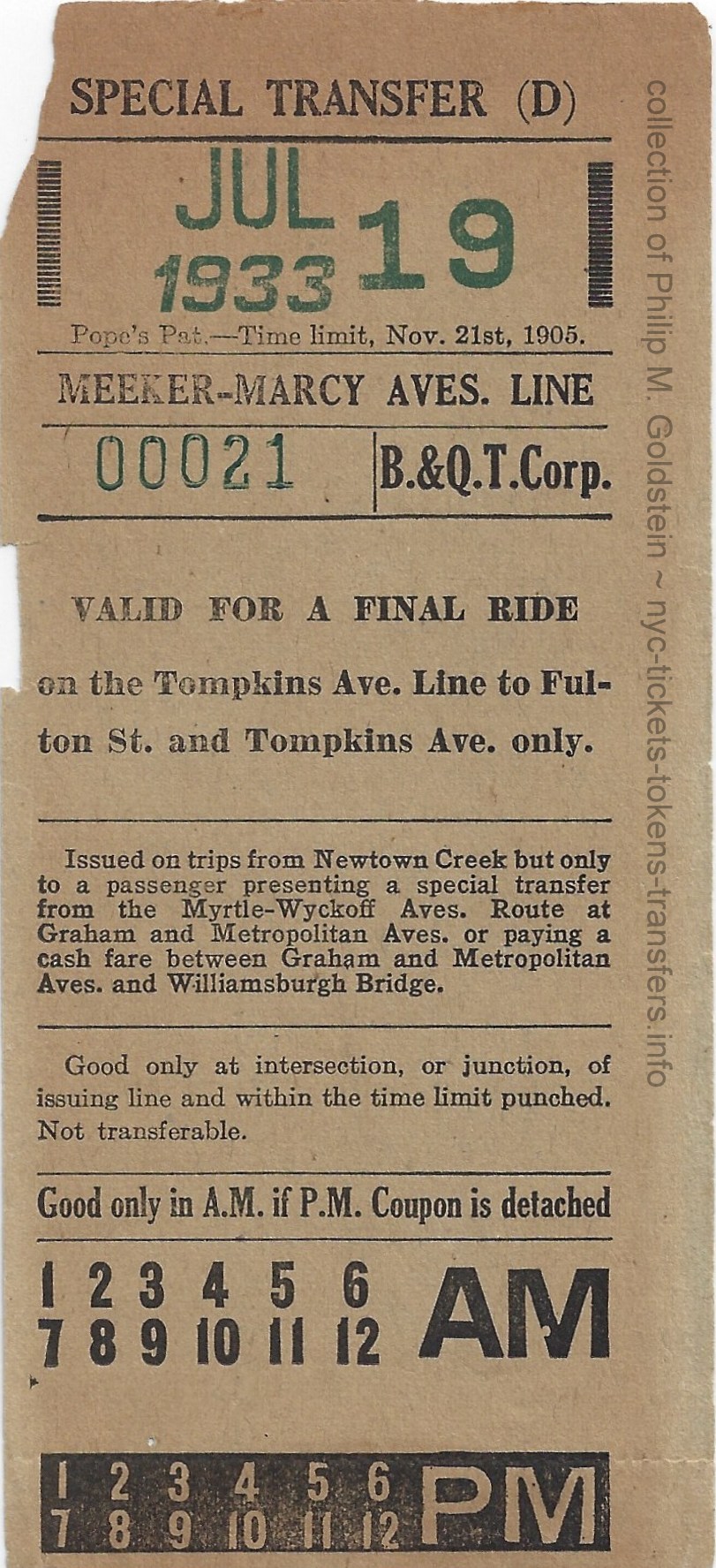 |
 |
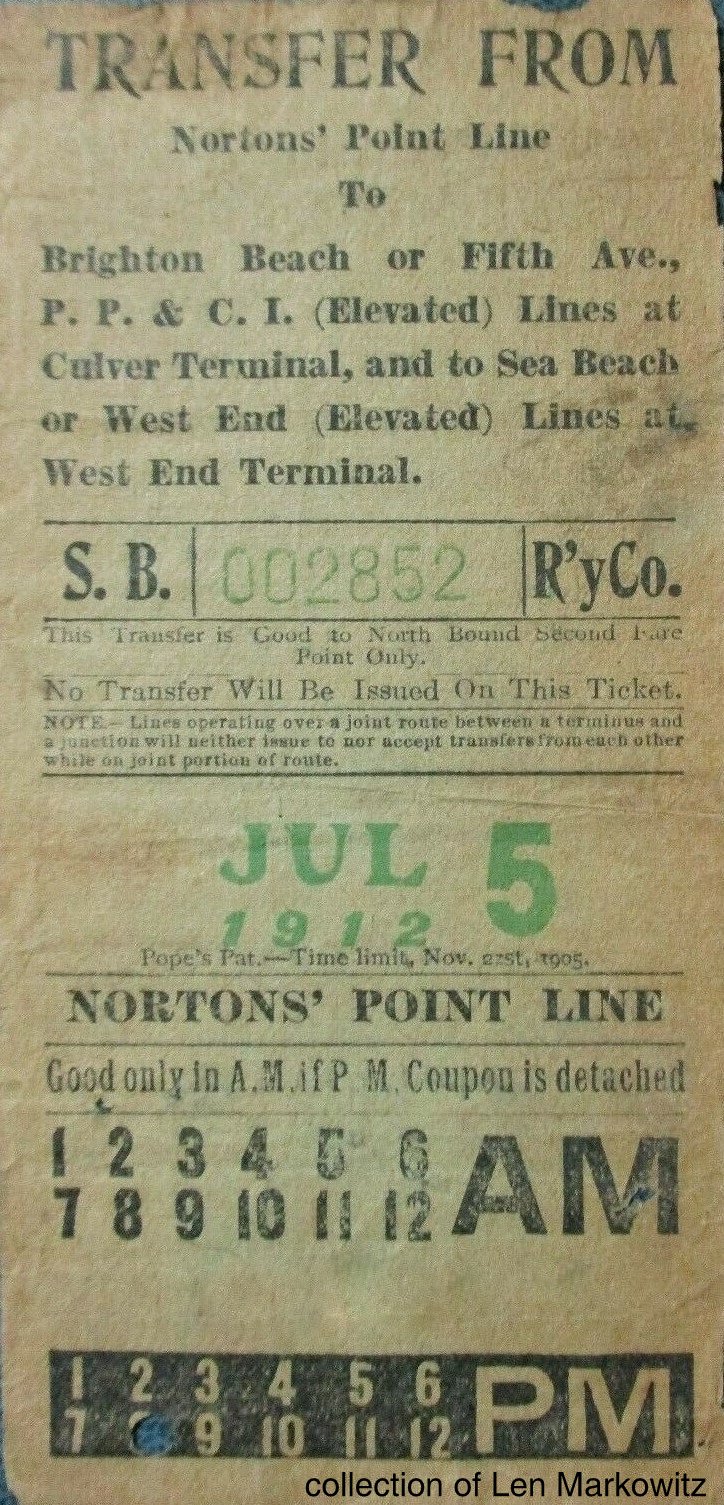 |
| Continuing Trip Ticket - Jul 20, 1933 Hamilton Avenue Line B&QT Corp. (Brooklyn Queens Transit) |
Continuing Trip Ticket - Jul 24, 1933 Meeker - Marcy Avenues Line B&QT Corp. (Brooklyn Queens Transit) |
Special Transfer (D) Ticket - Jul 19, 1933 Meeker - Marcy Avenues Line B&QT Corp. (Brooklyn Queens Transit) |
Continuing Trip Ticket - Jul 19, 1933 Nassau Avenue Line B&QT Corp. (Brooklyn Queens Transit) |
Transfer - Jul 5, 1912 Norton's Point Line S. B. R'y Co. (South Brooklyn Railway) |
| . | ||||
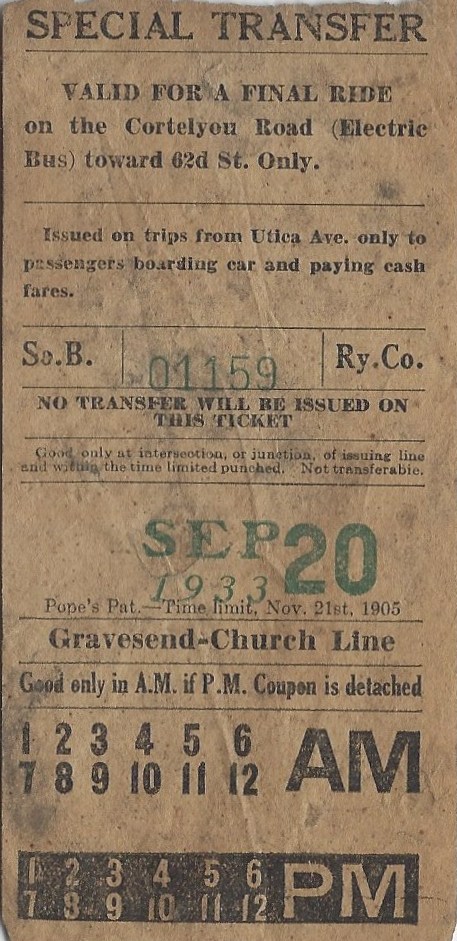 |
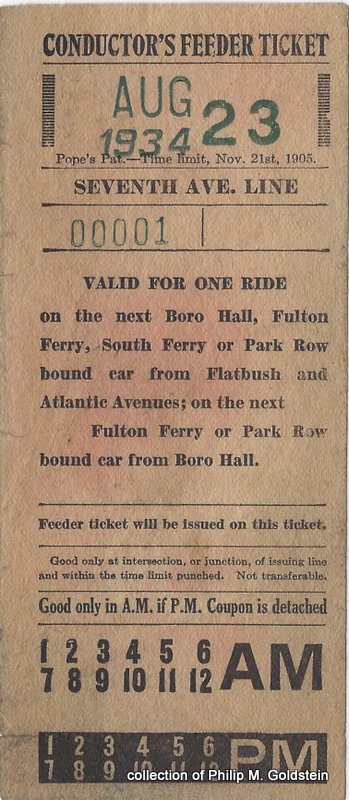 |
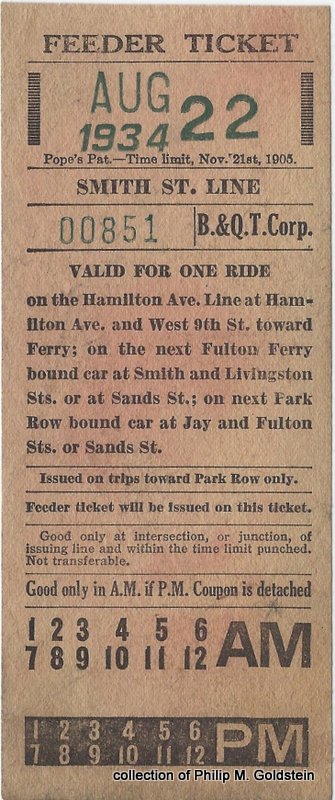 |
intentionally left blank | intentionally left blank |
| Special Transfer - Sep 20, 1933 Gravesend - Church Line So. B. Ry. Co. (South Brooklyn Railway) 2 1/4" x 4 5/8" without selvage |
Conductor's Feeder Ticket - Aug 23, 1934 Seventh Avenue Line 2 3/8" x 5 1/2" without selvage |
Feeder Ticket Aug 22, 1934 Smith Street Line B&QT Corp. (Brooklyn Queens Transit) 2 3/8" x 5 1/2" without selvage |
||
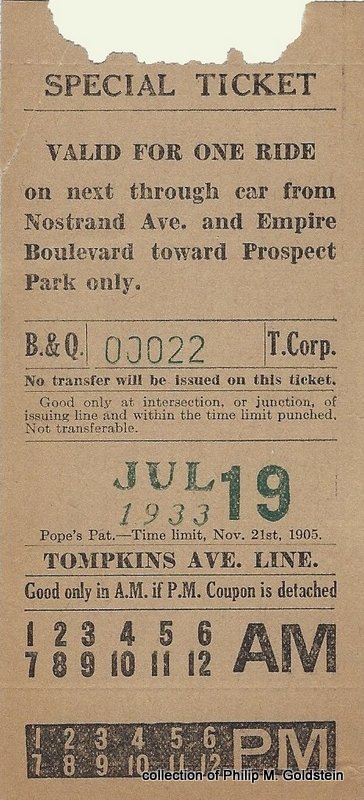 |
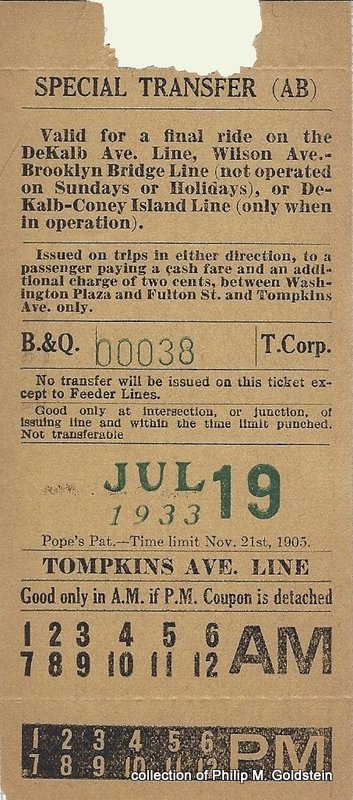 |
 |
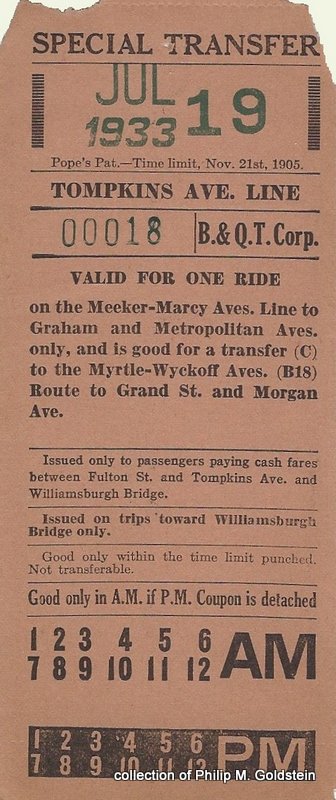 |
intentionally left blank |
| Special Ticket - Jul 19, 1933 Tompkins Avenue Line B&QT Corp. (Brooklyn Queens Transit) 2 3/8" x 5 1/8" with partial selvage |
Special Transfer (AB) - Jul 19, 1933 Tompkins Avenue Line B&QT Corp. (Brooklyn Queens Transit) 2 1/4" x 5 3/16" with selvage |
Special Transfer - Jul 19, 1933 Tompkins Avenue Line B&QT Corp. (Brooklyn Queens Transit) 2 3/8" x 6 1/16" with partial selvage |
Special Transfer - Jul 19, 1933 Tompkins Avenue Line B&QT Corp. (Brooklyn Queens Transit) 2 5/16" x 5 1/2" to perforation |
|
for
an odd and as yet undetermined reason, Pope Patent tickets are not as
frequently encountered as the earlier Stedman or Smith Patent issues.
scarce $17.50 - $20.00, with 10% premium for special dates, 50% premium for transfers issued on last day of service on that route. |
||||
| K-1 B&QT |
K-2 B&QT |
... | K-1 NYCTS |
K-2 NYCTS |
... | 6-10 BOT |
6-11 BOT |
| C-5 D-7-48 | C-5 E-3-49 | C-5 H-1-52 | C-6 D-7-48 | C-6 E-39-49 |
| Brooklyn & Queens Transit |
1-1 | 1-1 | 1-2 | 1-2 | 1-3 | 1-4 | |
| N.Y.C.T.S. | 1-1 | 1-2 | A-10 | A-11 | BOT / NYCTS / BMT Division - Surface Lines |
| Brooklyn & Queens Transit |
J-1 | J-1 | J-2 | J-2 | J-3 | J-4 | J-5 |
| N.Y.C.T.S. | 1-1 | 1-2 | |||||
| BOT / NYCTS / BMT Division - Surface Lines | A-10 | A-10 | A-10 | A-10 | A-10 | A-10 | |
| continued below ► | |||||||
| A-11 | A-11 | A-11 | A-11 | ||||
Court Street Line July 17, 1949 |
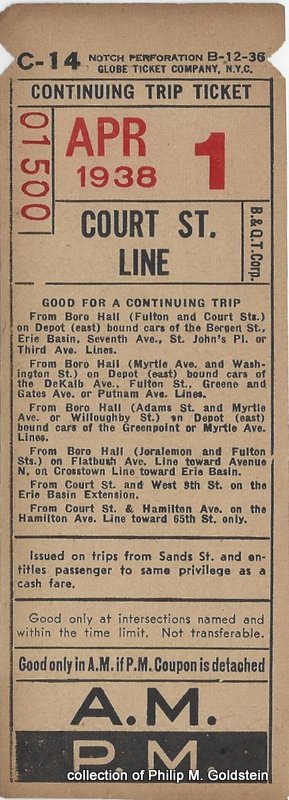 |
| C-14 (buff) B-12-35 Continuing Trip Ticket from Sands St Brooklyn & Queens Transit Corp |
Erie Basin Extension |
 |
| C-31 (brown) E-3-38 Transfer (C) Brooklyn & Queens Transit Corp |
Fifteenth Street Line December 1, 1945 |
 |
| B-5 (buff) 6-38 Special Transfer (A) from 20th Street Brooklyn & Queens Transit Corp |
The Flatbush Avenue Line was comprised of three component lines:
The "main line" ran from Borough Hall in Downtown Brooklyn to Avenue N.
Here, the line split. Going east the East 71st Street Branch (#1); or continued south to the Avenue U Branch (#2).
As such, there are many sub varieties of issues. While I had originally kept them together, it was now necessary to separate them by branch.
| Flatbush Avenue - Main Line (Borough Hall to Avenue N) | ||
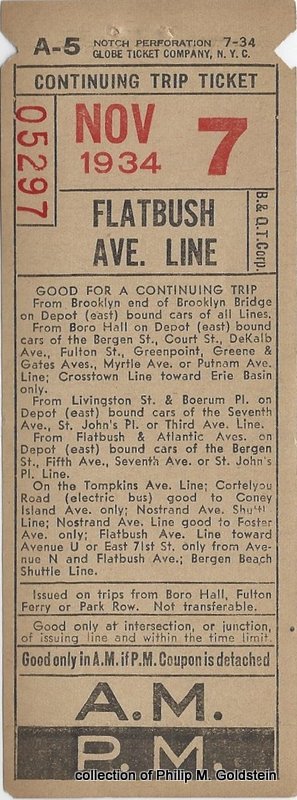 |
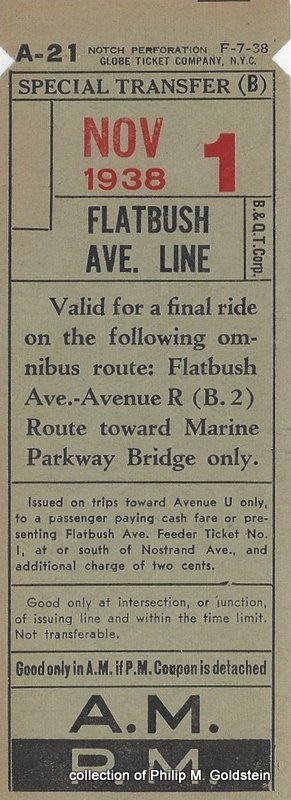 |
intentionally left blank |
| A-5 (buff) 7-34 Continuing Trip Ticket from Boro Hall Fulton Ferry or Park Row Brooklyn & Queens Transit Corp. |
A-21 (green) F-7-38 Special Transfer (B) towards Avenue U Brooklyn & Queens Transit Corp. |
|
| . | ||
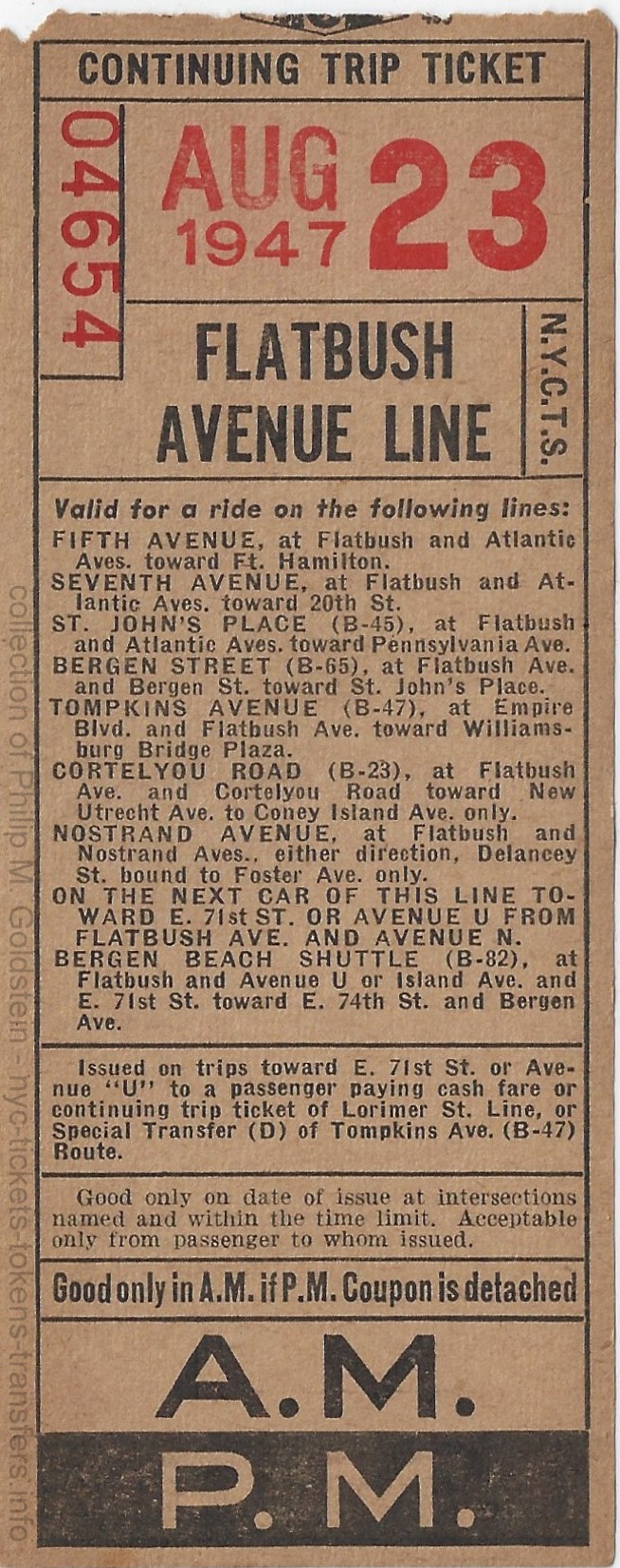 |
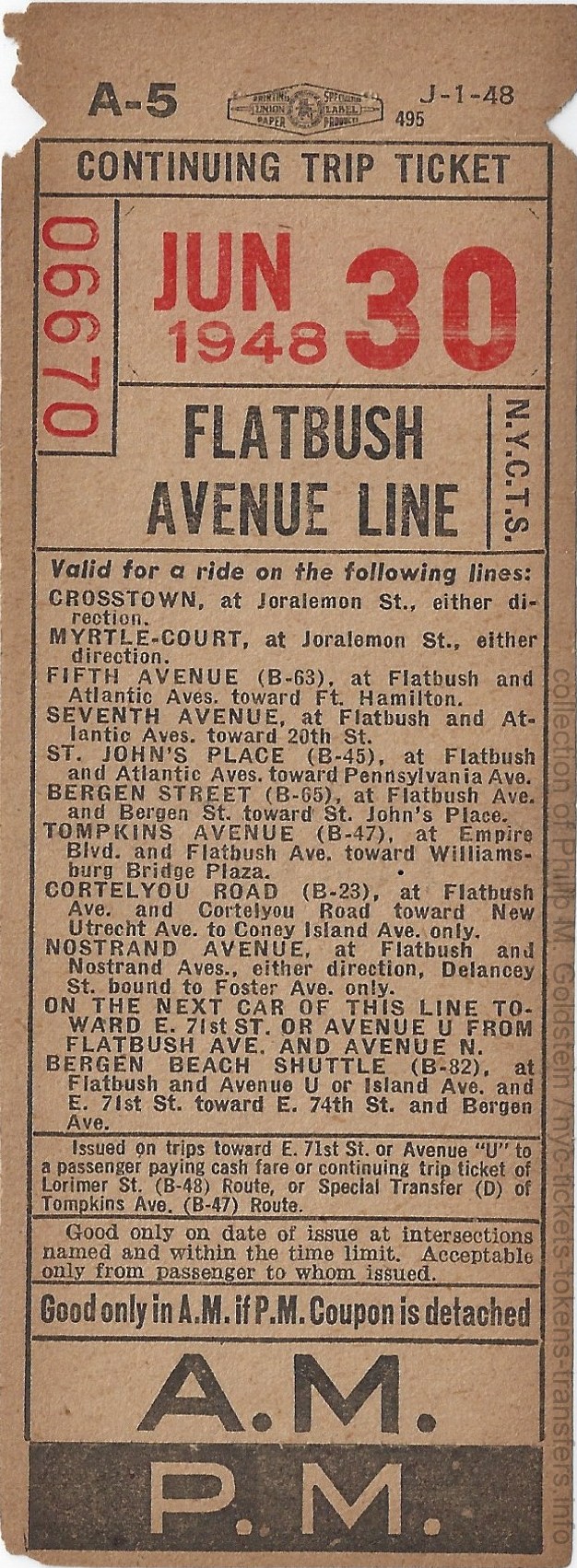 |
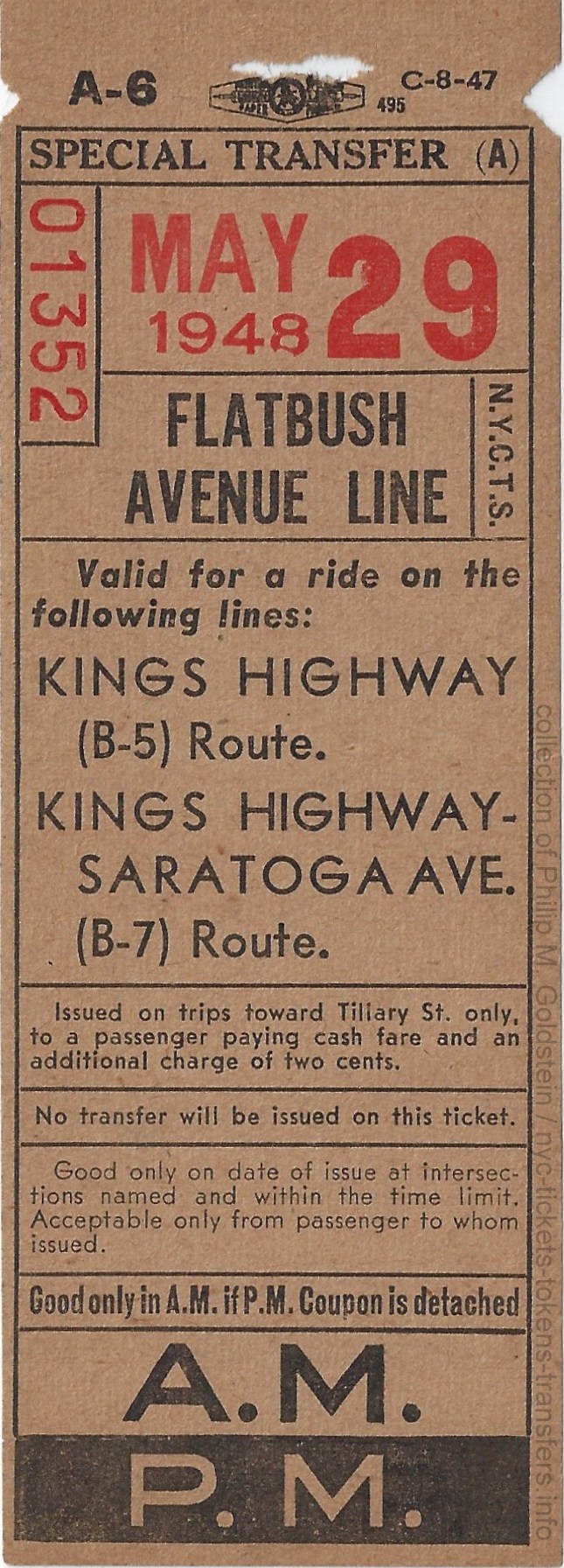 |
| A-5? (buff) Aug 23, 1947 Continuing Trip Ticket toward E 71st St. or Avenue U NYCTS |
A-5 (buff) Continuing Trip Ticket toward E 71st St. or Avenue U Crosstown and Myrtle court lines listed NYCTS |
A-6 (buff) C-8-47 Special Transfer (A) toward Tillary NYCTS |
| . | ||
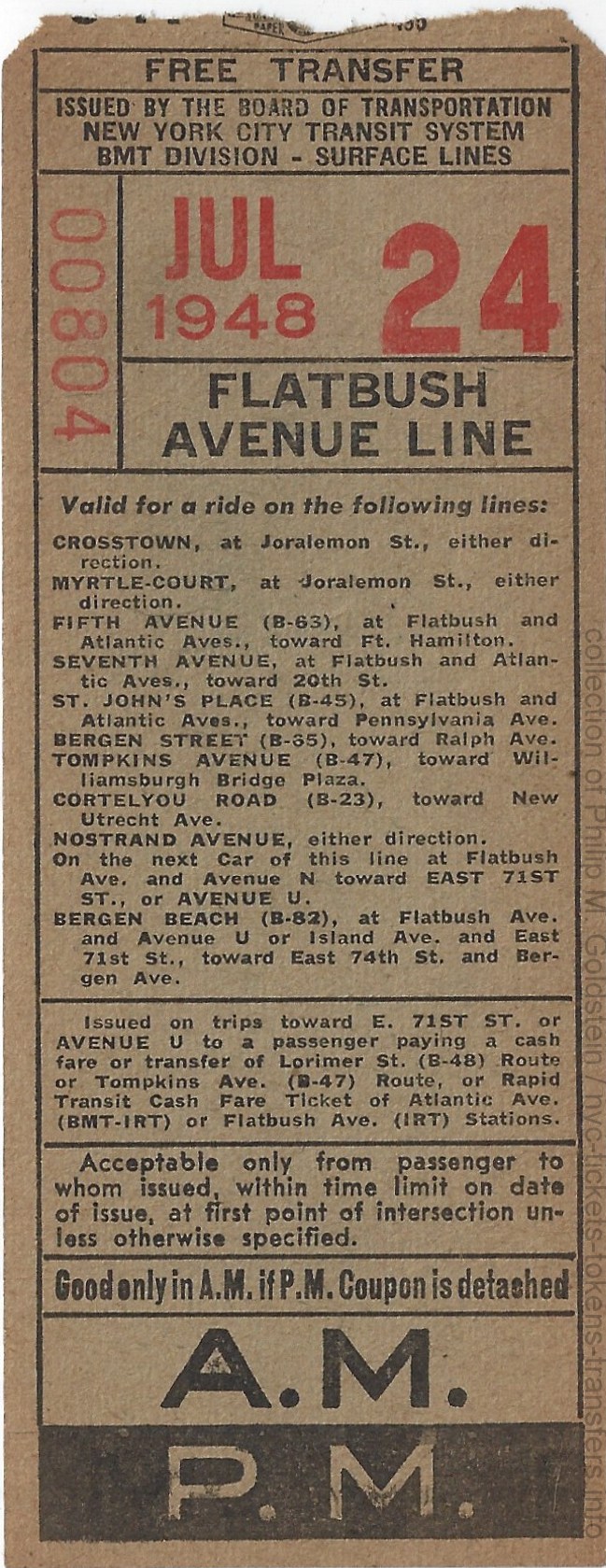 |
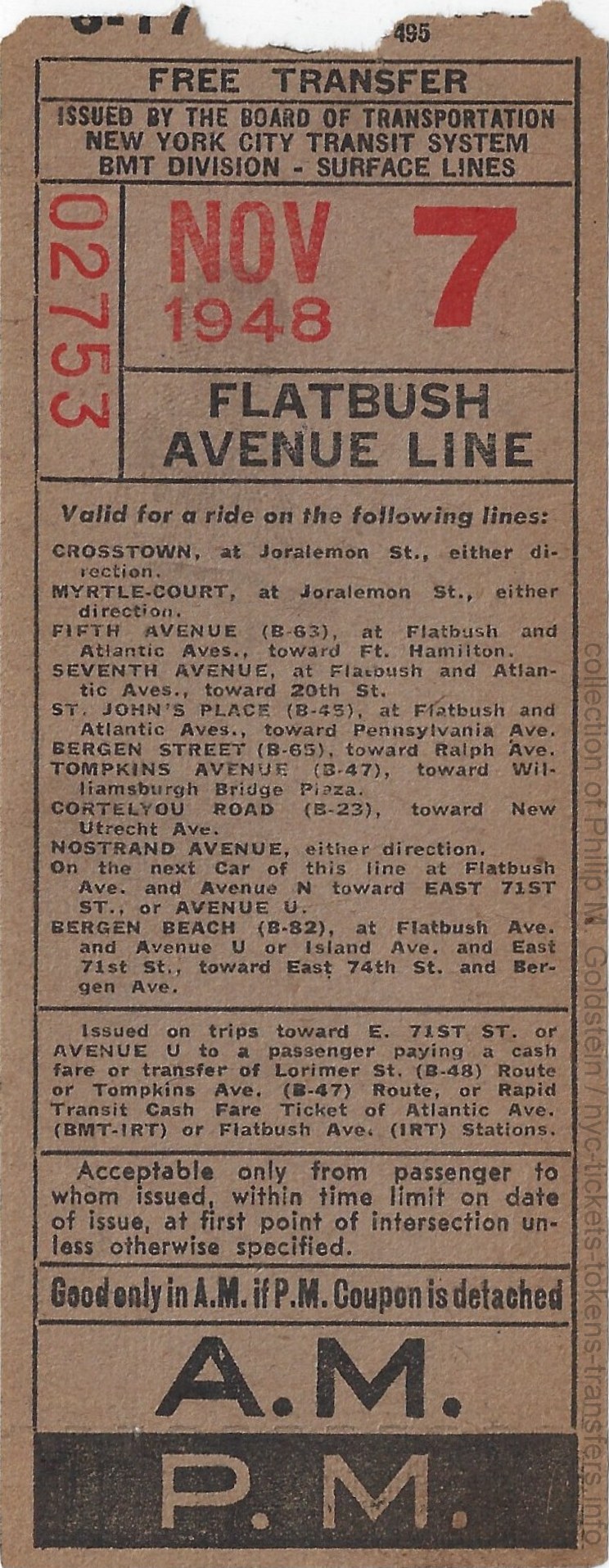 |
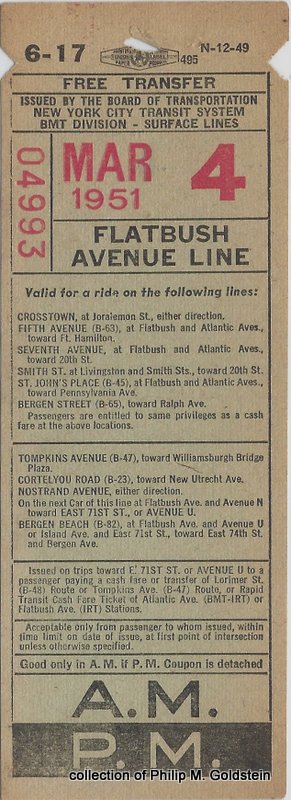 |
| 6-17 (green) Jul 24, 1948 Free Transfer toward E 71st St. or Avenue U small font BOT / NYCTS / BMT |
6-17 (purple) Nov 7, 1948 Free Transfer toward E 71st St. or Avenue U small font BOT / NYCTS / BMT |
6-17 (green) N-12-49 Free Transfer toward E 71st St. or Avenue U large font last day of trolley service BOT / NYCTS / BMT |
Greene & Gates Avenue Line October 5, 1941 |
 |
| G-6 (salmon) F-4-38 Feeder Ticket Brooklyn & Queens Transit Corp. |
Nassau Avenue Line (date?) |
|
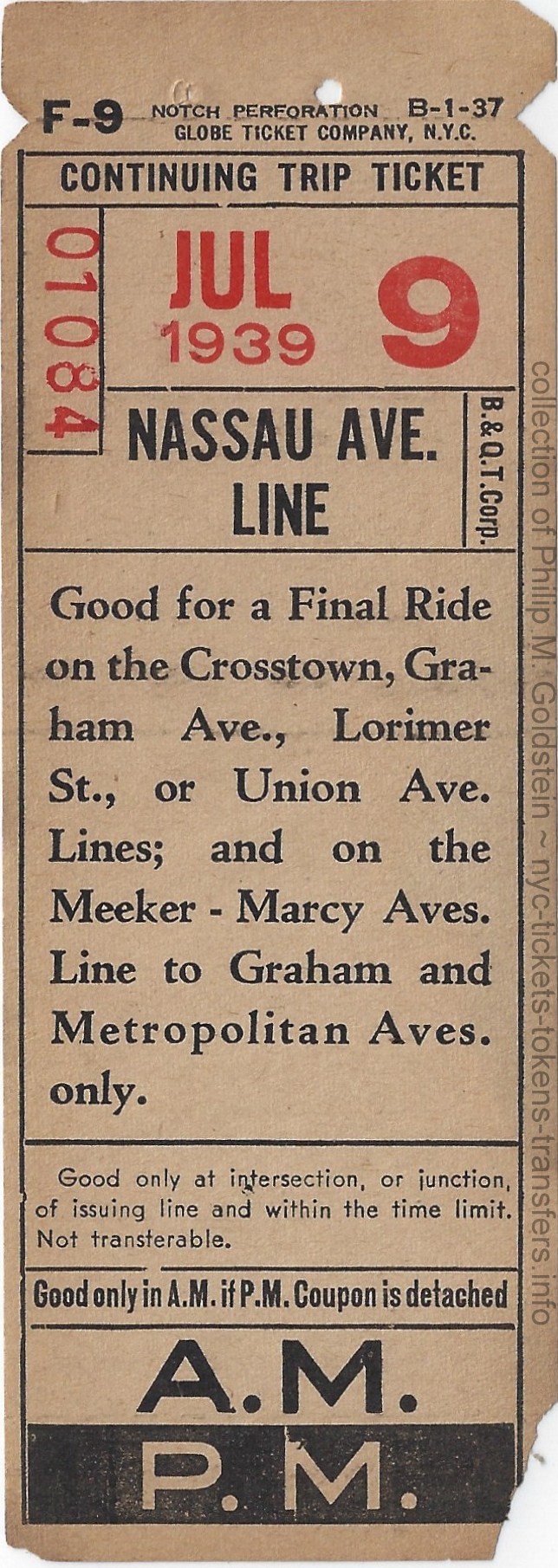 |
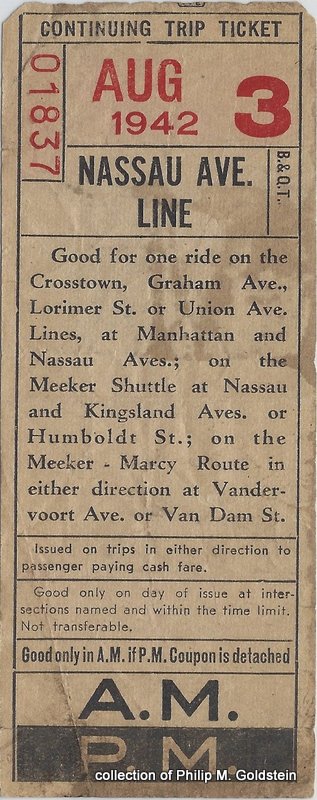 |
| F-9 (buff) B-1-37 Continuing Trip Ticket Brooklyn & Queens Transit Corp. |
(buff) Aug 3, 1942 Continuing Trip Ticket Brooklyn & Queens Transit |
New Lots Avenue Line September 1, 1947 |
|
 |
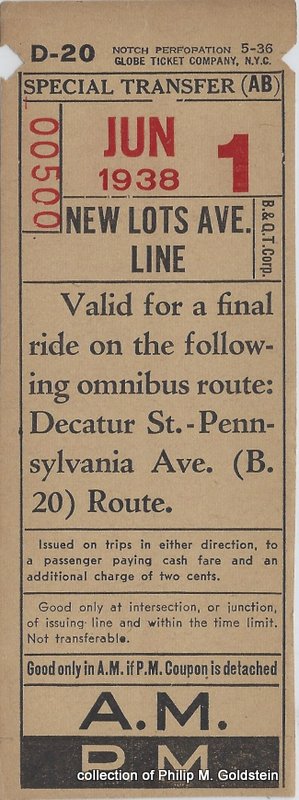 |
| D-11 (buff) F-4-38 Continuing Trip Ticket Brooklyn & Queens Transit Corp. |
D-20 (buff) 5-36 Special Transfer (AB) Brooklyn & Queens Transit Corp. |
Ralph Avenue Line November 1, 1943 |
|
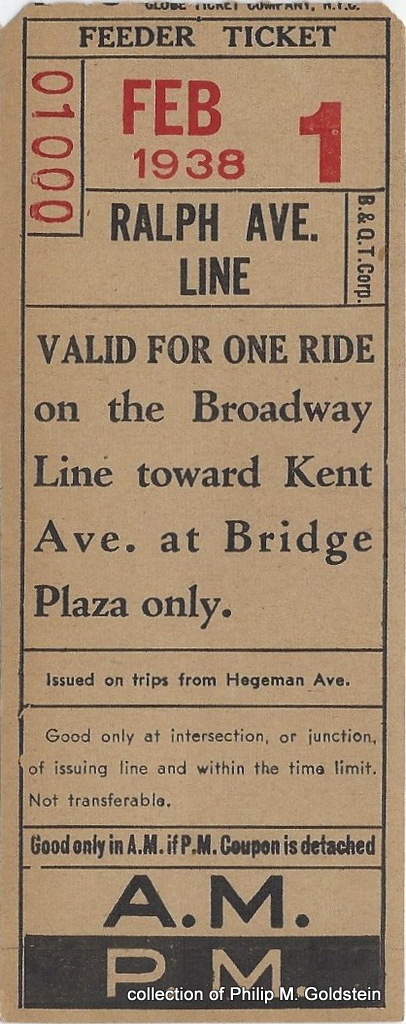 |
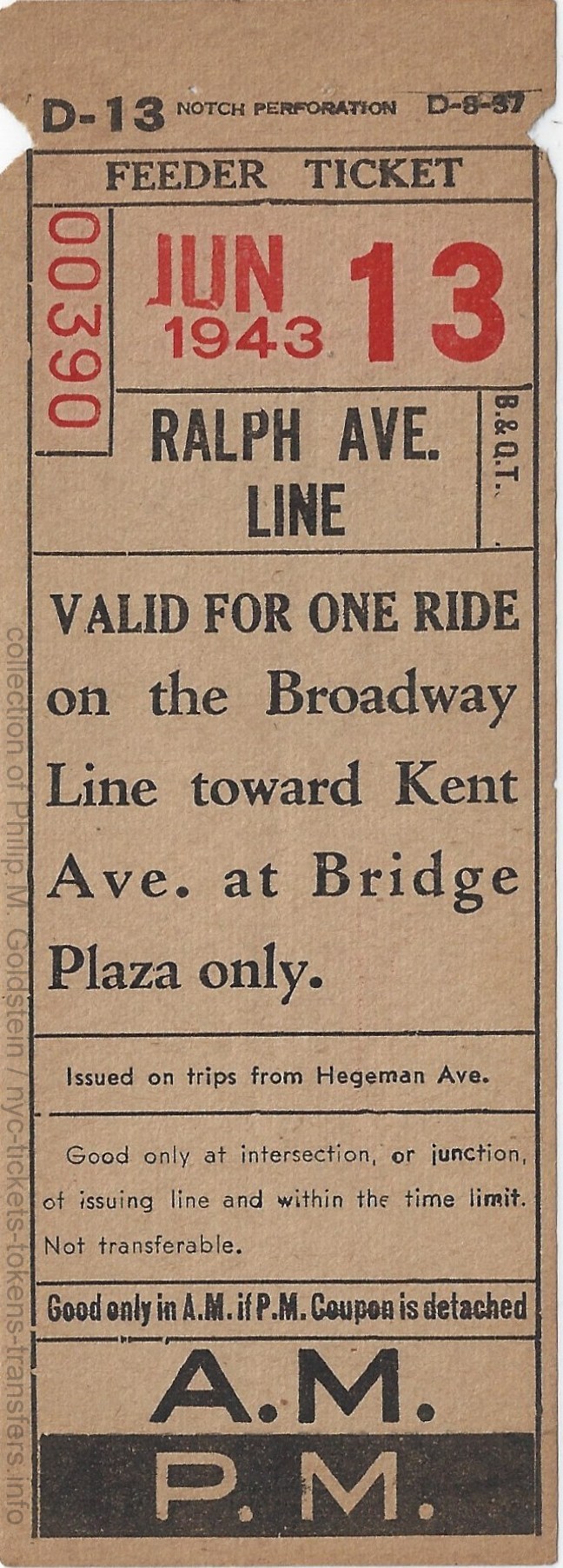 |
| (buff) Feb 1, 1938 Feeder Ticket from Hegeman Ave Brooklyn & Queens Transit Corp. |
D-13 (buff) D-8-37 Feeder Ticket from Hegeman Ave Brooklyn & Queens Transit |
Station No. 1 |
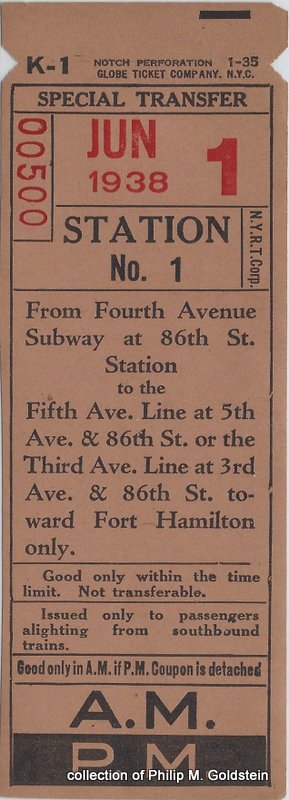 |
| K-1 (salmon) 1-35 Special Transfer Station No. 1 is Fourth Avenue Subway at 86th Street New York Rapid Transit Corp. |
Station No. 2 |
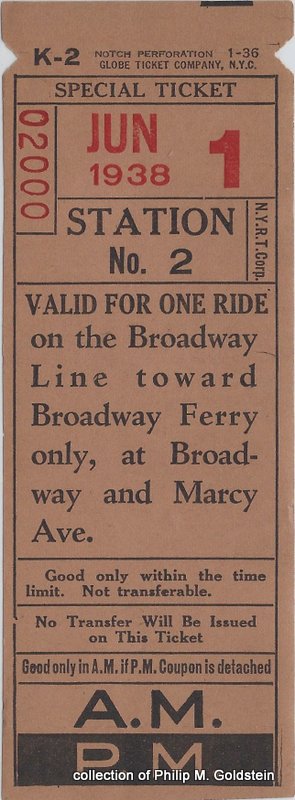 |
| K-2 (salmon) 1-35 Special Ticket Station No. 2 was the Broadway Ferry spur south of the Williamsburgh Bridge New York Rapid Transit Corp. |
Sumner - Sackett Line (date?) |
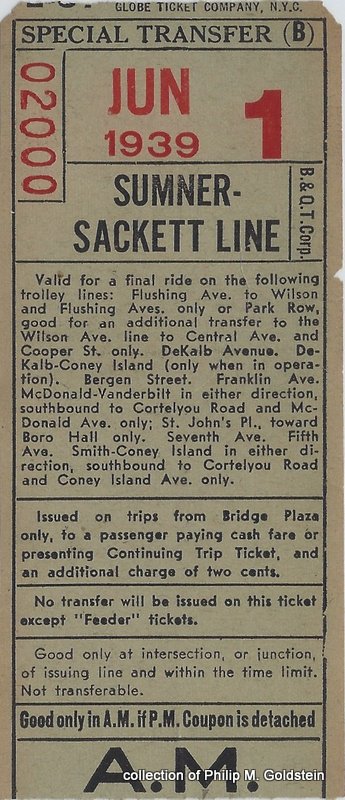 |
| (green) Jun 1, 1939 Special Transfer (B) from Bridge Plaza Brooklyn & Queens Transit Corp. |
Union Avenue Line December 1, 1945 |
|
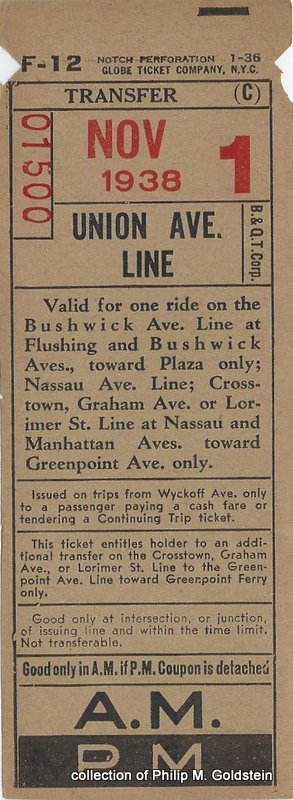 |
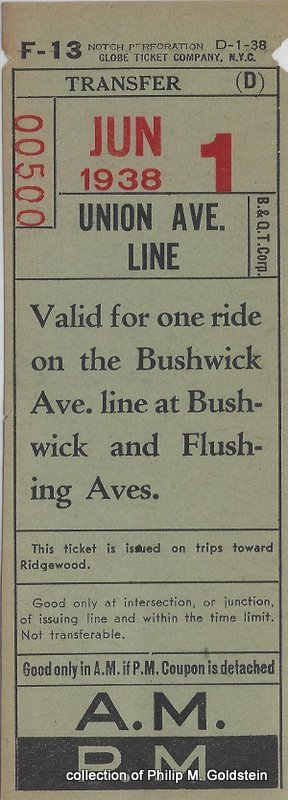 |
| F-12 (buff) 1-36 Transfer (C) from Wyckoff Ave Brooklyn & Queens Transit Corp. |
F-13 (green) D-1-38 Transfer (D) toward Ridgewood Brooklyn & Queens Transit Corp. |
| Third Avenue Railway System, pre-1937 (Henry Hudson Parkway not shown) trolley lines only. Click on the map for large format high resolution file (use your back arrow to return you here.) |
Third Avenue Railway, dated February 23, 1943; showing buses and trolleys (lines colorized by author): Click on the map for large format high resolution file (use your back arrow to return you here.)
|
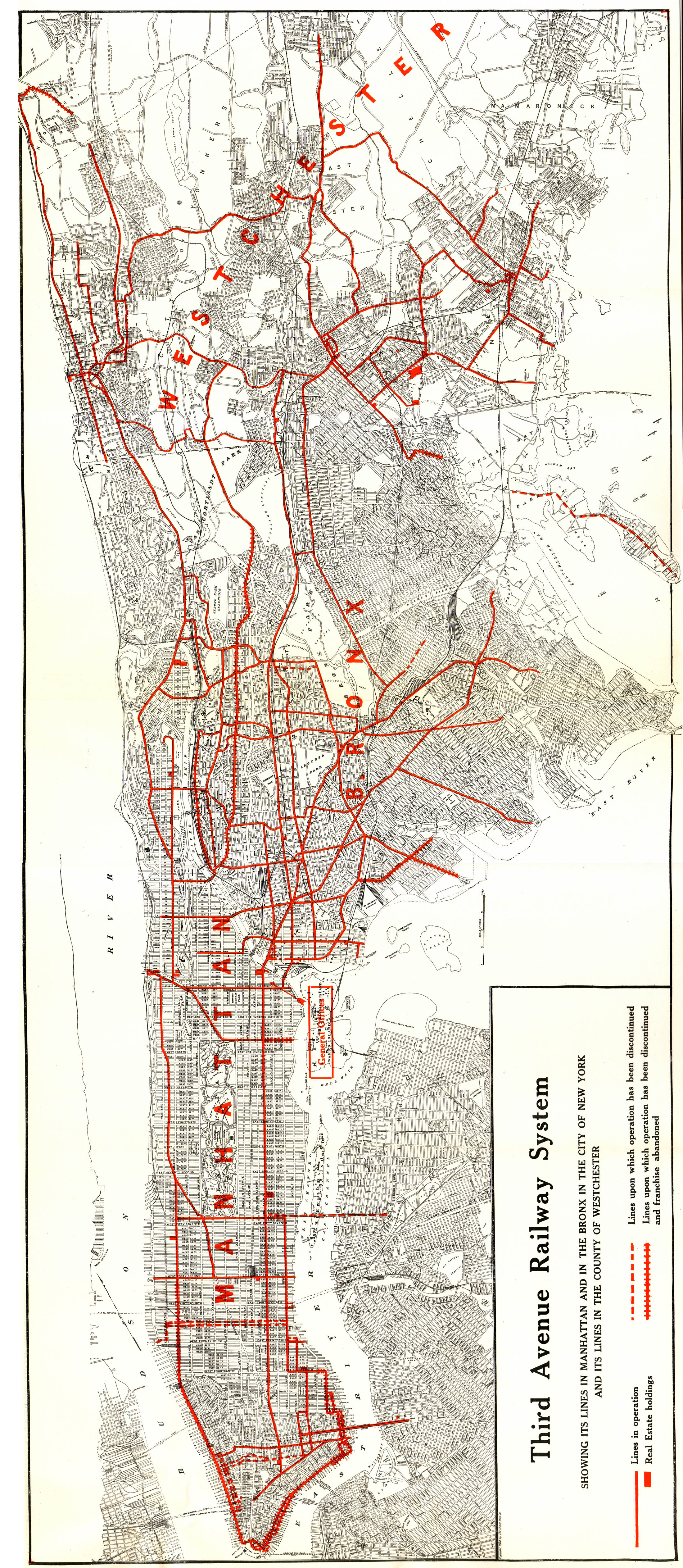 |
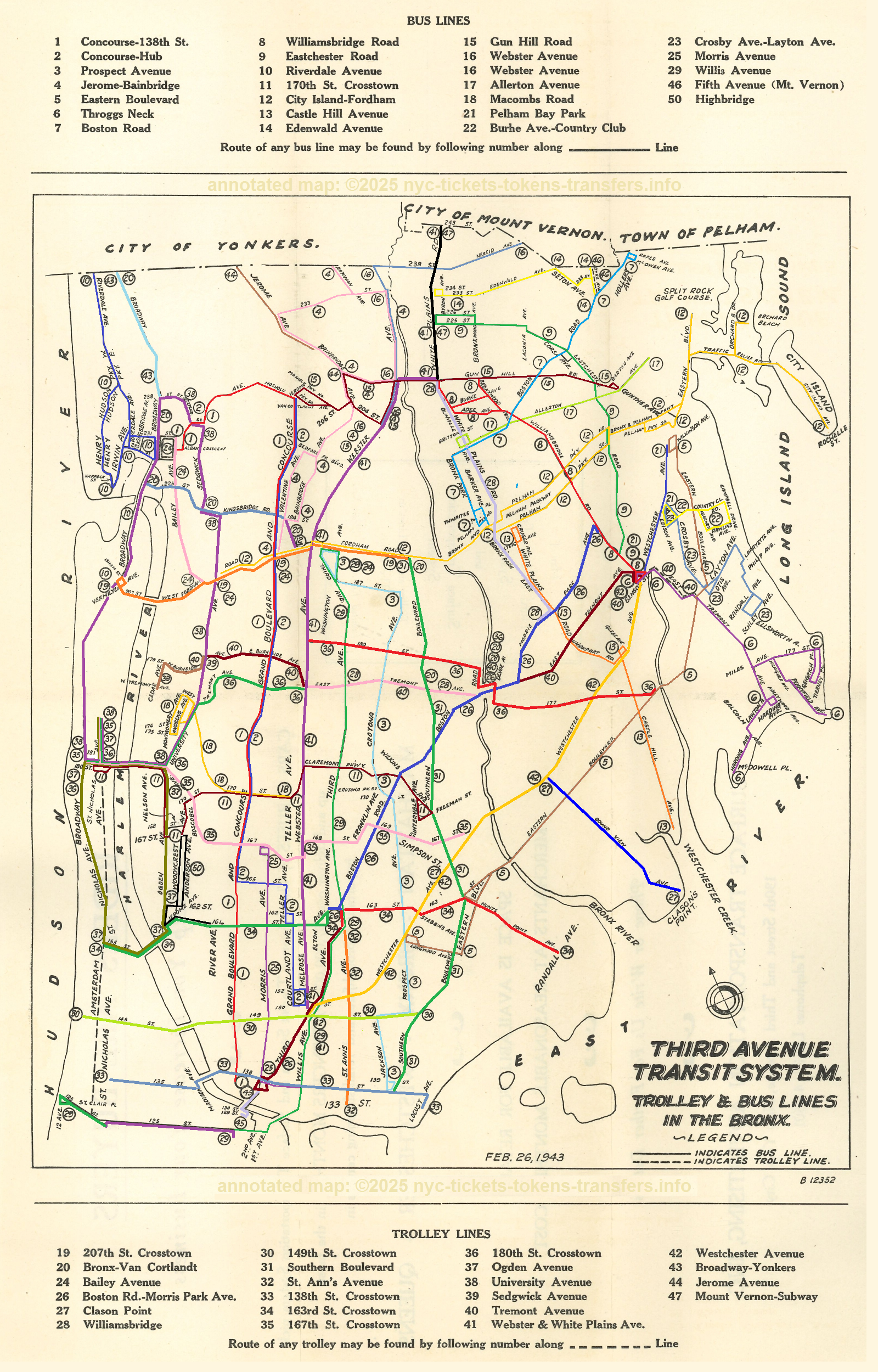 |
Bronx Lines |
||
| Conductor's Check | Third Avenue Railway Emergency Tickets | |
| Bailey Avenue | Ogden Avenue | 125th Street Crosstown |
| Boston Road | St Ann's Avenue | 138th Street Crosstown |
| Bronx River | Southern Boulevard | 149th Street Crosstown |
| Bronx & Van Cortlandt Park | Tremont Avenue | 163rd Street Crosstown |
| Clason Point | University Avenue | 167th Street |
| Kingsbridge | Westchester Avenue | 180th Street |
| Mainline: Webster Avenue & White Plains Road | Williamsbridge | 207th Street |
| Morris Avenue | Willis Avenue | |
| Morris Park Avenue | ||
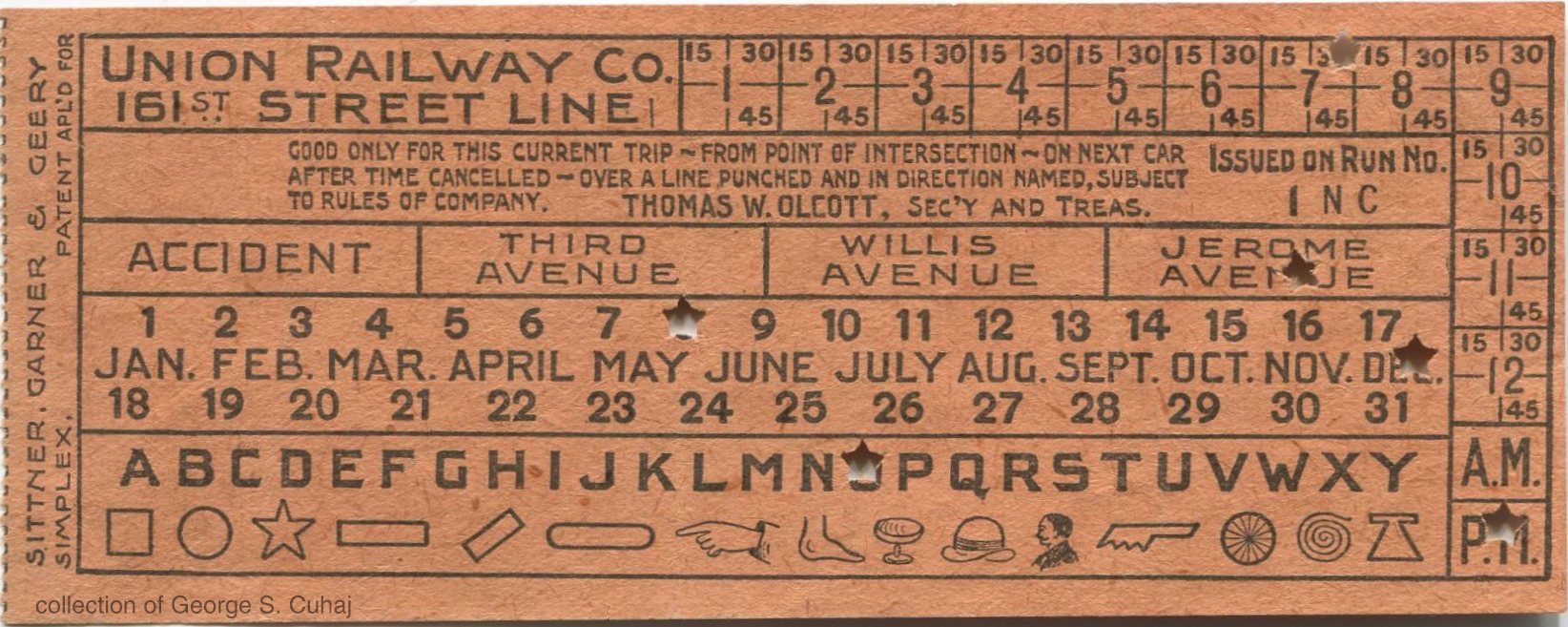 Sittner, Garner & Geery - Simplex; very unusual Thomas W. Olcott, Secretary & Treasurer 4 15/16" x 2" uncommon; issue above $7.00 - $10.00 each |
Bailey Avenue Line |
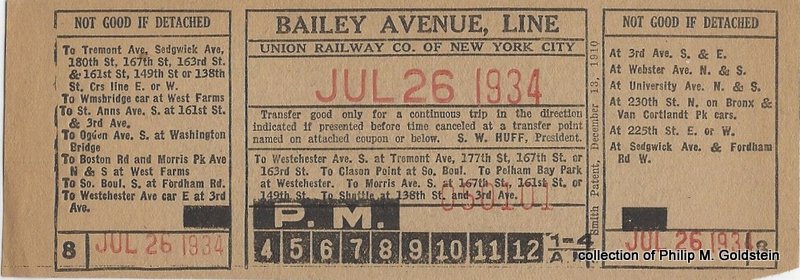 |
| (direction not specified) - PM hour punch - July 26, 1934 (buff) Union Railway Co. of New York City S. W Huff, president Smith Patent |
Boston Road |
|
 |
|
| South - hour punch, PM tab - April 12, 1914 (salmon) Union Railway Co. of New York City F. W. Whitridge, president Globe Ticket |
|
| intentionally left blank | 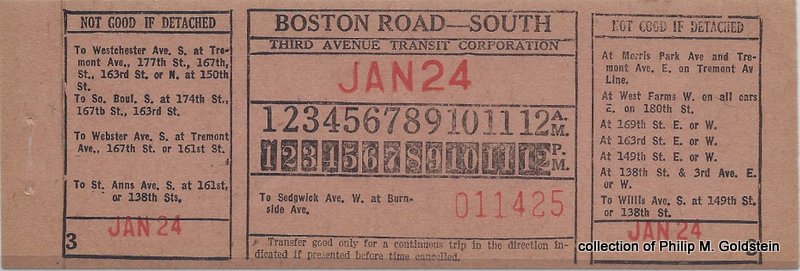 |
| South - hour punch AM/PM - January 24 Third Avenue Transit Corporation no patent |
|
| . | |
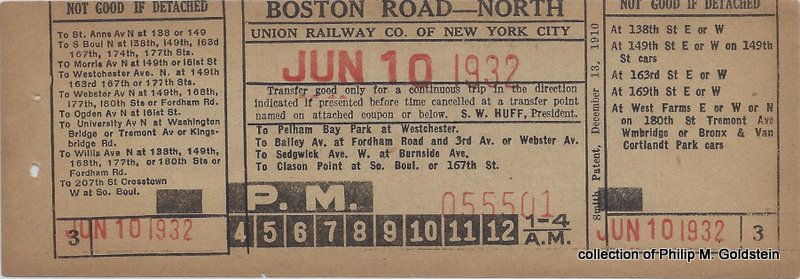 |
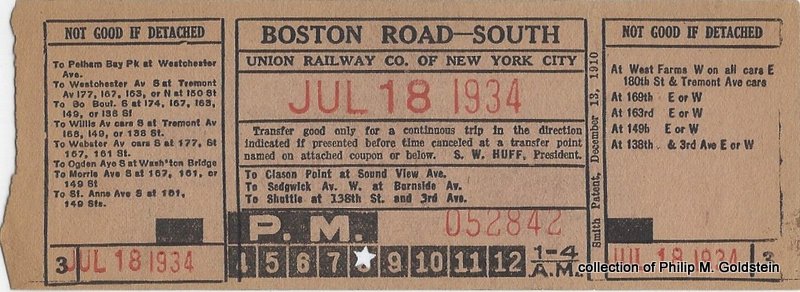 |
| North - hour punch PM (green) - June 10, 1932 Union Railway Co of New York City S. W Huff, president Smith Patent |
South - hour punch PM (buff) - July 18, 1934 Union Railway Co of New York City S. W Huff, president Smith Patent |
| . | |
| intentionally left blank |  |
| South - hour punch PM (salmon) - November 1, 1935 Union Railway Co of New York City S. W Huff, president (no patent) |
|
Bronx River |
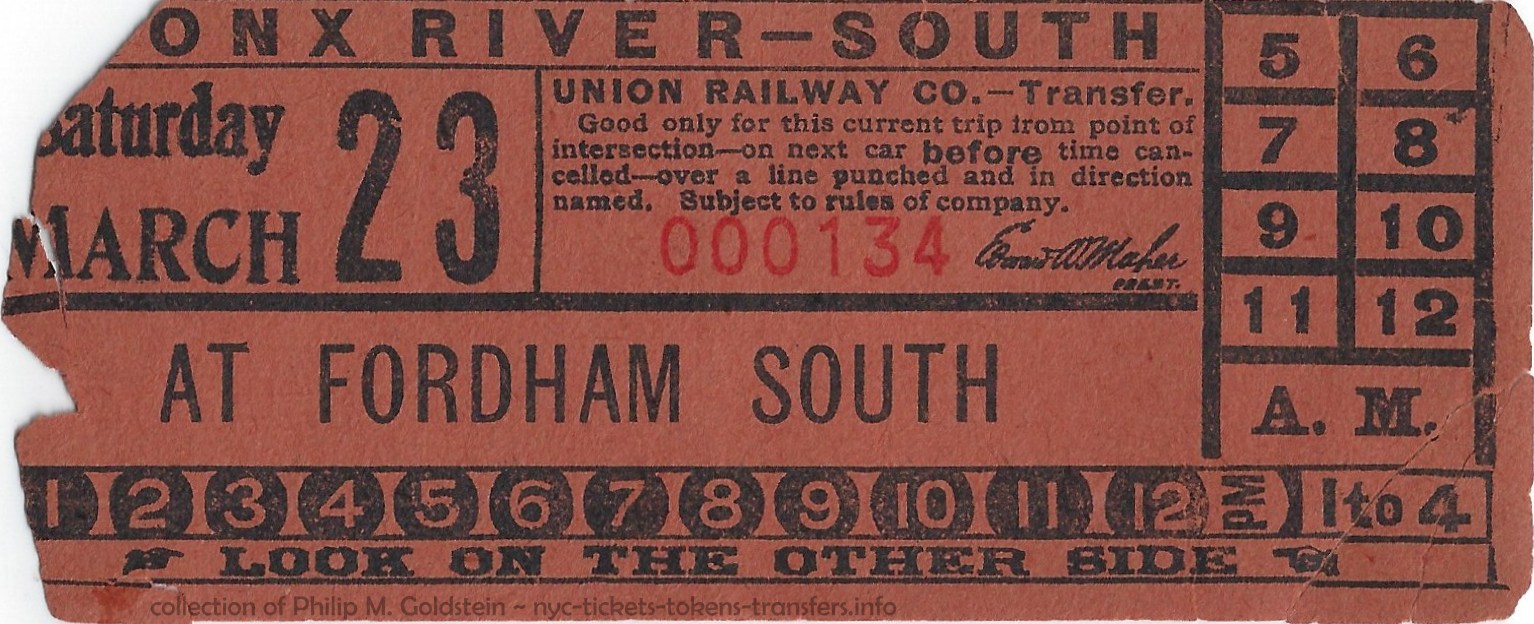 |
| South - am/pm hour punch - March 23, 1907 (orange) Union Railway Co. of New York City Edward A. Maher, president Globe Ticket |
Bronx & Van Cortlandt Park Line |
|
| intentionally left blank | 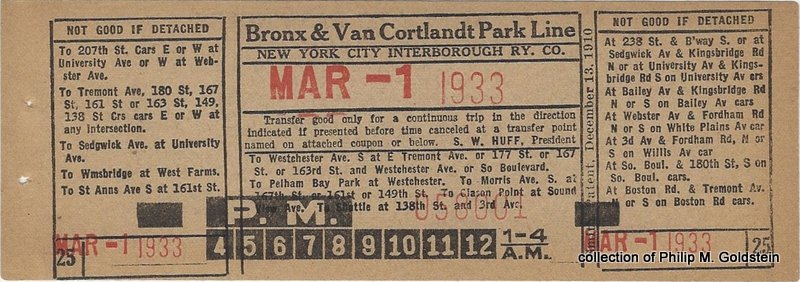 |
| direction not specified (southbound) - hour punch PM (buff) - March 1, 1933 New York City Interborough Railway Co. S. W Huff, president Smith Patent |
|
| . | |
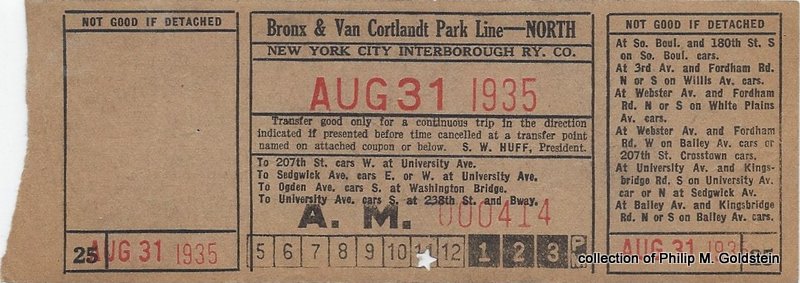 |
intentionally left blank |
| North - hour punch AM (buff) - August 31, 1935 New York City Interborough Railway Co. S. W Huff, president (no patent) |
|
| . | |
 |
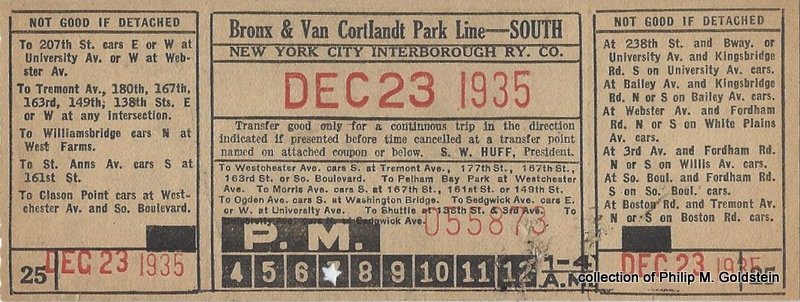 |
| North - hour punch AM (purple) - March 6, 1942 New York City Interborough Railway Co. S. W Huff, president (no patent) |
South - hour punch PM (buff) - December 23, 1935 New York City Interborough Railway Co. S. W Huff, president (no patent) |
| . | |
 |
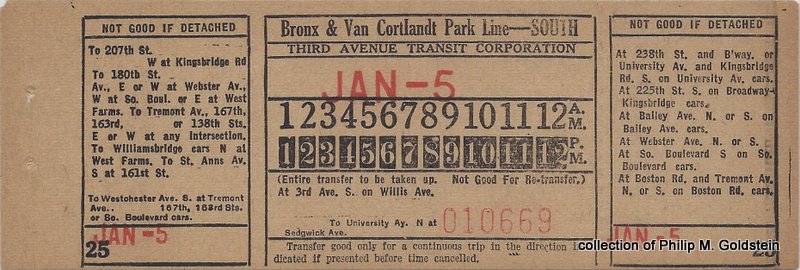 |
| North - hour punch AM/PM (buff) - November 3, 1944 Third Avenue Transit Corp S. W Huff, president (no patent) |
South - hour punch AM/PM (buff) - January 5 Third Avenue Transit Corp (no patent) |
Clason Point Line |
|
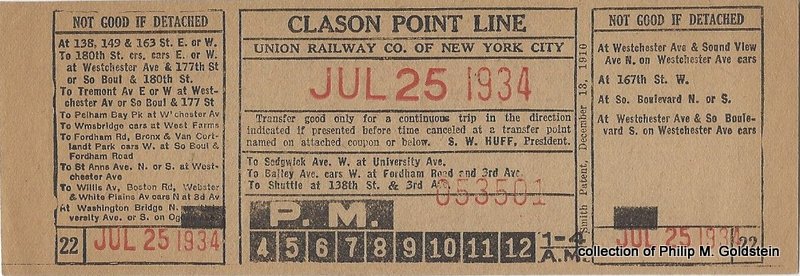 |
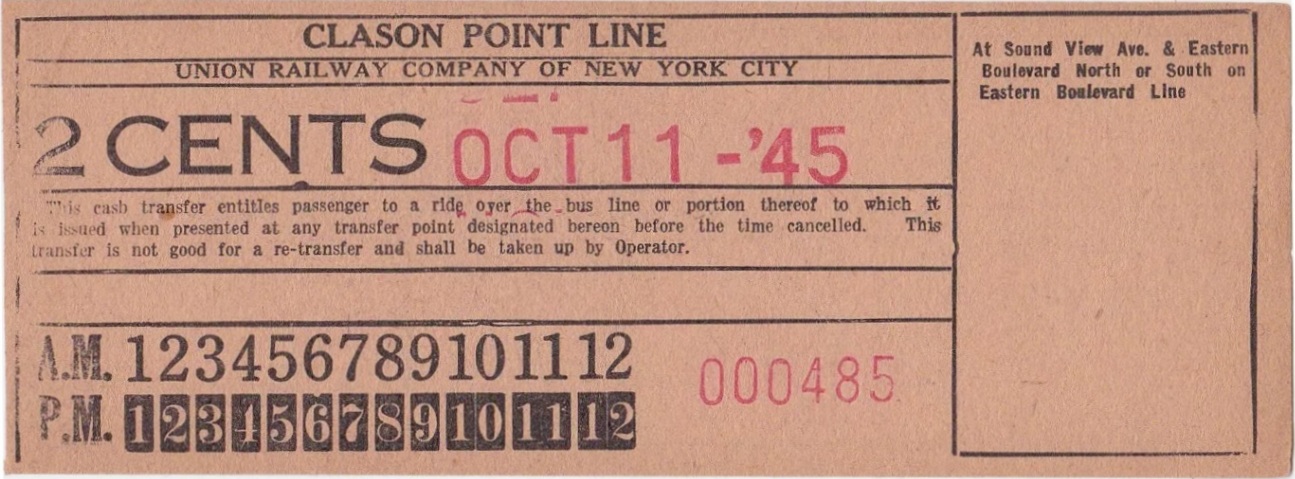 |
| (direction not specified) - hour punch PM (buff) - July 25, 1934 Union Railway Co of New York City S. W Huff, president Smith Patent |
2 Cents (direction not specified) - hour punch AM/PM (pink) - October 11, 1945 Union Railway Co of New York City Smith Patent |
Kingsbridge line |
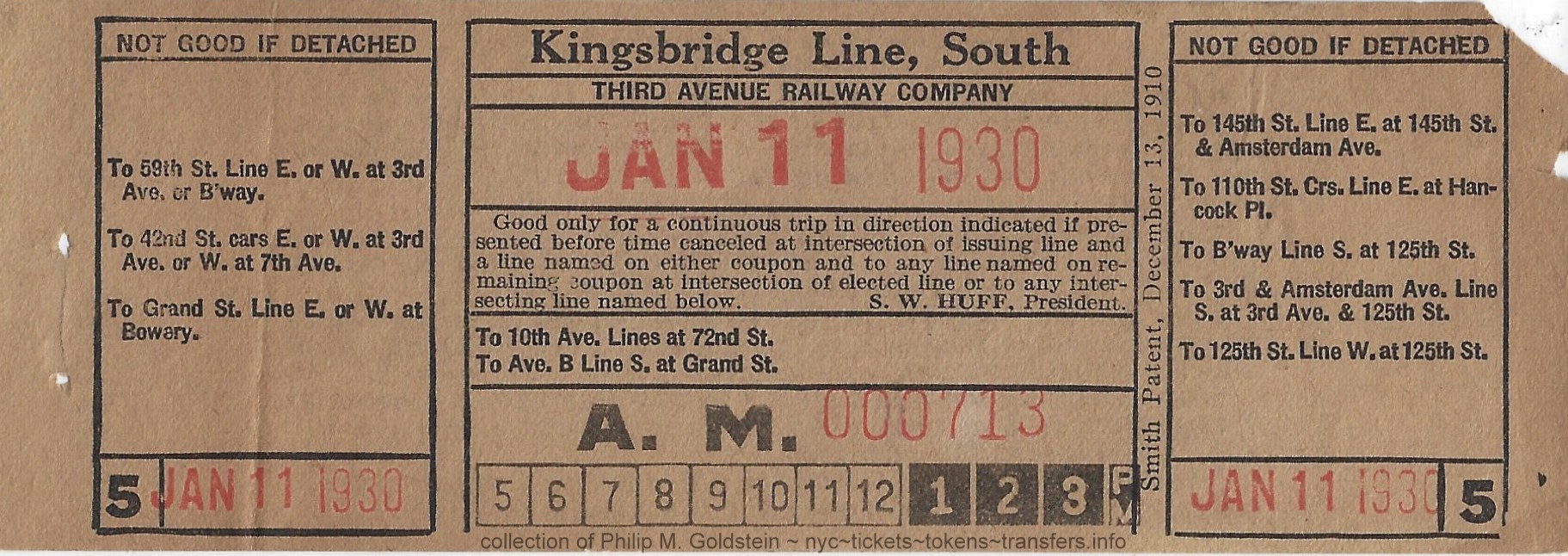 |
| South - hour punch AM (buff) - January 11, 1930 Third Avenue Railway S. W Huff, president Smith Patent |
Main Line - Webster Avenue & White Plains Road |
|
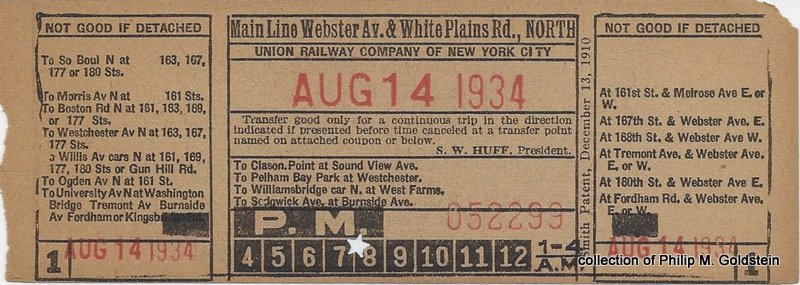 |
intentionally left blank |
| North - hour punch PM (buff) - August 14, 1934 Union Railway Co. of New York City (sans-serif) S. W Huff, president Smith Patent |
|
| . | |
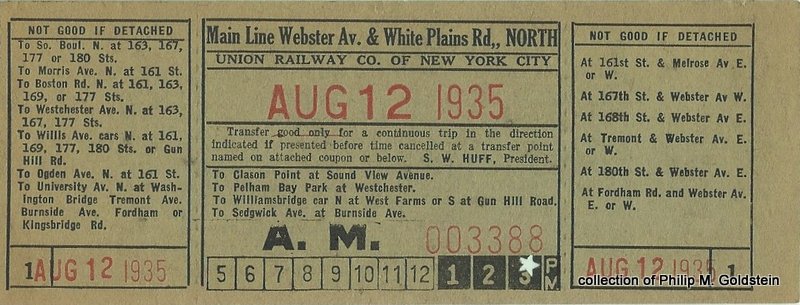 |
intentionally left blank |
| North - hour punch AM (green) - August 12, 1935 Union Railway Co. of New York City (serif) S. W Huff, president (no patent) |
|
| . | |
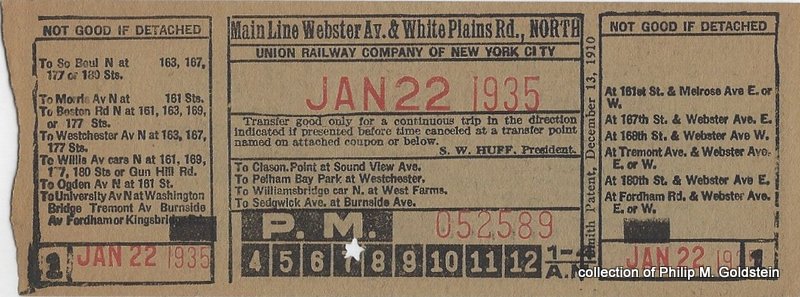 |
intentionally left blank |
| North - hour punch PM (buff) - January 22, 1935 Union Railway Co. of New York City (sans-serif) S. W Huff, president Smith Patent |
|
| . | |
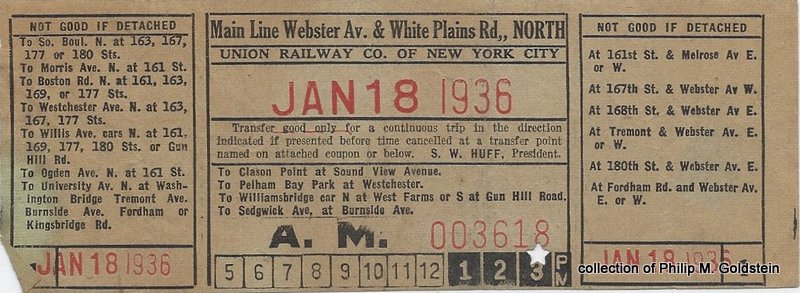 |
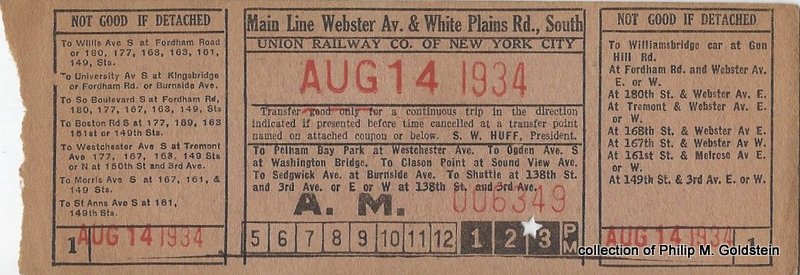 |
| North - hour punch AM (buff) - January 18, 1936 Union Railway Co. of New York City (serif) S. W Huff, president (no patent) |
South - hour punch AM (pink) Union Railway Co. of New York City S. W Huff, president (no patent) |
| . | |
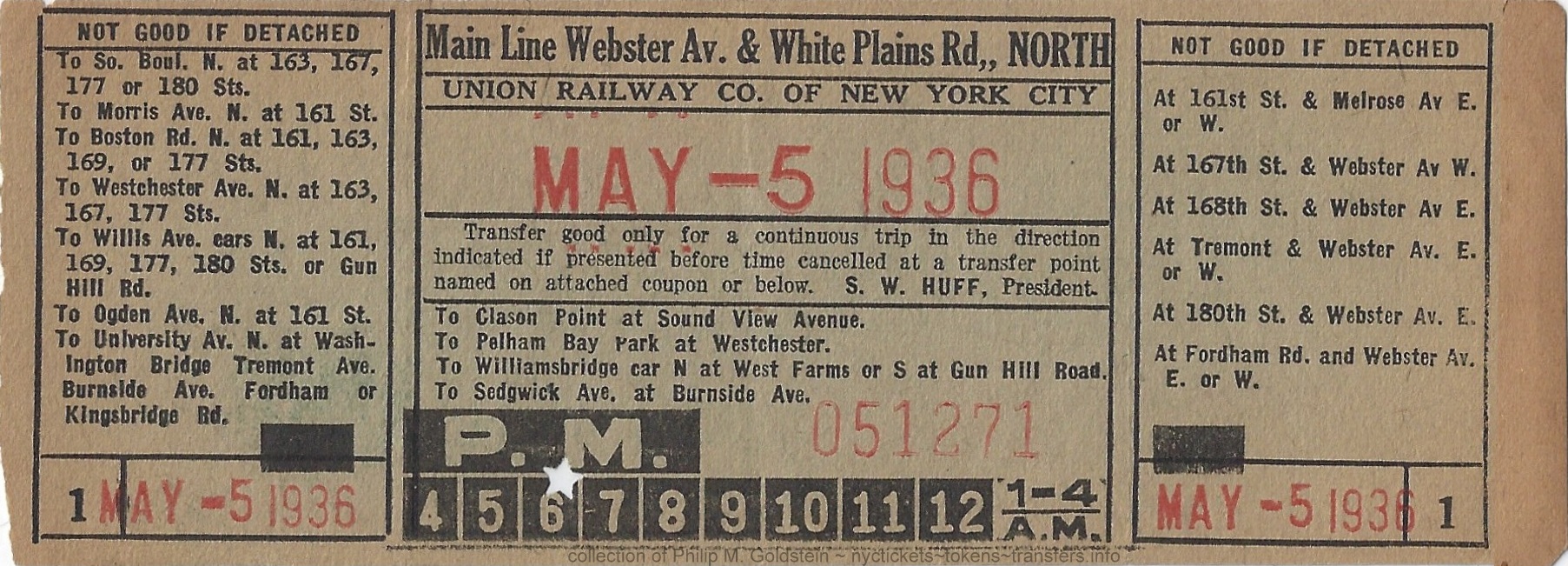 |
intentionally left blank |
| North - hour punch PM (green) - May 5, 1936 Union Railway Co. of New York City (serif) S. W Huff, president (no patent) |
|
Morris Avenue |
|
| intentionally left blank | 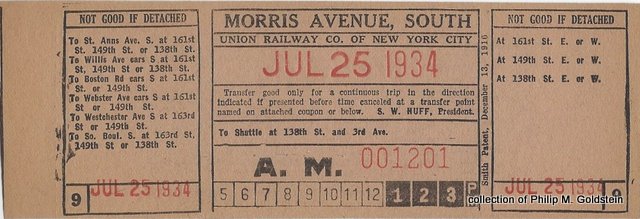 |
| South - hour punch AM (buff) - July 25, 1934 Union Railway Co. of New York City S. W Huff, president Smith Patent |
|
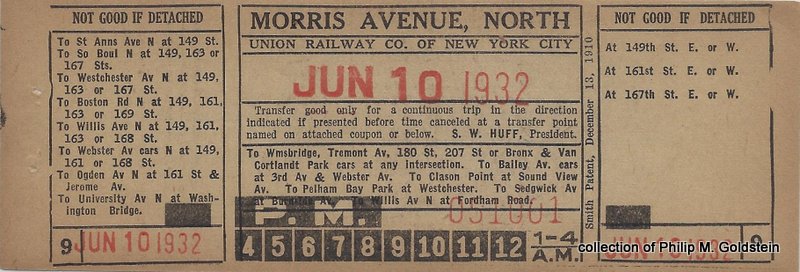 |
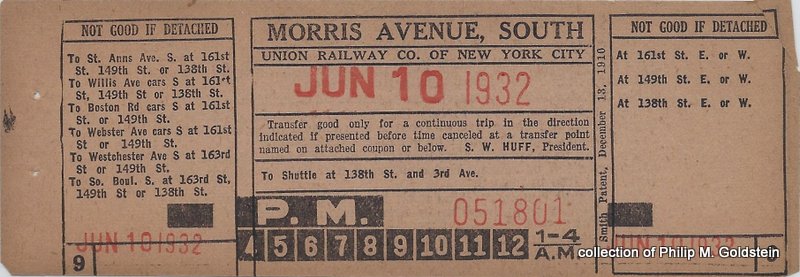 |
| North - hour punch PM (buff) - June 10, 1932 Union Railway Co. of New York City S. W Huff, president Smith Patent |
South - hour punch PM (pink) - June 10, 1932 Union Railway Co. of New York City S. W Huff, president Smith Patent |
Morris Park Avenue |
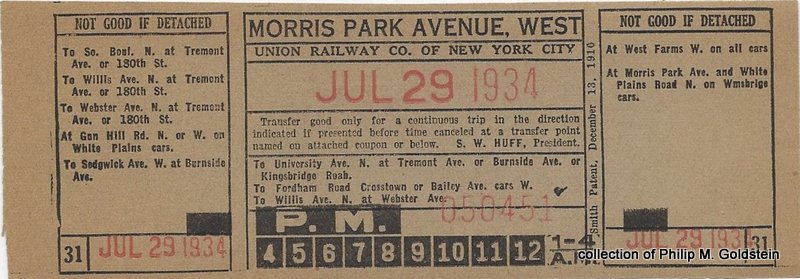 |
| West - hour punch PM (buff) - July 29, 1934 Union Railway Co. of New York City S. W Huff, president Smith Patent |
Ogden Avenue |
|
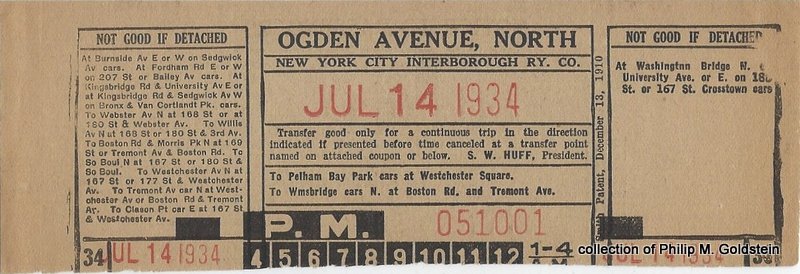 |
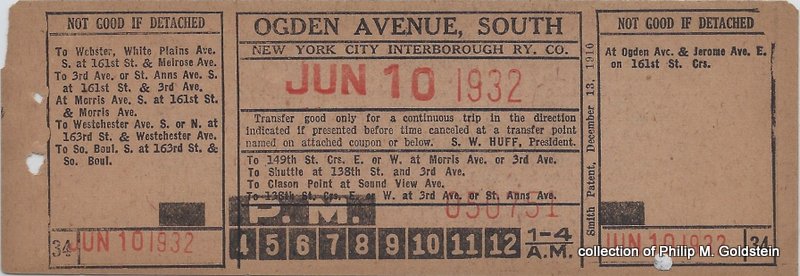 |
| North - hour punch PM (buff) - July 14, 1934 New York City Interborough Railway S. W Huff, president Smith Patent |
South - hour punch PM (pink) - June 10, 1932 New York City Interborough Railway S. W Huff, president Smith Patent |
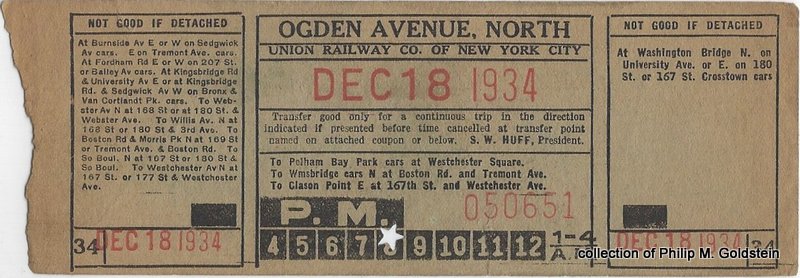 |
intentionally left blank |
| North - hour punch PM (green) - December 18, 1934 Union Railway of New York City S. W Huff, president (no patent) |
|
St. Anns Avenue |
|
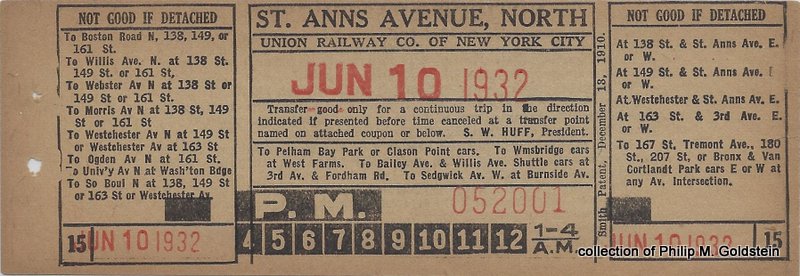 |
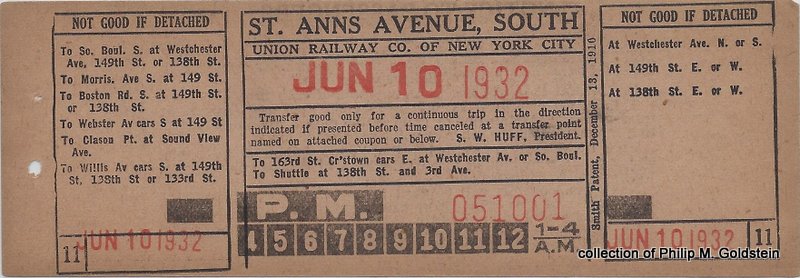 |
| North - hour punch PM (buff) - June 10, 1932 Union Railway of New York City S. W Huff, president Smith Patent |
South - hour punch PM (pink) - June 10, 1932 Union Railway of New York City S. W Huff, president Smith Patent |
Southern Boulevard |
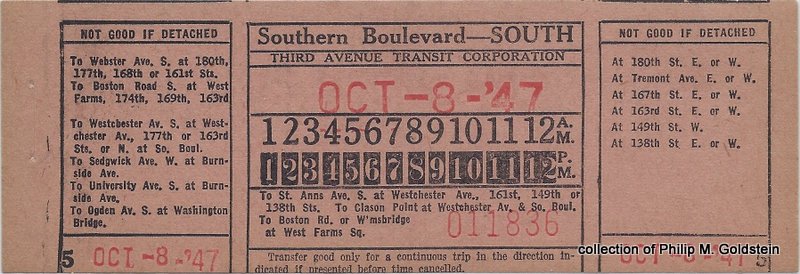 |
| South - hour punch AM/PM (pink) - October 8, 1947 Third Avenue Transit Corp (no patent) |
Tremont Avenue |
|
| intentionally left blank | 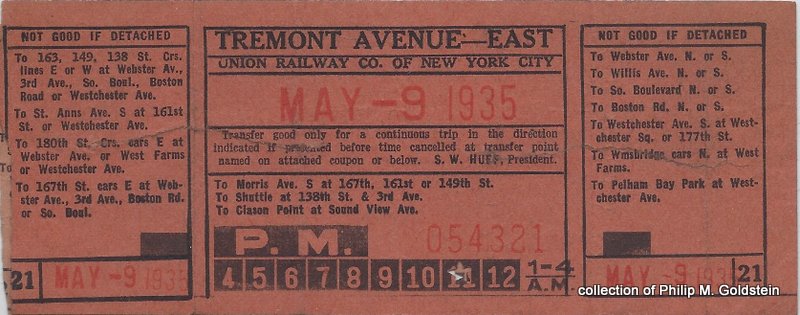 |
| East - hour punch PM (orange) - May 9, 1935 Union Railway of New York City S. W Huff, president (no patent) |
|
| . | |
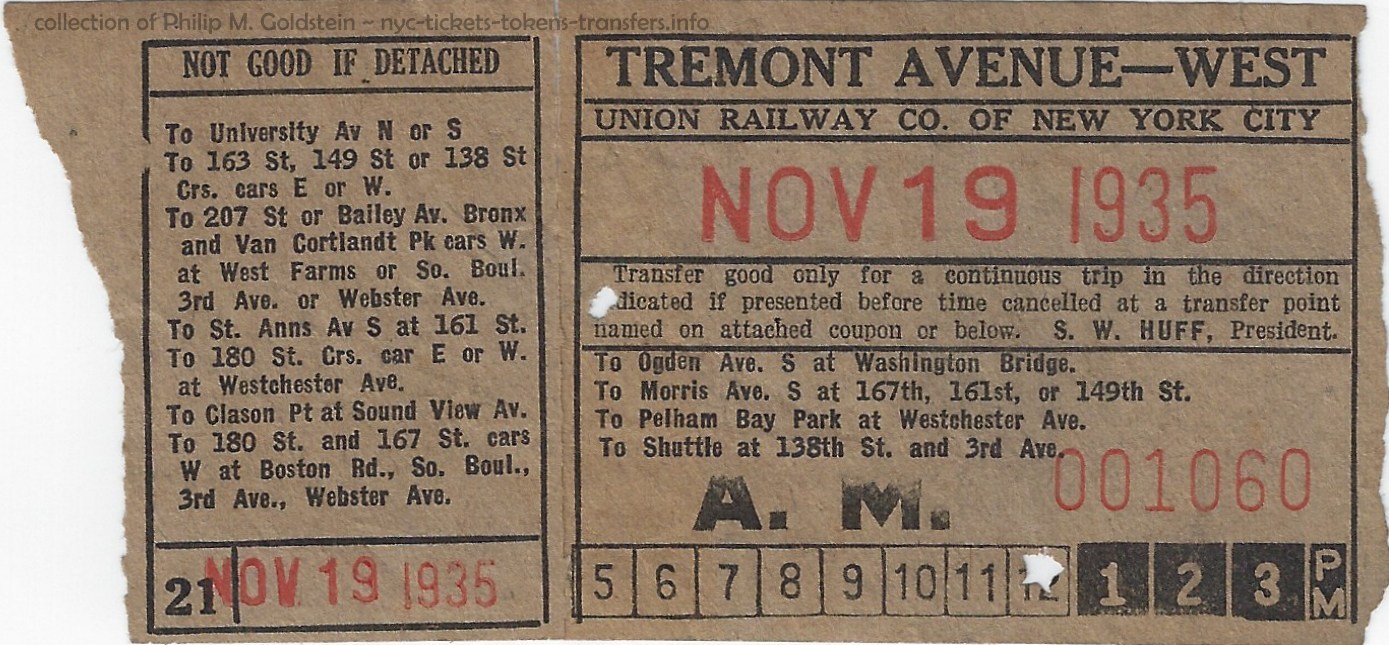 |
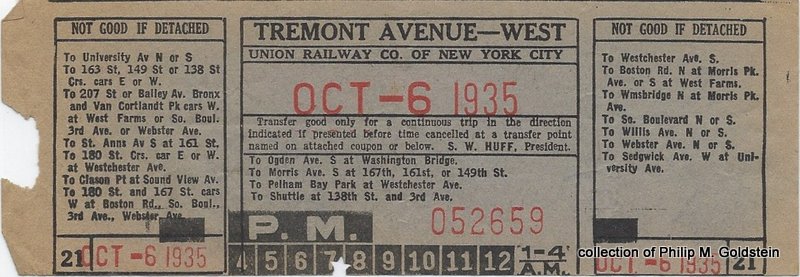 |
| West - hour punch AM (green?) - November 19, 1935 Union Railway of New York City S. W Huff, president (no patent) |
West - PM (purple) - October 6, 1935 Union Railway of New York City S. W Huff, president (no patent) |
University Avenue |
|
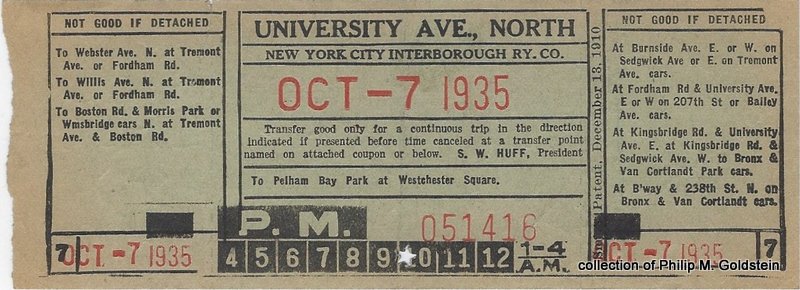 |
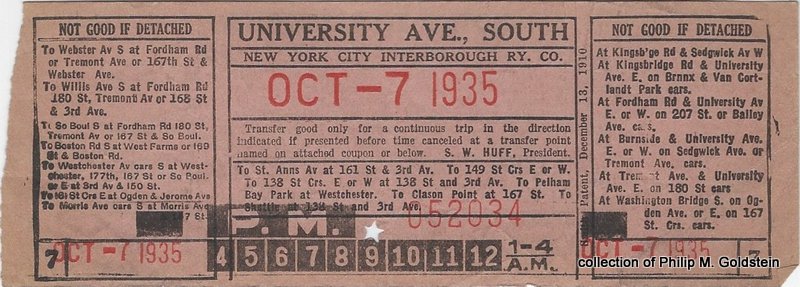 |
| North - hour punch PM (green) - October 7, 1935 New York City Interborough Railway S. W Huff, president Smith Patent |
North - hour punch PM (pink) - October 7, 1935 New York City Interborough Railway S. W Huff, president Smith Patent |
Westchester Avenue |
|
| intentionally left blank | 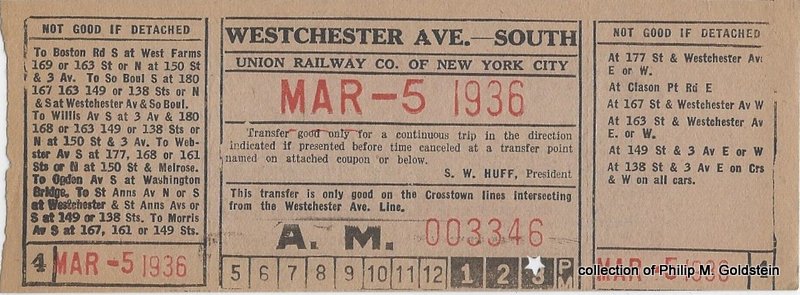 |
| South - hour punch AM (buff) - March 5, 1936 Union Railway of New York City S. W Huff, president (no patent) |
|
| . | |
 |
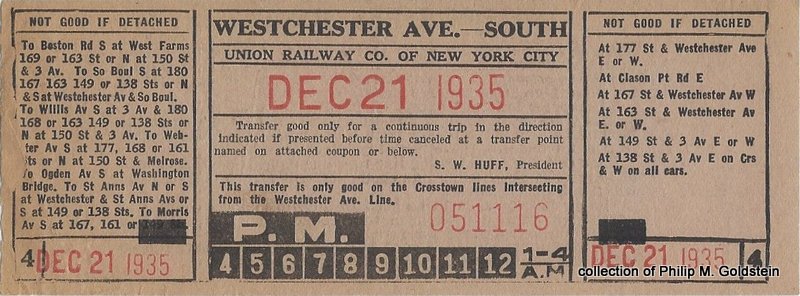 |
| North - hour punch PM (green) - December 24, 1935 Union Railway of New York City S. W Huff, president (no patent) |
South - hour punch PM (buff) - December 21, 1935 Union Railway of New York City S. W Huff, president (no patent) |
Williamsbridge Line |
|
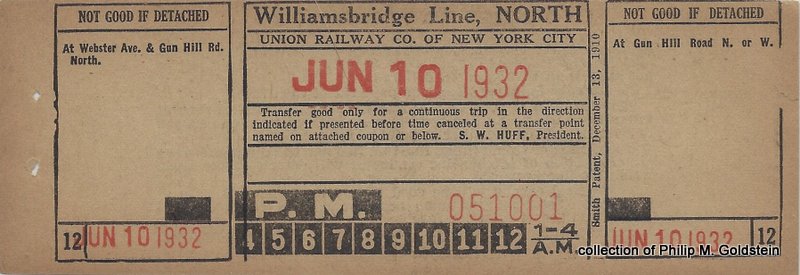 |
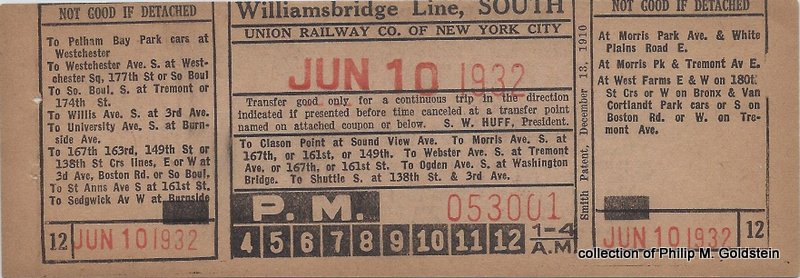 |
| North - hour punch PM (buff) - June 10, 1932 Union Railway of New York City S. W Huff, president Smith Patent |
North - hour punch PM (pink) - June 10, 1932 Union Railway of New York City S. W Huff, president Smith Patent |
| . | |
| intentionally left blank | 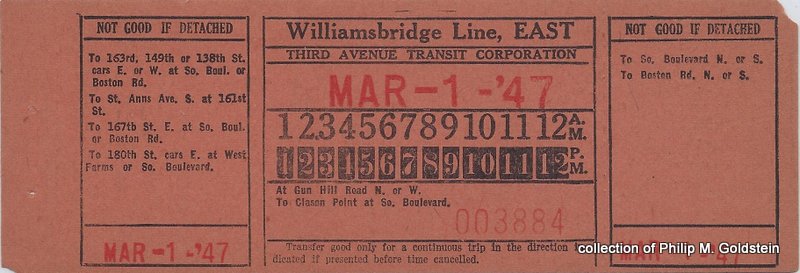 |
| East - hour punch AM/PM (orange) - March 1, 1947 Union Railway of New York City (no patent) |
|
Willis Avenue Line |
|
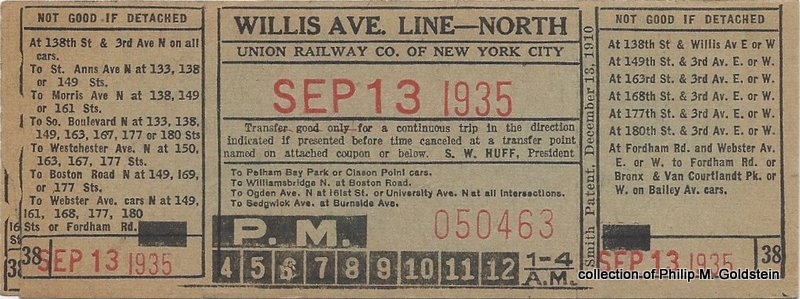 |
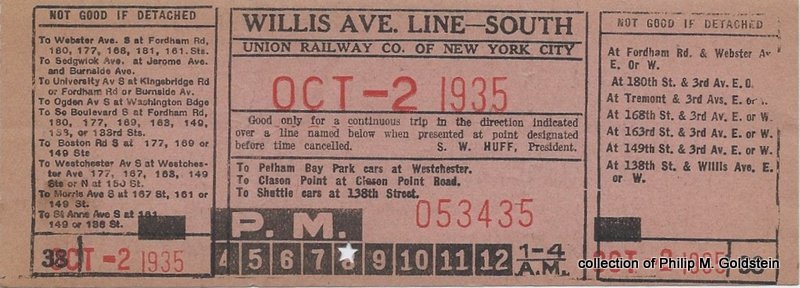 |
| North - hour punch PM (green) - September 13, 1935 Union Railway of New York City S. W Huff, president Smith Patent |
South - hour punch PM (pink) - October 2, 1935 Union Railway of New York City S. W Huff, president (no patent) |
125th Street Crosstown Line |
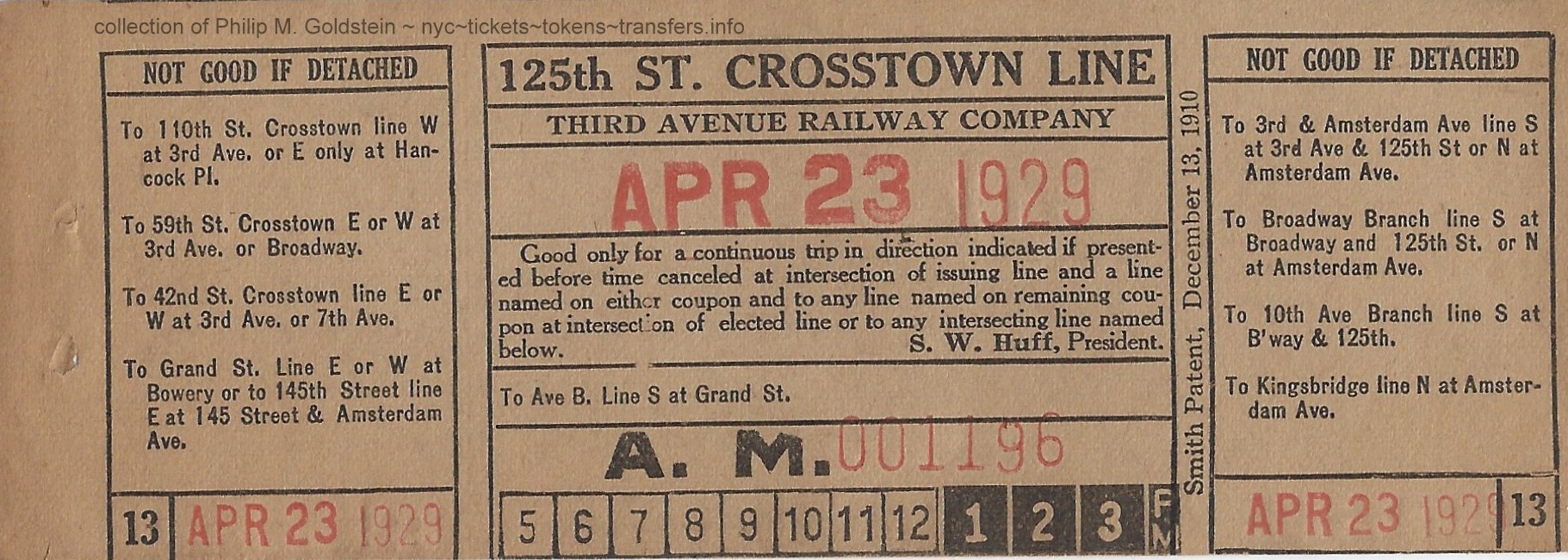 |
| (direction not specified) - hour punch AM (buff) - April 23, 1929 Third Avenue Railway S. W Huff, president Smith Patent |
| . |
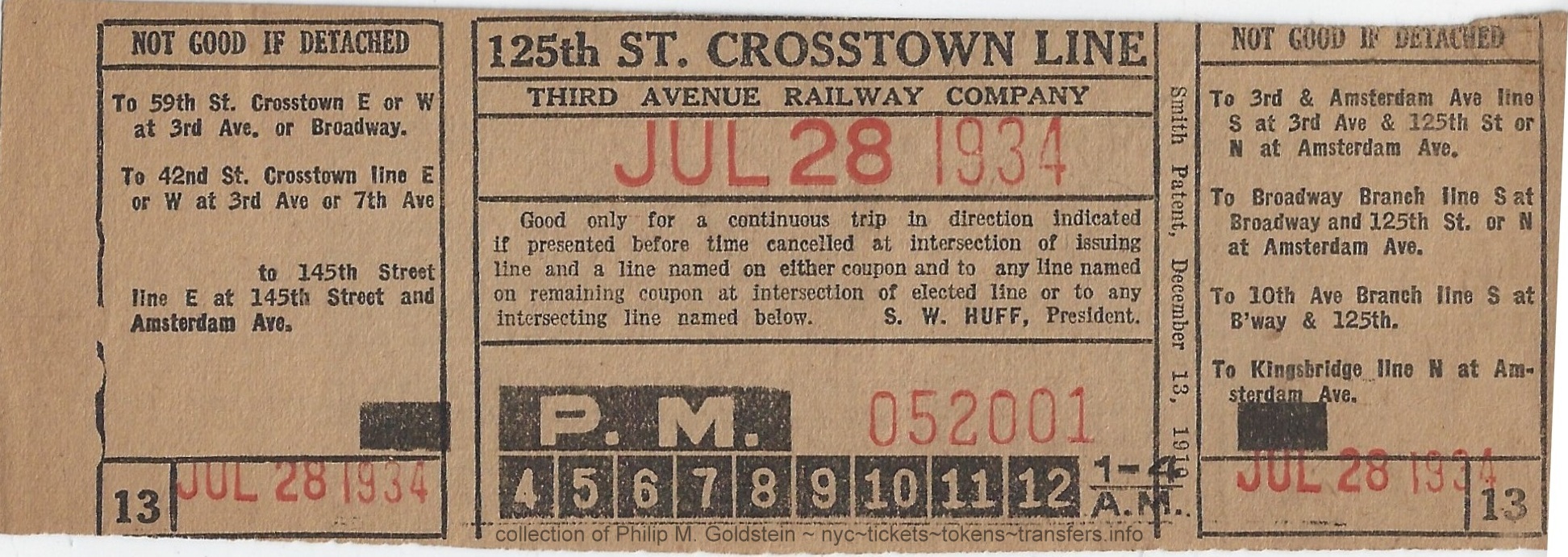 |
| (direction not specified) - hour punch PM (buff) - July 28, 1934 Third Avenue Railway S. W Huff, president Smith Patent |
138th Street Crosstown Line |
|
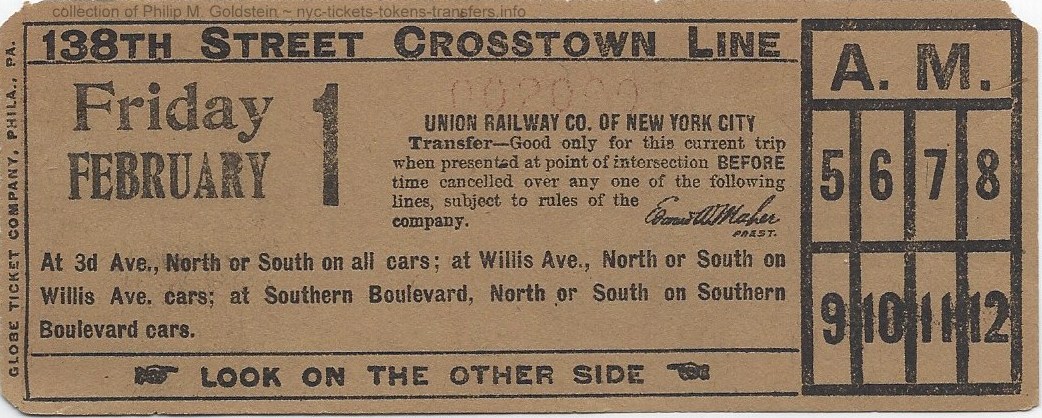 |
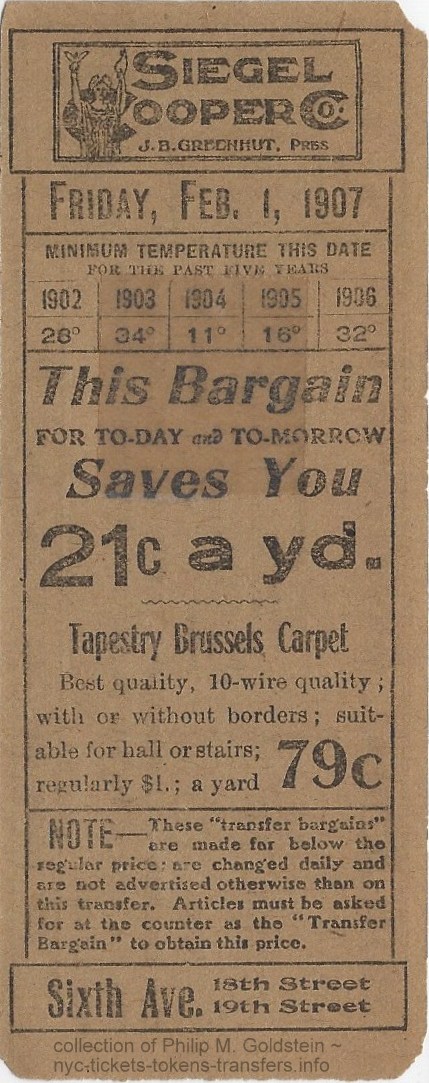 |
| (direction not specified) - hour punch AM (buff) - Friday, February 1, 1907 Union Railway of New York City Edward A. Maher, president Globe Ticket |
|
| . | |
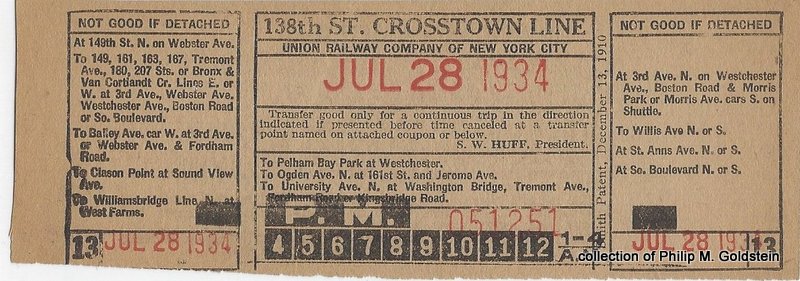 |
|
| (direction not specified) - hour punch PM (buff) - July 28, 1934 Union Railway of New York City S. W Huff, president Smith Patent |
|
149th Street Crosstown Line |
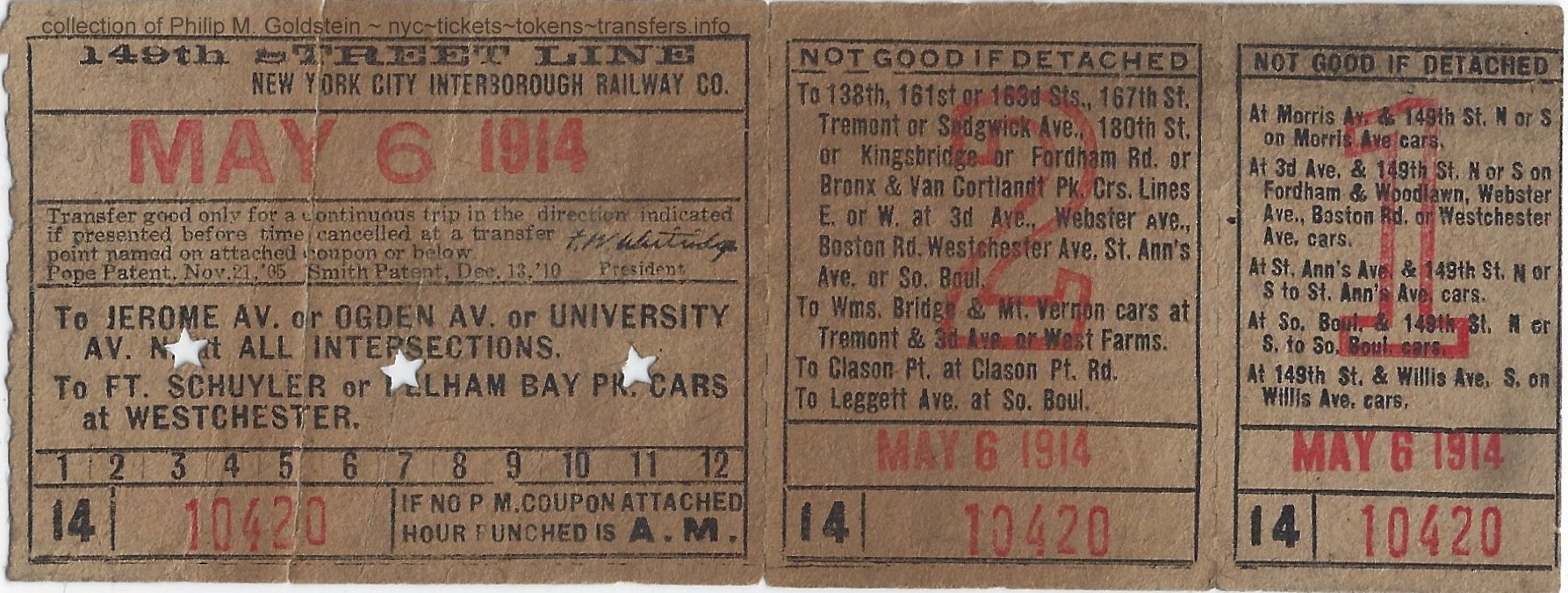 |
| (direction not specified) - May 6, 1914 (buff) hour punch PM stub New York City Interborough Railway F. W. Whitridge, president |
| . |
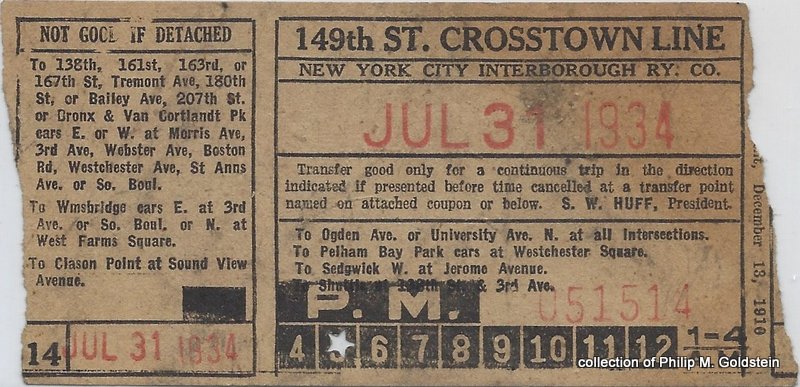 |
| (direction not specified) - hour punch PM (buff) - July 31, 1934 New York City Interborough Railway S. W Huff, president Smith Patent |
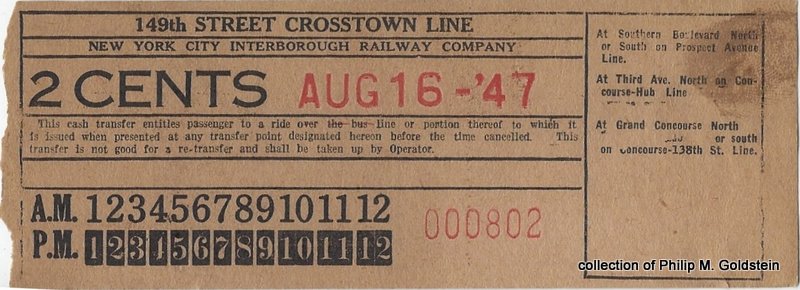 |
| 2 cents (direction not specified) - hour punch AM/PM (buff) - August 16, 1947 New York City Interborough Railway (no patent) |
163rd Street Crosstown Line |
|
 |
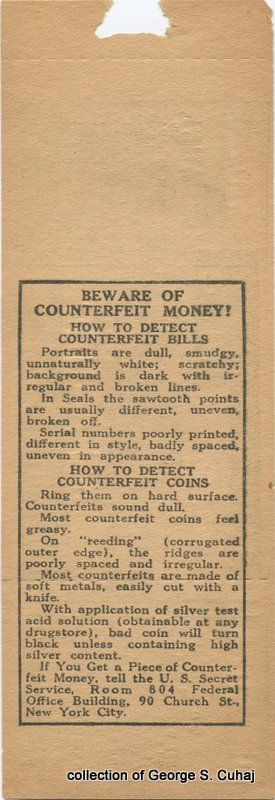 |
| (direction not specified) - hour punch PM (buff) - June 7, 1941 Union Railway of New York City S. W. Huff, president Smith Patent |
|
167th Street Line |
|
| intentionally left blank | 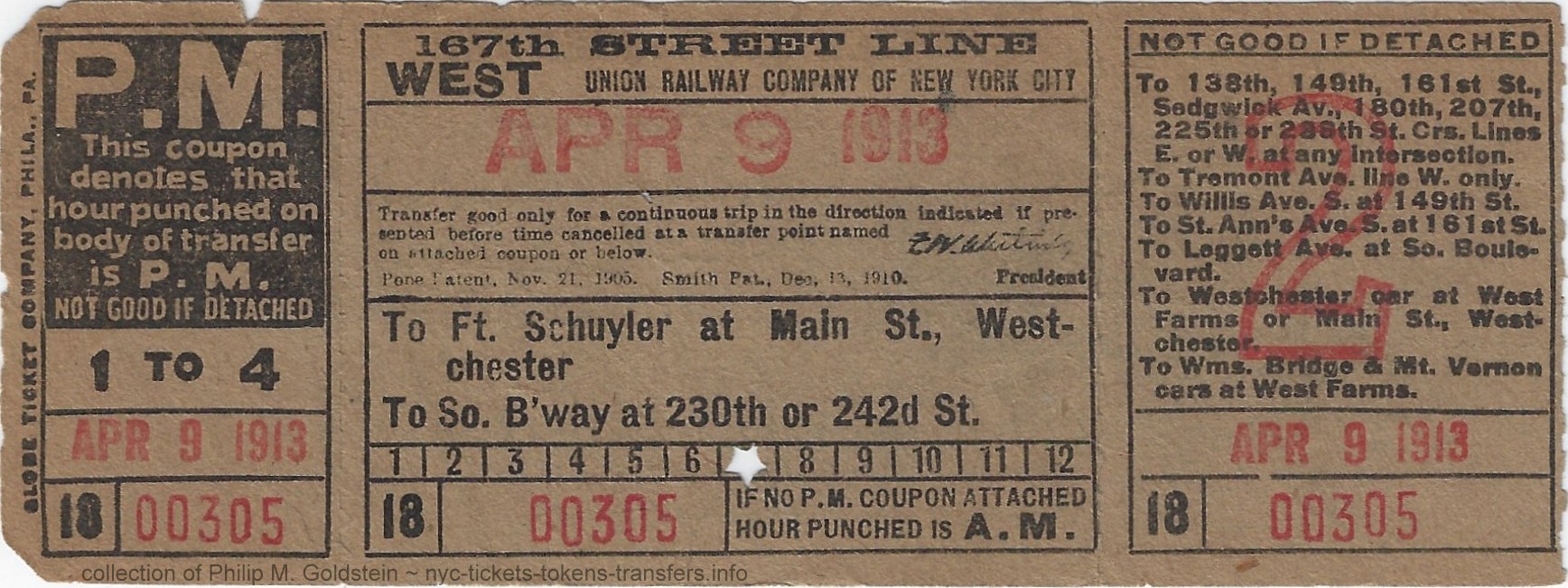 |
| West - hour punch PM tab (green?) - April 9, 1913 Union Railway of New York City F. W. Whitridge, president Globe Ticket |
|
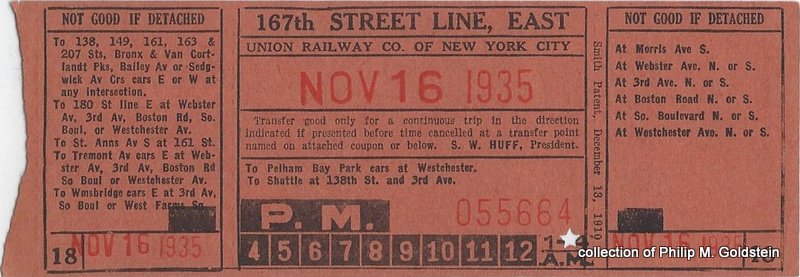 |
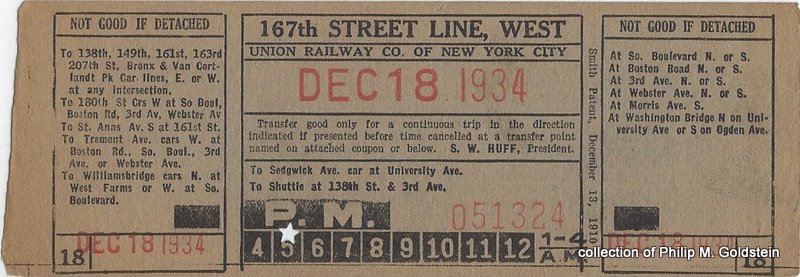 |
| East - hour punch PM (orange) - November 16, 1935 Union Railway of New York City S. W. Huff, president Smith Patent |
West - hour punch PM (purple) - December 18, 1934 Union Railway of New York City S. W. Huff, president Smith Patent |
180th Street Crosstown Line |
|
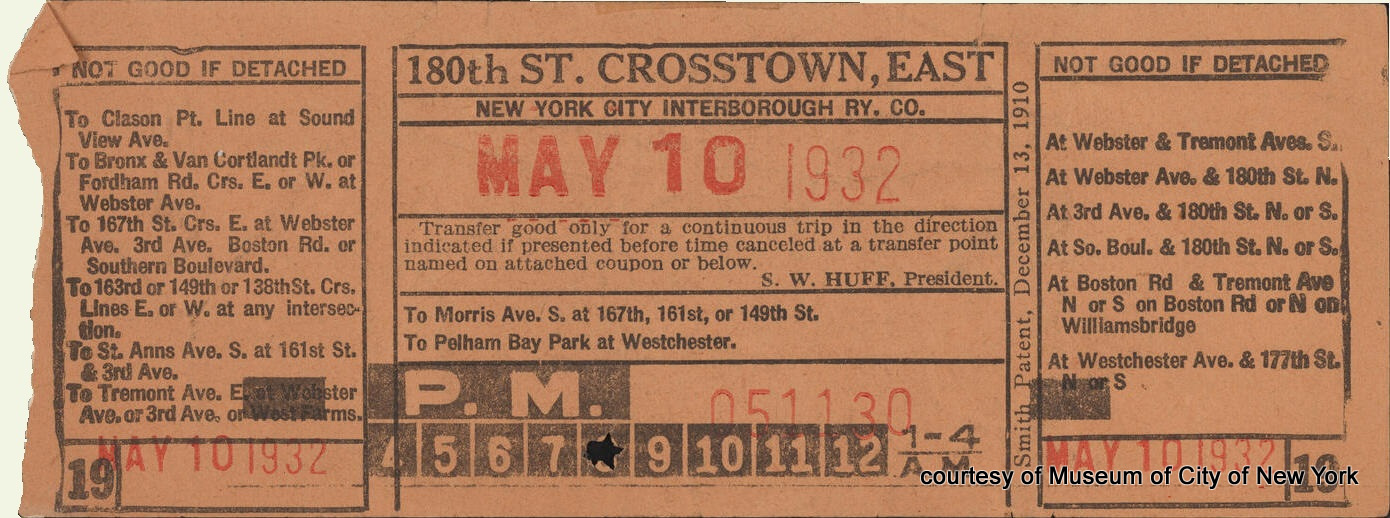 |
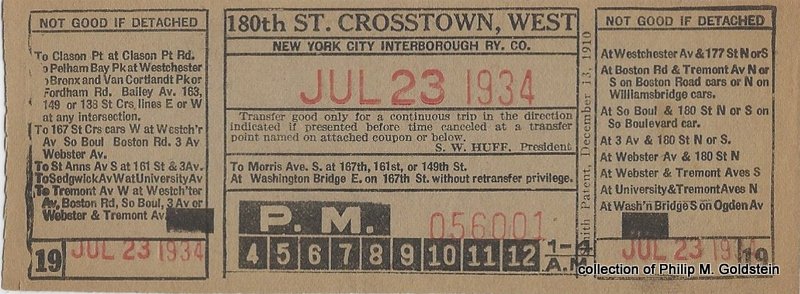 |
| East - hour punch PM (orange) - May 10, 1932 New York City Interborough Railway S. W. Huff, president Smith Patent - December 13, 1910 |
West - hour punch PM (buff) - July 23, 1934 New York City Interborough Railway S. W. Huff, president Smith Patent |
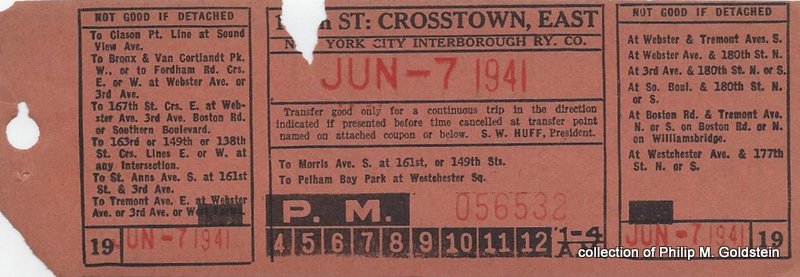 |
intentionally left blank |
| East - hour punch PM (orange) - June 7, 1941 New York City Interborough Railway S. W. Huff, president (Smith Patent copy) |
|
207th Street Crosstown |
|
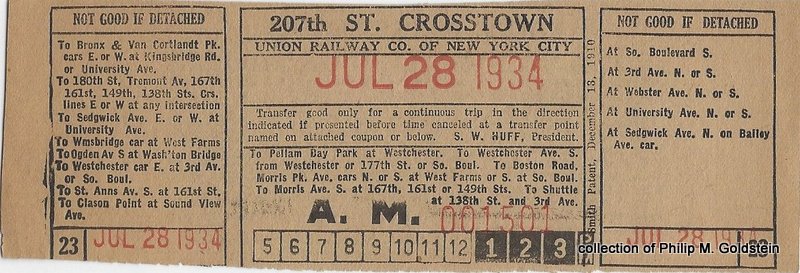 |
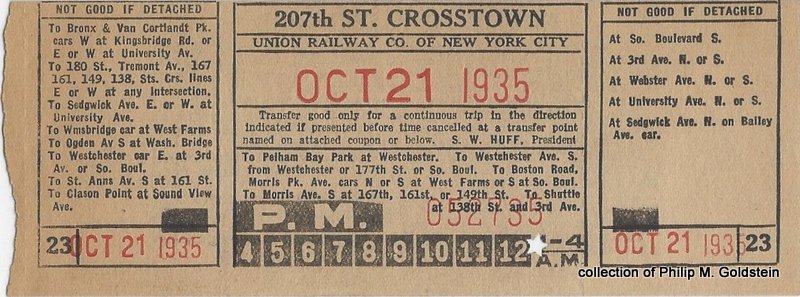 |
| (no direction specified) - hour punch AM (buff) - July 28, 1934 Union Railway of New York City S. W. Huff, president Smith Patent |
(no direction specified) - hour punch PM (buff) - October 21, 1935 Union Railway of New York City S. W. Huff, president (no patent) |
Union Railway - Conductors Check |
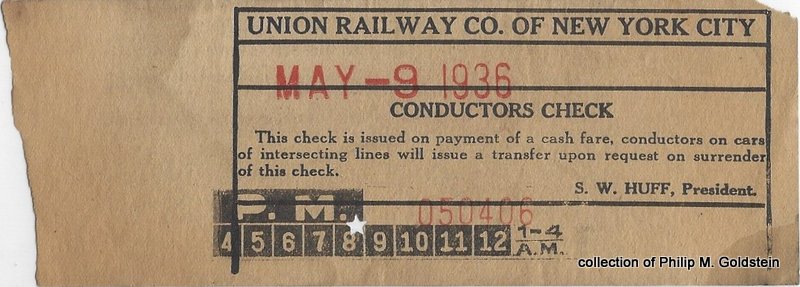 |
| hour punch PM (buff) - May 9, 1936 Conductors Check S. W. Huff, president (no patent) |
| Third Avenue Railway System - Emergency Transfers trustees appointed: June 21, 1949 |
|
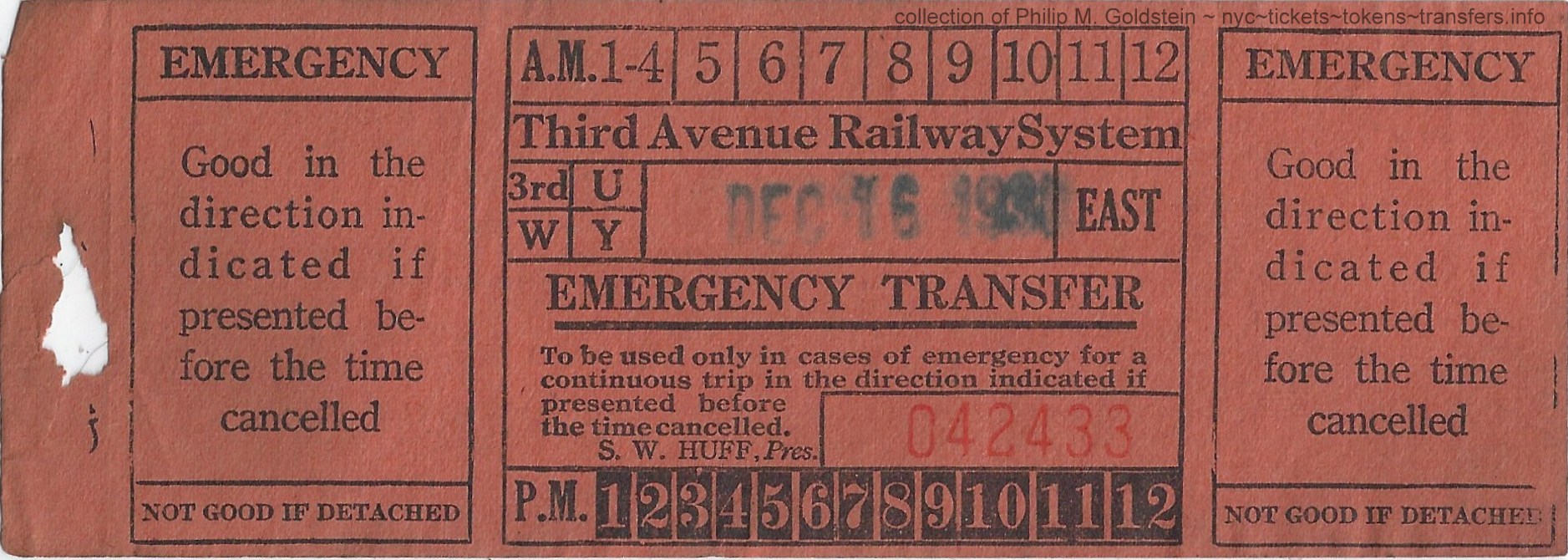 |
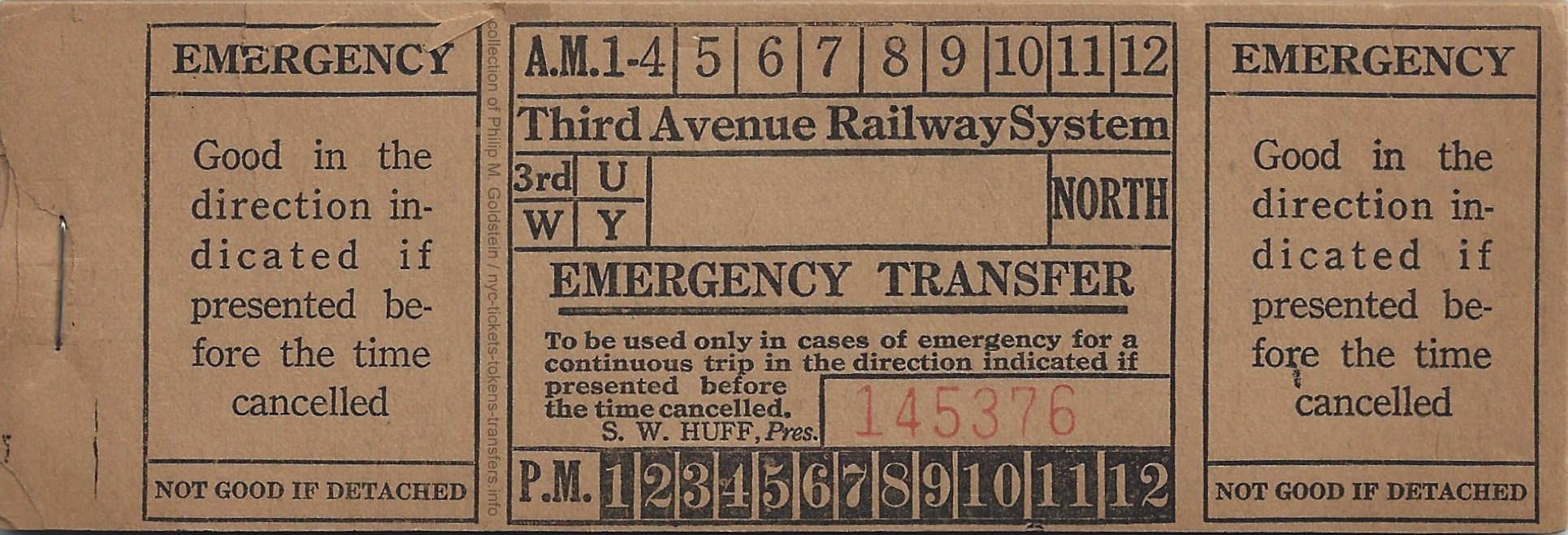 |
| East hour punch AM/PM (red) Emergency Ticket S. W. Huff, president (no patent) |
North hour punch AM/PM (buff) Emergency Ticket S. W. Huff, president (pre-1949) (no patent) |
| . | |
 |
|
| under trustee / receivership North hour punch AM/PM (buff) Emergency Ticket I. Howard Lehman, Lester T. Doyle, James Hodes, trustees overstamp (no patent) |
|

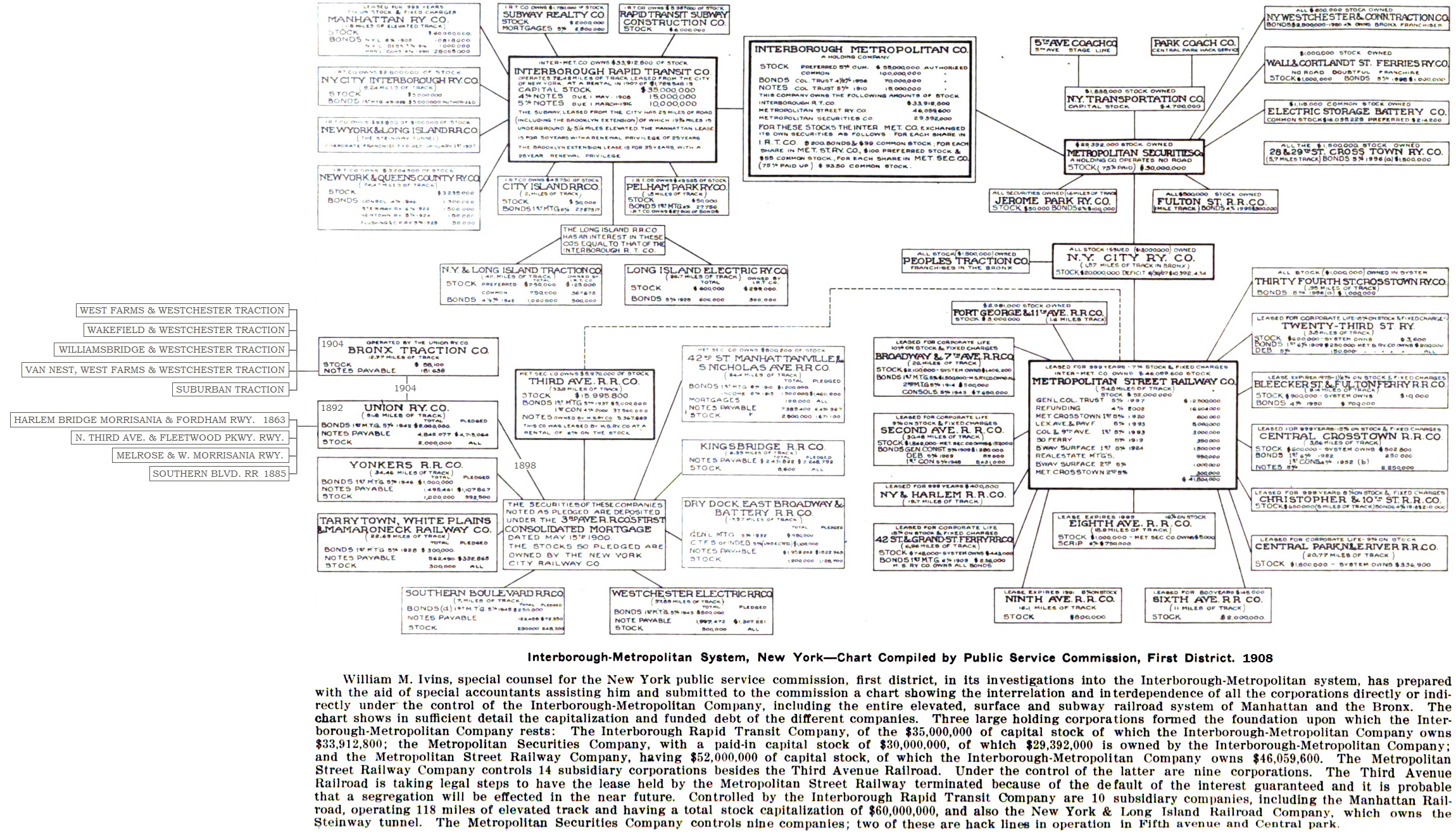
|
North–South lines
|
Crosstown Lines
|
pre-Unification Continuing Trip Tickets / Transfers |
|||||
| . Metropolitan Street Railways |
|||||
|
|
|
|
|
||
| Fulton Street - July 18, 1896 2-3/8 x 1-3/8 |
34th Street - March 4, 1896 2-3/8 x 1-3/8 |
||||
| Chambers & Grand Street Ferry Line | |||||
|
|
|
||||
| Broadway - April 30, 1892 2 1/8" x 1 5/16" |
|||||
| . | |||||
| Belt Line Division
The Belt Line Division of the Metropolitan Street Railway
was a reorganization of the Central Park North and East RiverRR in 1912.
|
|||||
|
|
|||||
| East on East Side Line from 5th Ave and 50th St. 4 3/8" x 1 7/8" |
|||||
| Third Avenue Railroad Co. |
||||||||||||
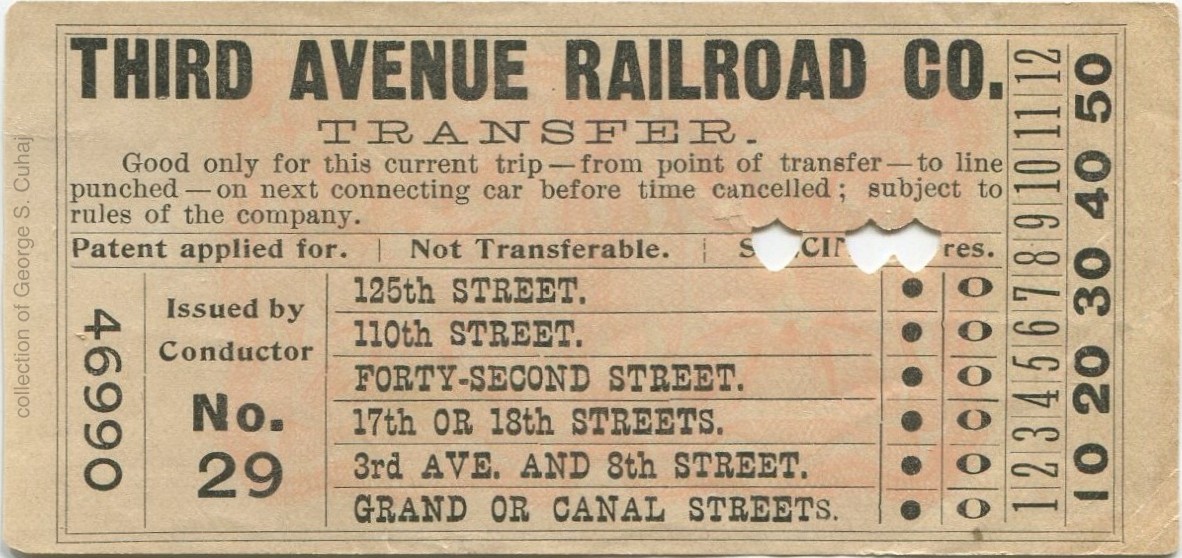 3 3/4" x 1 13/16" |
||||||||||||
|
||||||||||||
| South - PM (orange) - Monday August 14, Dry Dock, East Broadway and Battery RR F. W. Whitridge, receiver Globe Ticket |
| 1st Avenue Line
The Second Avenue Railroad was a street railway company in
Manhattan, New York City, United States. Its lines included the First
Avenue Line and the Second Avenue Line. The Second Avenue Line ran from
Peck Slip in Lower Manhattan to the Harlem River. It included branches
to the 92nd Street Ferry along the 86th Street Crosstown Line and
through 59th Street and First Avenue at the First Avenue Line.
Between 1898 and 1908, it was leased by the Metropolitan Street Railway. The East Side Omnibus Corporation replaced the Second Avenue Line with the M15 bus route and the First Avenue Line with the M13 bus route on First Avenue on June 26, 1933. The routes were combined into a one-way pair on June 4, 1951 and kept the number M15. Limited stop service began on February 11, 1974. Today it is part of the M15 Select Bus Service line. |
|
 |
 |
 |
intentionally left blank |
| North - PM (buff) - Monday June 26, 1933 Second Avenue Railroad Corp Charles E. Chalmers, president (no patent) Globe Ticket |
South - AM (buff) - Wednesday June 8, 1932 Second Avenue Railroad Corp Charles E. Chalmers, president (no patent) Globe Ticket |
| 2nd Avenue Line The
Second Avenue Railroad was a street railway company in Manhattan, New
York City, United States. Its lines included the First Avenue Line and
the Second Avenue Line. The Second Avenue Line ran from Peck Slip in
Lower Manhattan to the Harlem River. It included branches to the 92nd
Street Ferry along the 86th Street Crosstown Line and through 59th
Street and First Avenue at the First Avenue Line.
Between 1898 and 1908, it was leased by the Metropolitan Street Railway. The East Side Omnibus Corporation replaced the Second Avenue Line with the M15 bus route and the First Avenue Line with the M13 bus route on First Avenue on June 26, 1933. The routes were combined into a one-way pair on June 4, 1951 and kept the number M15. Limited stop service began on February 11, 1974. Today it is part of the M15 Select Bus Service line. |
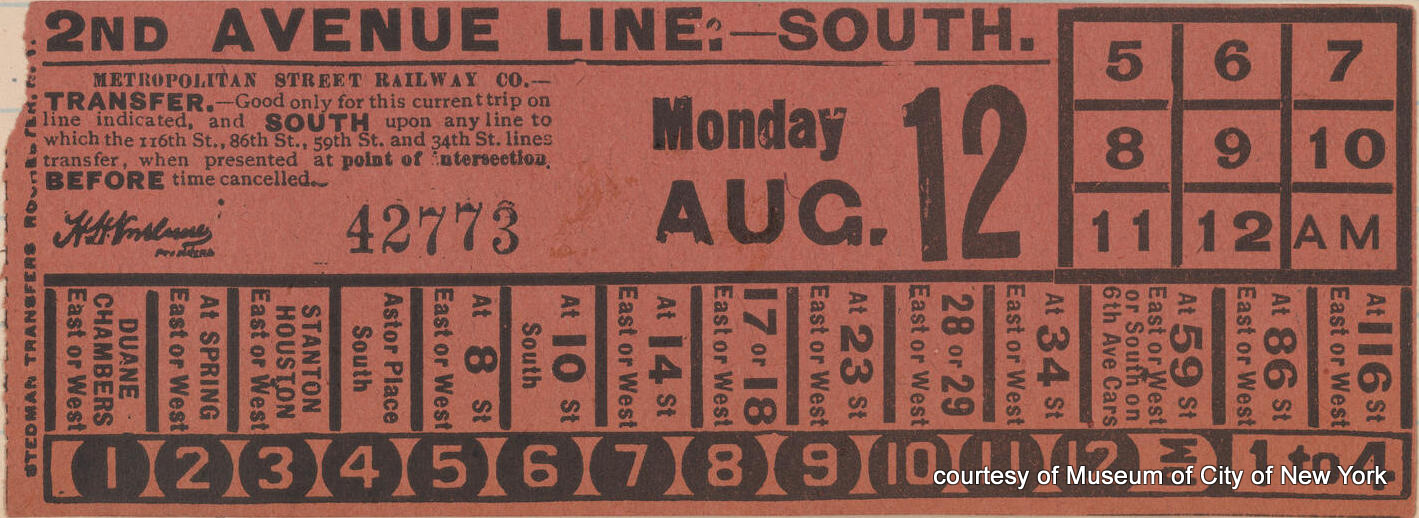 |
| South - AM (red) - Monday August 12, pre-1902 or post-1908? Metropolitan Street Railway H. H. Vreeland, president Stedman Transfer |
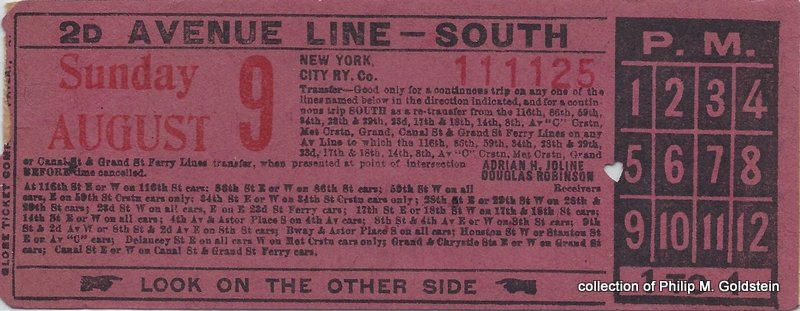 |
| South - AM (red) - Sunday August 9, ca. 1904 New York City Railway Adrian H. Joline / Douglas Robinson, receivers Globe Ticket |
| . |
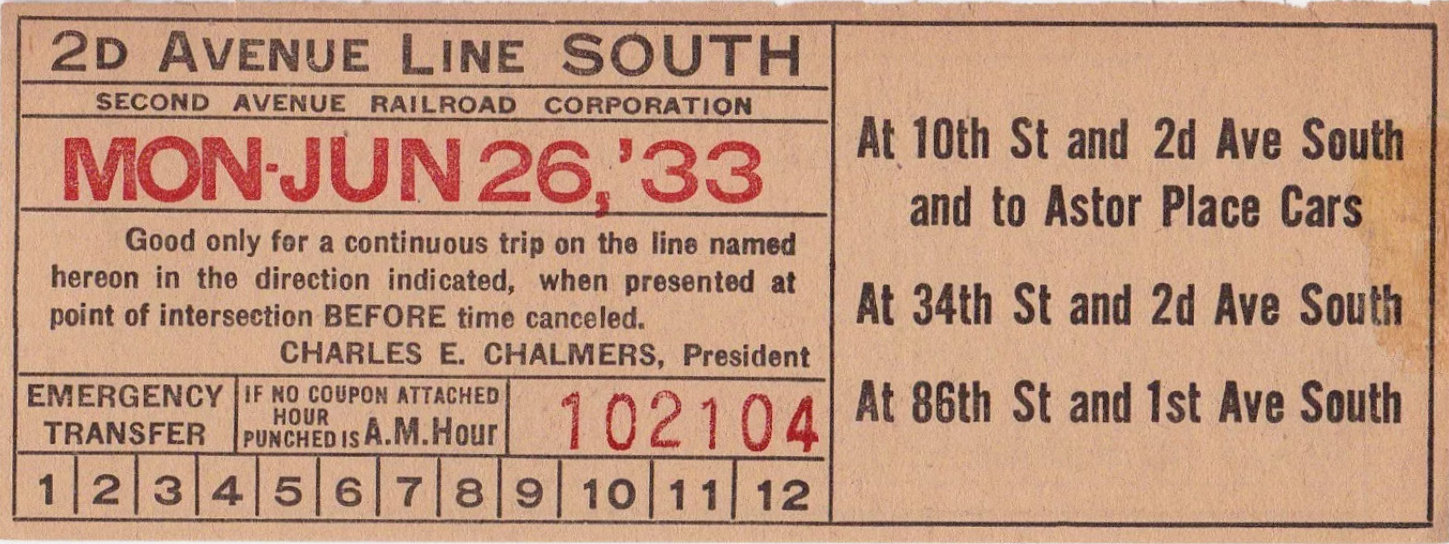 |
| South - (buff) - Monday, June 26, 1933 hourly punch, PM coupon Second Avenue Railroad Corp. Charles E. Chalmers, president |
| Third Avenue & Amsterdam Line 1853 - 1947 The Third and Amsterdam Avenue Line, also known as the Third
Avenue Line, ran mostly along Third Avenue, 125th Street, and Amsterdam
Avenue from Lower Manhattan to Fort George in Washington Heights.
The Third Avenue Railroad opened the line in 1853, from Astor House (Broadway and Park Row) north along Park Row, the Bowery (shared with the Second Avenue Line), and Third Avenue to 86th Street; an extension to East Harlem opened in 1859. Using the One-Hundred and Twenty-Fifth Street Railroad and trackage along Amsterdam Avenue, Third Avenue cars were also operated to Fort George. On May 28, 1947, internal combustion powered omnibuses were substituted for streetcars by the Surface Transportation Corporation. It was operated by Fifth Avenue Coach Lines from 1956 to 1962, when the Manhattan and Bronx Surface Transit Operating Authority (MaBSTOA) took over operations. On July 17, 1960, most of Third Avenue became one-way northbound, and southbound buses were moved to Lexington Avenue. It is now the M101 bus, operated out of the 100th Street Bus Depot. The M101 bus now runs southbound on Lexington Avenue rather than Third Avenue north of 24th Street. |
|
 |
 |
| North - AM (buff) - May 21, 1927 Third Avenue Railway S. W. Huff, president Smith Patent |
South - PM (buff) - March 18, 1927 Third Avenue Railway S. W. Huff, president Smith Patent |
| . | |
| intentionally left blank | 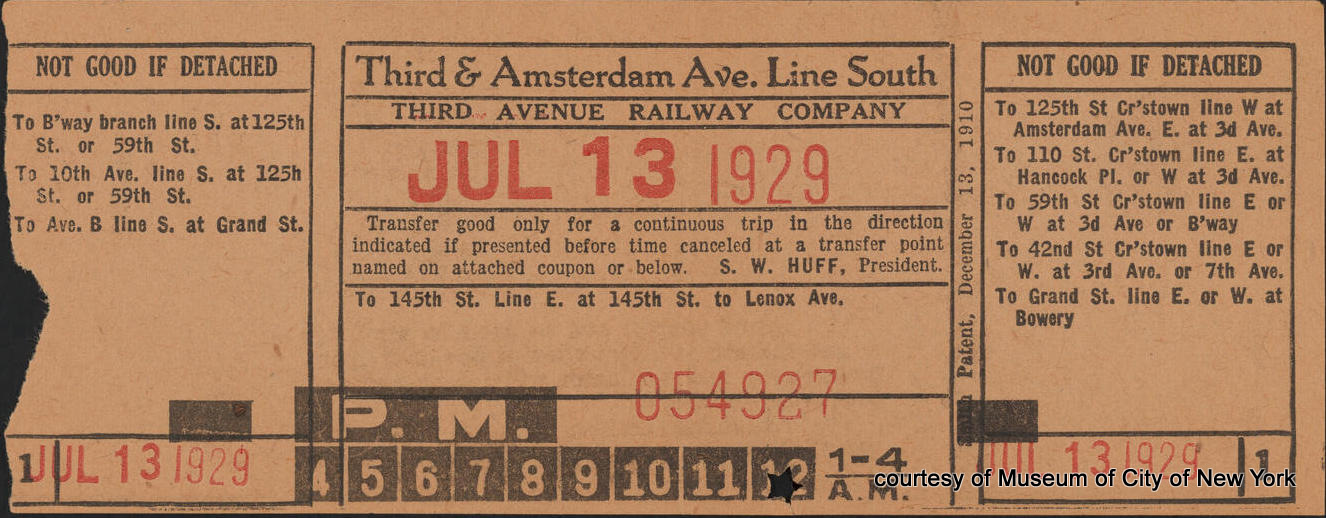 |
| South - PM (orange) - July 13, 1929 Third Avenue Railway S. W. Huff, president (no patent) |
|
| . | |
| intentionally left blank | 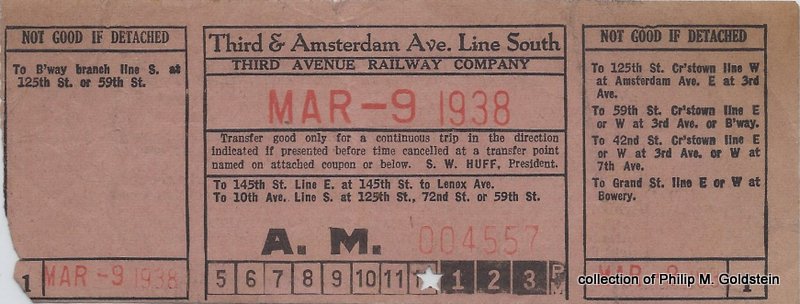 |
| South - AM (pink) - March 9, 1938 Third Avenue Railway S. W. Huff, president (no patent) |
|
| Lexington Avenue Line | |
| intentionally left blank | 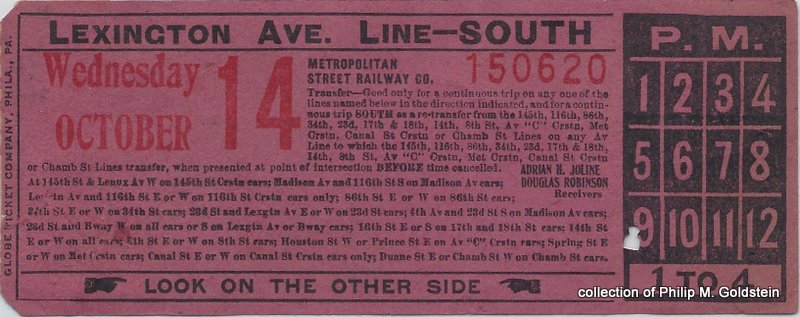 |
| South - AM/PM (pink) - Wednesday, October 14, (1908) Metropolitan Street Railway Co. Adrian H Joline / Douglas Robinson receivers (no patent) Globe Ticket 2" x 5 1/4" |
|
| . | |
North - AM/PM (green) - Thursday, February 19, 1914 New York Railways Co. T. P. Shonts, President (Smith Patent) Globe Ticket 2 1/16" x 5 1/8" w/o selvage and first part |
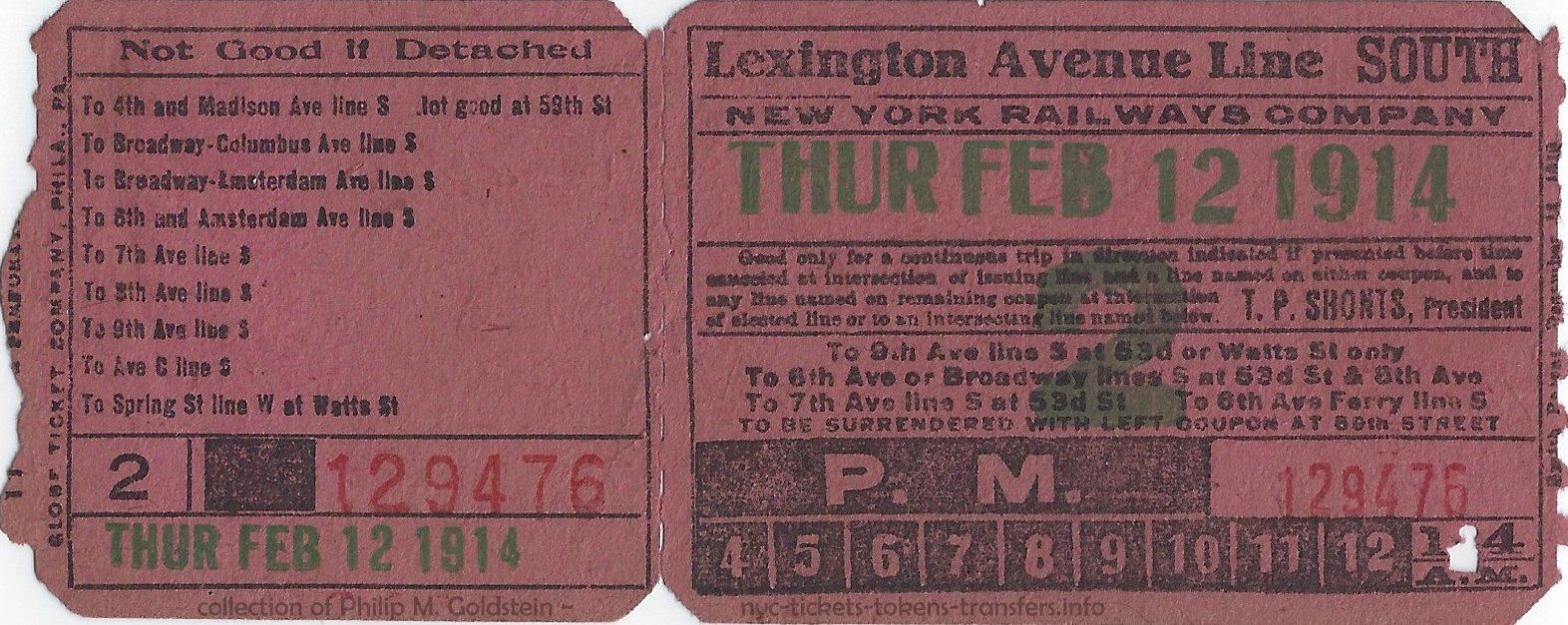 South - AM/PM (pink) - Thursday, February 12, 1914 New York Railways Co. T. P. Shonts, President (Smith Patent) Globe Ticket 2 1/16" x 5 1/8" w/o selvage and third part |
| . | |
| intentionally left blank | 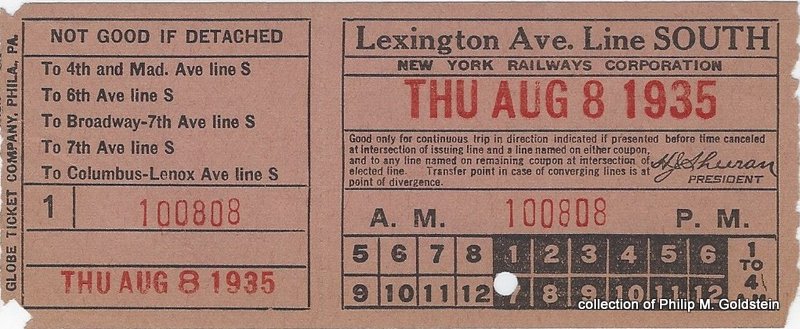 |
| South - AM/PM (pink) - Thursday August 8, 1935 New York Railways Corp H. J. Sheeran, president (no patent) Globe Ticket 2 1/16" x 5 1/16" w/o selvage and first part |
|
| 4th and Madison Avenue Line (1852 - March 1936)
The Fourth and Madison Avenue Line was a streetcar line running
mostly along Park Avenue and Madison Avenue from Lower Manhattan to
Harlem. Originally a horsedrawn streetcar line, the
New York and Harlem Railroad (which was the first railroad in
Manhattan) ran from City Hall north along Centre Street, Broome
Street (northbound trains were later moved to Grand Street), the
Bowery, Fourth Avenue, and Park Avenue to Harlem in the 1830s, and was
extended southwest along Park Row to Broadway in 1852.
A branch opened along 42nd Street and Madison Avenue to 73rd Street in 1870, and the New York & Harlem RR began to operate streetcars along this route. Service was later extended to Harlem. On September 17, 1888 electric streetcar service began on this route. On July 1, 1896, the New York & Harlem was leased to the Metropolitan Street Railway. On an as yet unknown date, the Metropolitan Street Railway was leased to the New York City Railway, and New York City Railway itself went into receivership on September 27, 1907; and the lease reverted back to the Metropolitan Street Railway on July 31, 1980. This lease terminated on January 31, 1920 and operations went back to New York & Harlem Railroad. Then it was leased to New York Railways Corp on October 10, 1932, with the right to convert to internal combustion powered buses, which it did on February 19, 1934. In March 1936, the streetcar system was converted to internal combustion powered omnibuses, and the company reorganzied as the Madison Avenue Coach Company. The New York City Omnibus Corporation absorbed these operations in 1951, and subsequently changed its name to Fifth Avenue Coach Lines in 1956. When the bus that replaced the Lexington and Lenox Avenues Line was terminated, the Madison Avenue bus was extended west on 139th Street and north on Lenox Avenue to 147th Street. When Madison Avenue became one-way northbound, southbound traffic was moved to Fifth Avenue, replacing the original route of the Fifth Avenue Coach Company. The Manhattan and Bronx Surface Transit Operating Authority (MaBSTOA) took over operations in 1962. |
|
| intentionally left blank |  |
| South - PM (red) - Wednesday, March 21, 1906 New York City Railway Co. H. H. Vreeland, president (no patent) Globe Ticket |
|
| . | |
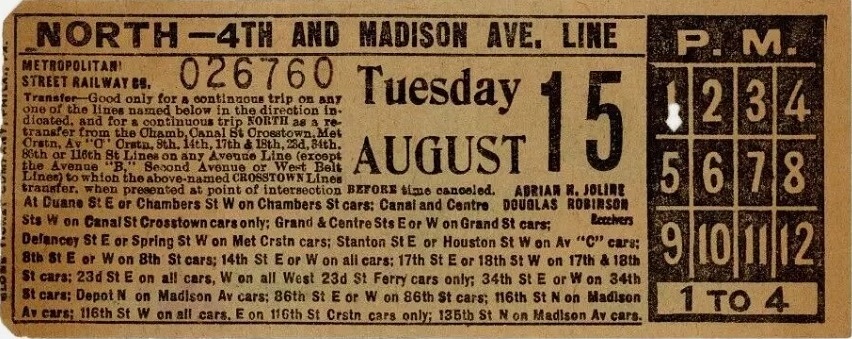 |
 |
| North - PM (buff) - Tuesday August 15, 1911 Metropolitan Street Railway Co. Adrian H. Joline & Douglas Robinson receivers Globe Ticket |
North - PM (salmon) - Tuesday August 15, 1911 Metropolitan Street Railway Co. Adrian H. Joline & Douglas Robinson receivers Globe Ticket |
| . | |
 |
 |
| North - PM (green) - Tuesday February 10, 1914 New York Railways T. P. Shonts, president Smith Patent |
South - AM (salmon) - Saturday October 12, 1912 New York Railways T. P. Shonts, president Smith Patent |
| . | |
| . | |
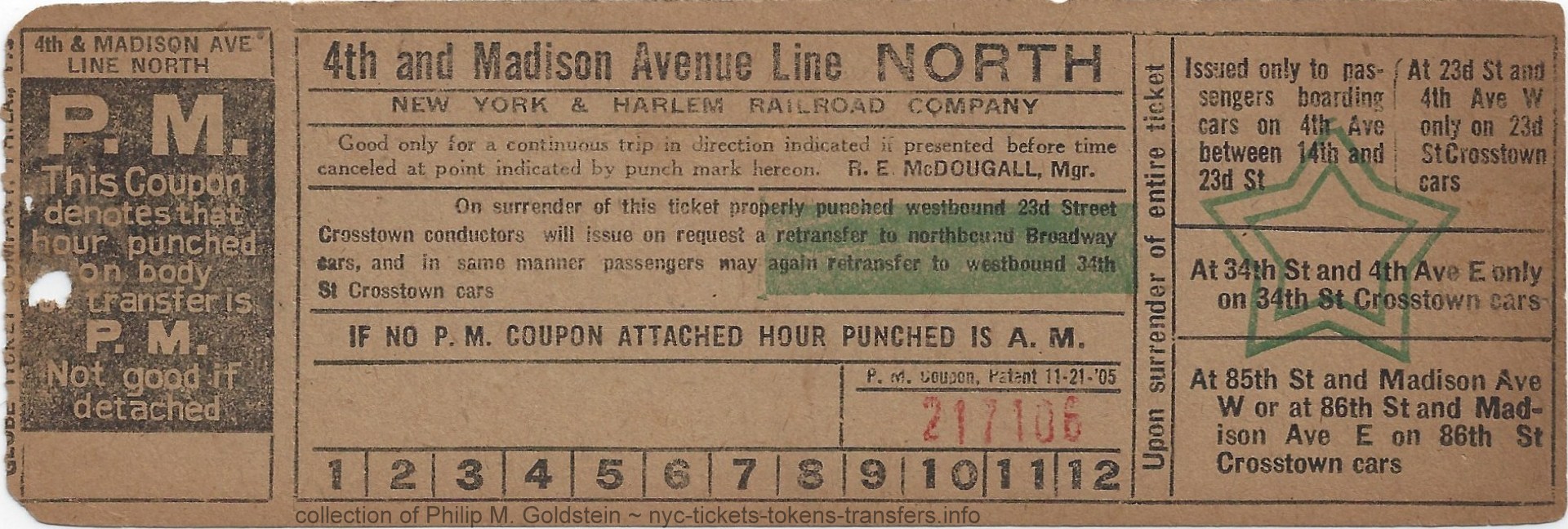 |
 |
| .South - PM (buff - with green stripe & star) - ca. January 1, 1920 - October 10, 1932 New York & Harlem Railroad Co. R. E. McDougall, manager Globe Ticket P. M. Coupon Patent 11-21-'05 |
South - PM (buff with red stripe & star) - ca. January 1, 1920 - October 10, 1932 New York & Harlem Railroad Co. R. E. McDougall, manager Globe Ticket P. M. Coupon Patent 11-21-'05 |
| . | |
| intentionally left blank | 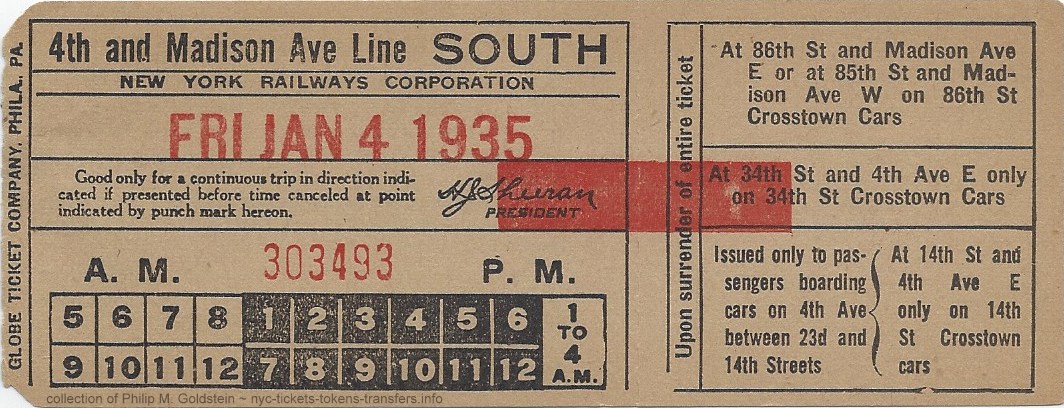 |
| South - PM (red) - Friday, January, 4, 1935 New York City Railway Corporation H. J. Sheeran, president (no patent) Globe Ticket |
|
| Broadway Line | |
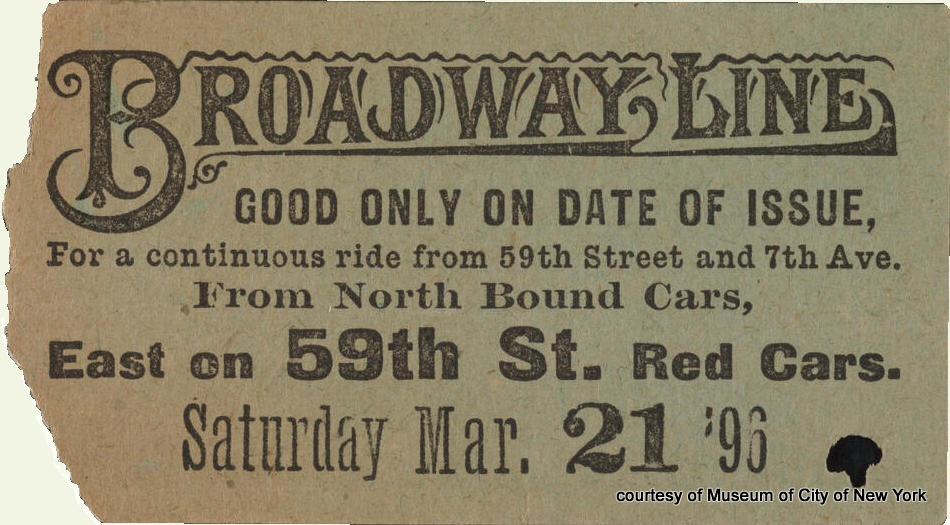 |
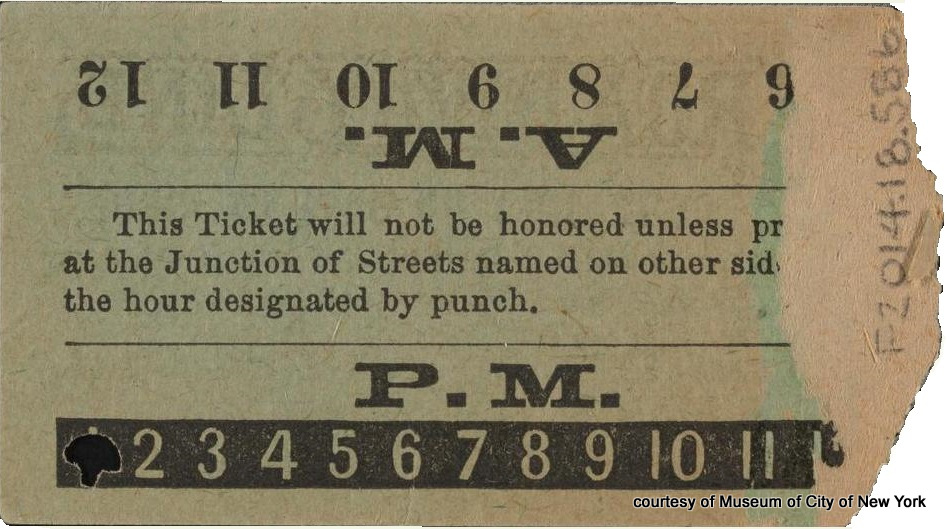 |
| East on 59th Street Red Cars - March 21, 1896 | |
| . | |
| intentionally left blank | 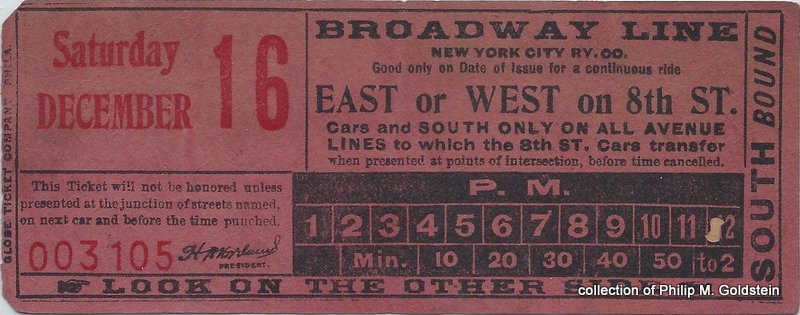 |
| South - PM (red) - Saturday, December 16, 1905 New York City Railway H. H. Vreeland, president (no patent) Globe Ticket |
|
| Broadway Night Cars |
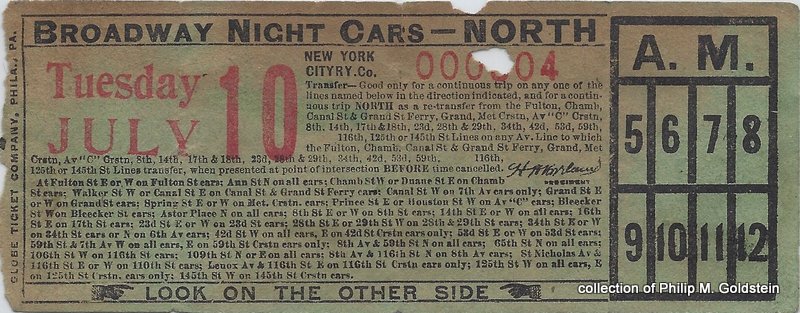 |
| North - AM (green) - Tuesday, July 10, 1906 New York City Railway H. H. Vreeland, president (no patent) Globe Ticket |
| Broadway Branch | |
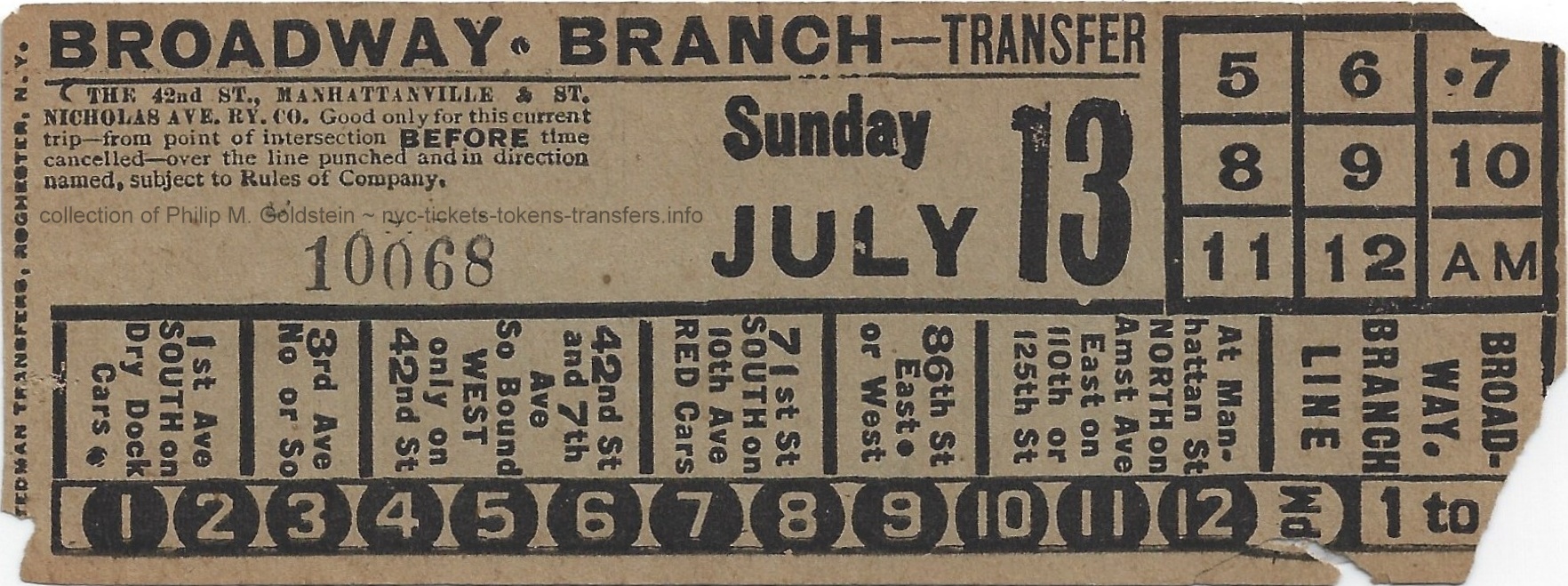 |
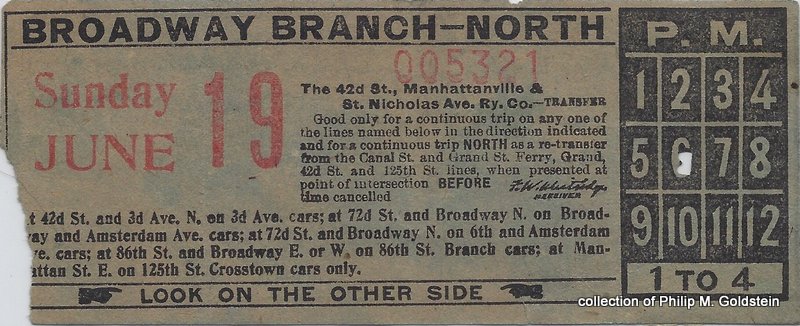 |
| no direction - Transfer - Sunday July 13, 1902 42nd St., Manhattanville & St. Nicholas Avenue Railway Stedman Transfers |
North - PM (green) - Sunday, June 19, 1910 42nd St., Manhattanville & St. Nicholas Avenue Railway F. W. Whitridge receiver (no patent) (1904, 10, 21, 27, 32, 38) |
| . | |
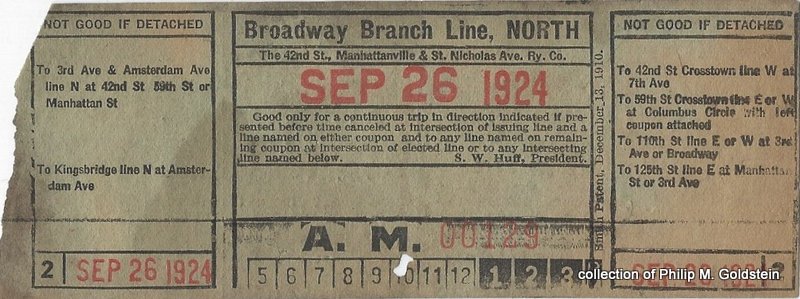 |
intentionally left blank |
| (sans-serif) North - AM (green) - September 26, 1924 42nd st., Manhattanville & St. Nicholas Avenue Railway S. W. Huff, president Smith Patent |
|
| . | |
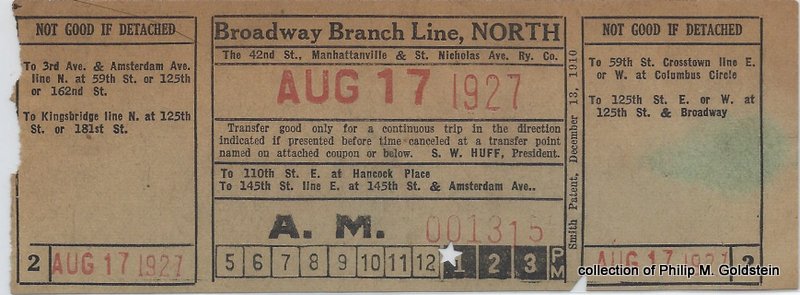 |
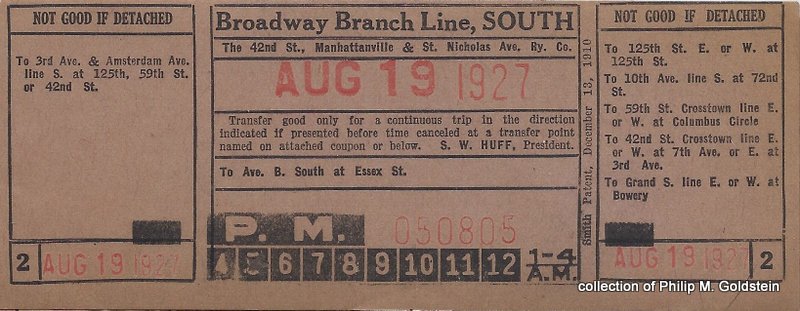 |
| North - AM (buff) - August 17, 1927 42nd st., Manhattanville & St. Nicholas Avenue Railway S. W. Huff, president Smith Patent |
South - PM (pink) - August 19, 1927 42nd St., Manhattanville & St. Nicholas Avenue Railway S. W. Huff, president Smith Patent |
| . | |
| intentionally left blank | 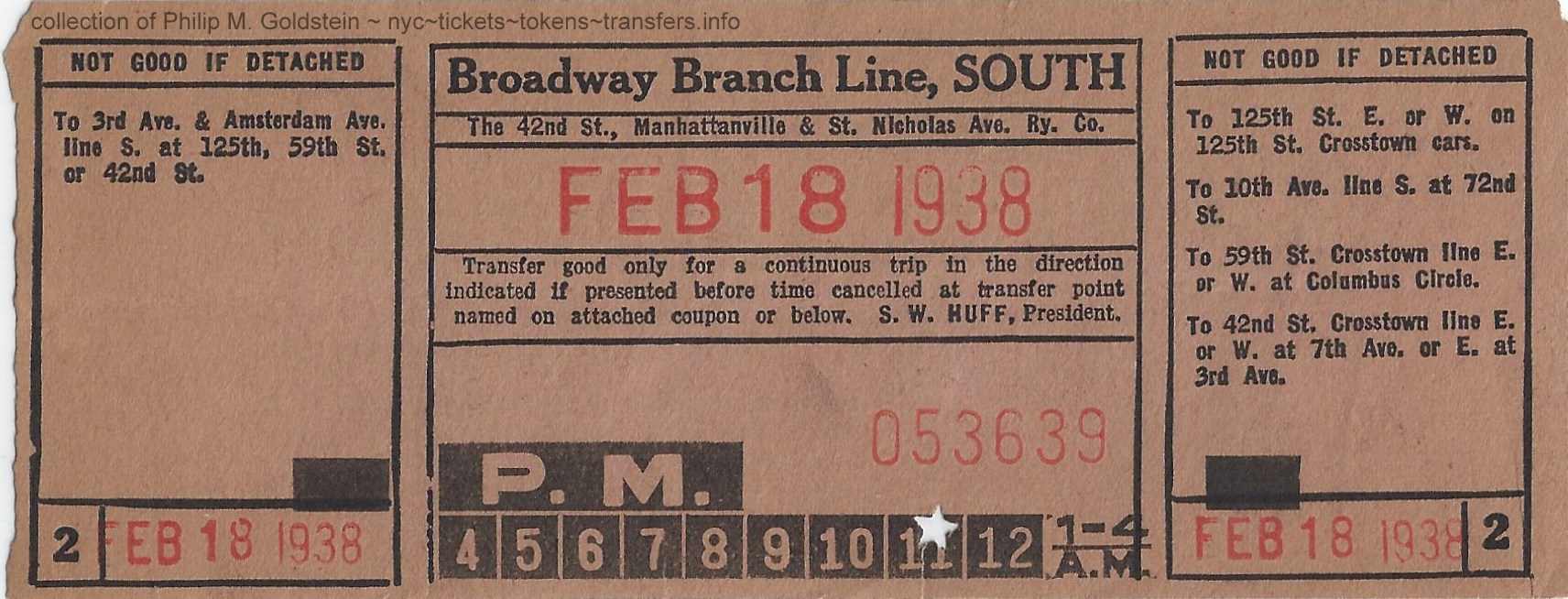 |
| South - PM (pink) - February 18, 1938 42nd St., Manhattanville & St. Nicholas Avenue Railway S. W. Huff, president no patent |
|
| Broadway - Columbus Avenue Line | |
| intentionally left blank | 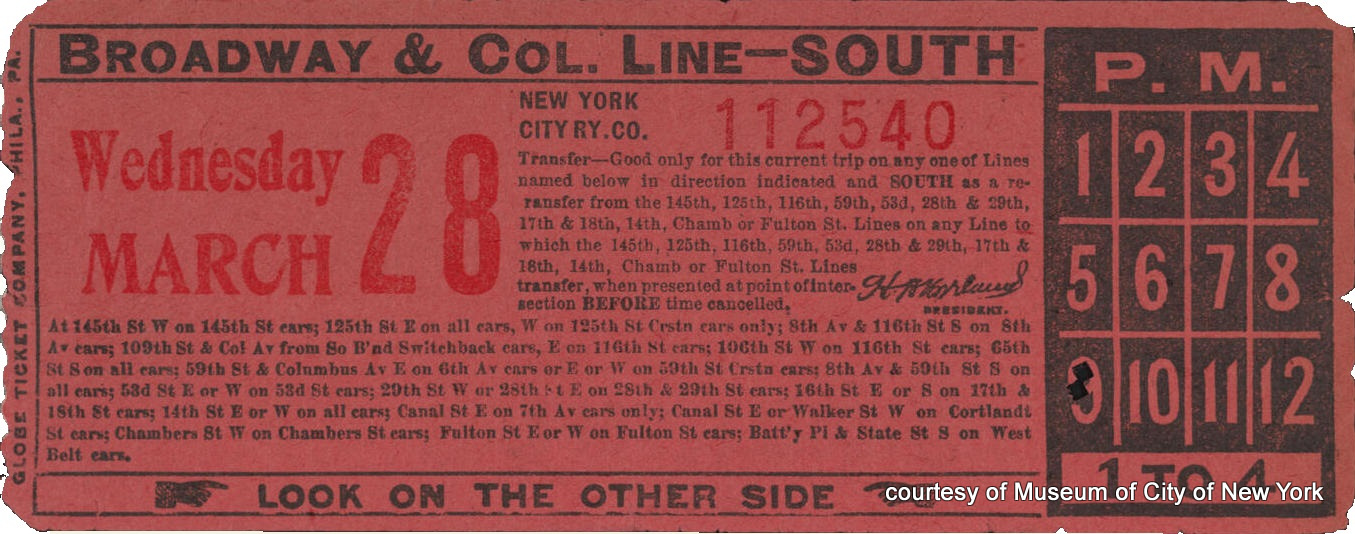 |
| South - PM (red) - Wednesday March 28, 1906 New York City Railway Co. H. H. Vreeland, president Globe Ticket |
|
| . | |
 |
intentionally left blank |
| North - AM (buff) - Monday April 21, 1913 hourly punch AM, 1-3 AM New York Railways T. P. Shonts, President Smith Patent |
|
| Broadway - 7th Avenue Line |
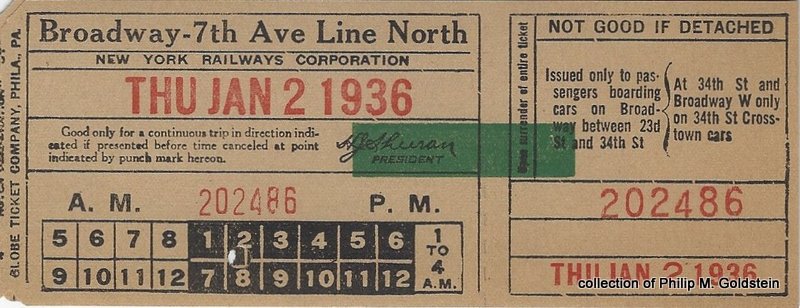 |
| North - AM/PM (buff) 4-31 - Thursday January 2, 1936 New York Railways Corp. H. J. Sheeran, president (no patent) Globe Ticket (note on back: street car) |
| . |
  |
| North - AM/PM (pink) 12-35 - Tuesday April 14, 1935 New York Railways Corp. (no patent) Globe Ticket H. J. Sheeran, President (on back) |
| 6th and Amsterdam Avenue Line |
 |
| North - AM (green) Wednesday August 25, 1915 hourly punch AM, 1-3 PM New York Railways T. P. Shonts, President Smith Patent |
| 8th / Eighth Avenue Line | |
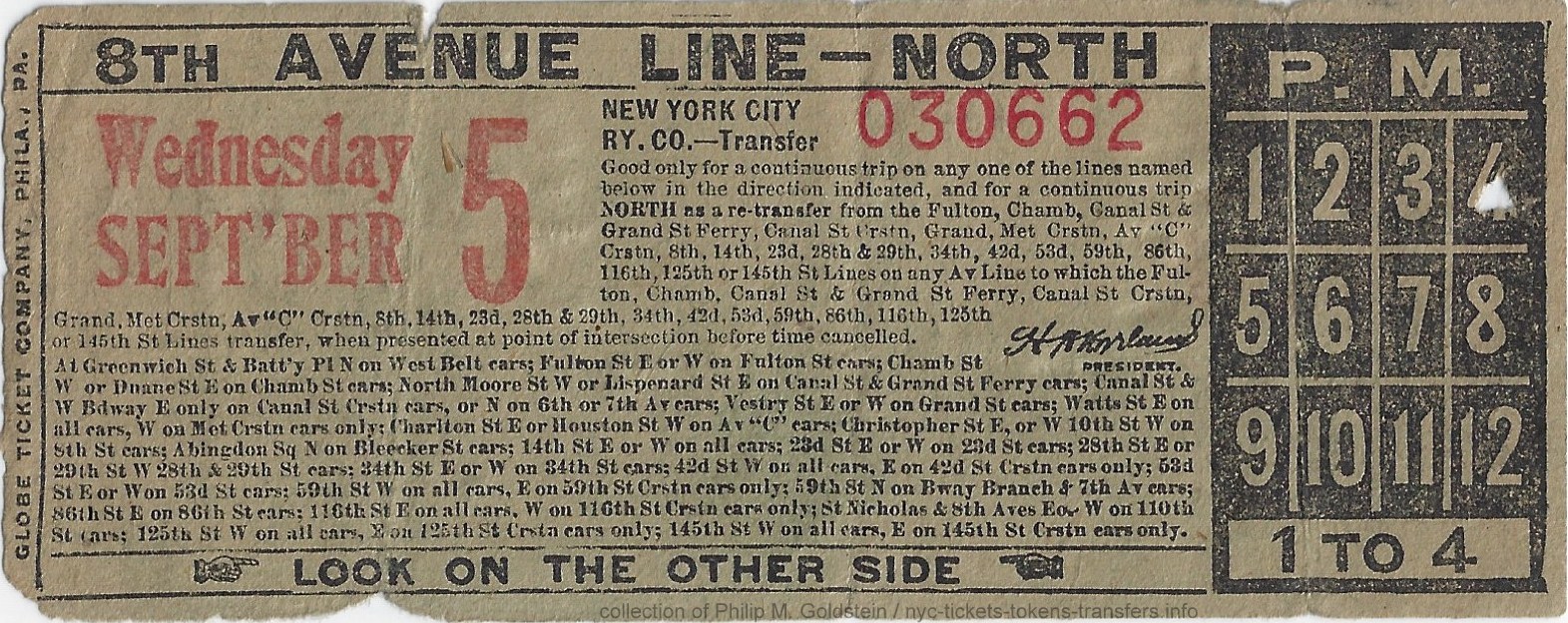 |
 |
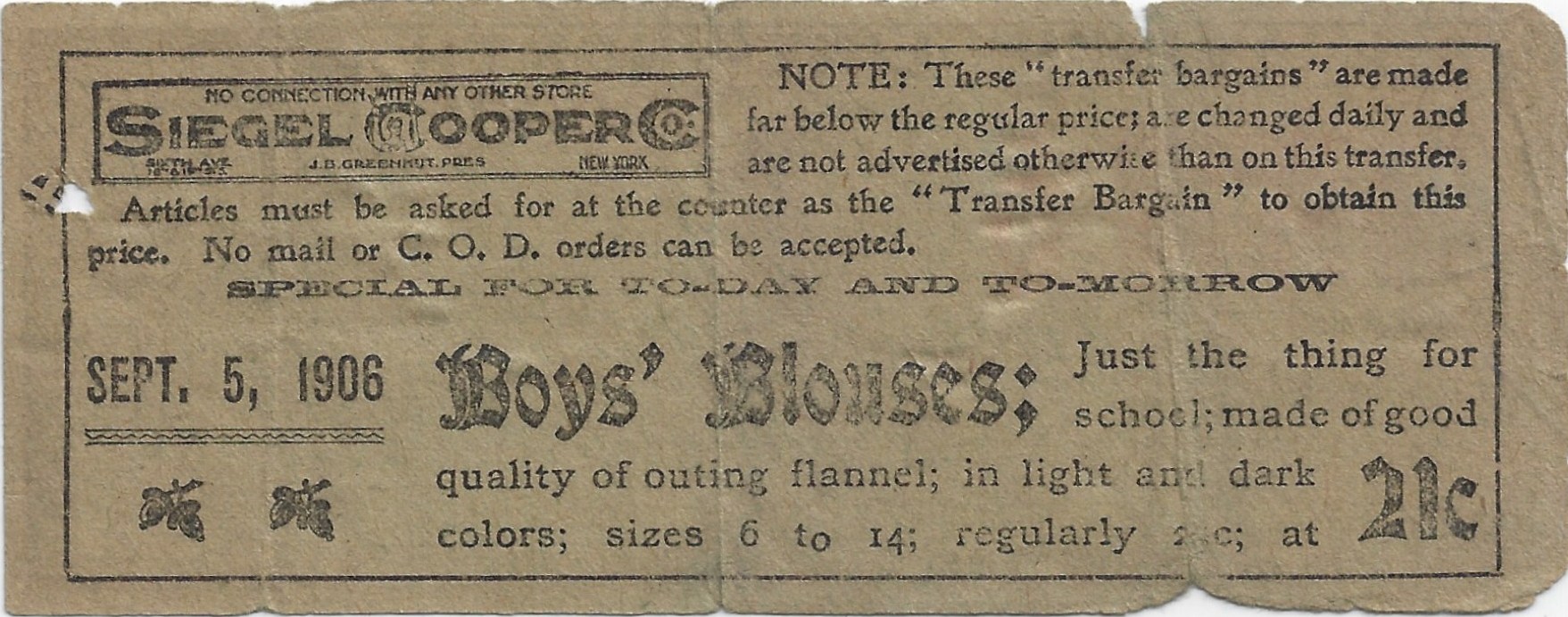 |
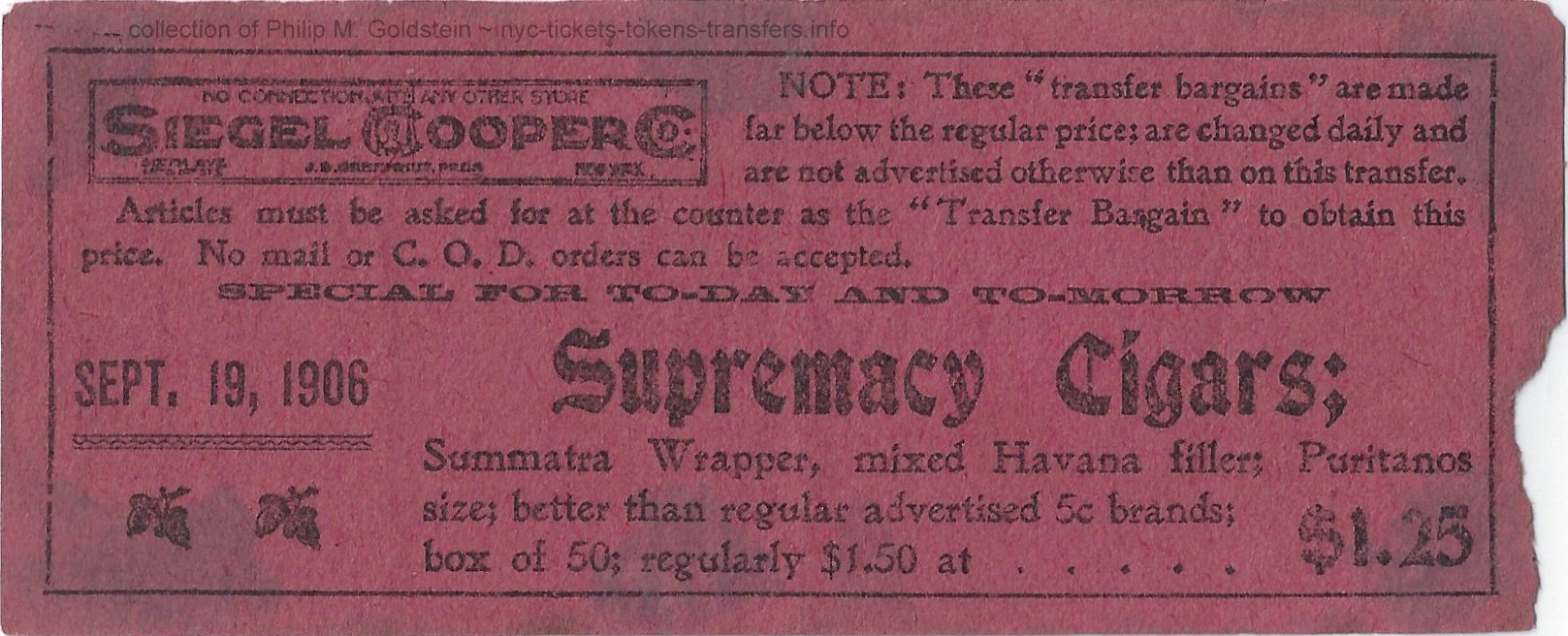 |
| South - PM (green) - September 5, 1906 New York City Railway Co. H. H. Vreeland, president Globe Ticket |
South - PM (salmon) - September 19, 1906 New York City Railway Co. H. H. Vreeland, president Globe Ticket |
 |
 |
| North - PM (green) - Thursday, January 29, 1914 hourly punch PM, 1-4 AM New York Railways Co. T. P. Shonts, president Smith Patent Ticket |
North - PM (salmon) - Monday, January 29, 1914 hourly punch PM, 1-4 AM New York Railways Co. T. P. Shonts, president Smith Patent Ticket An interesting piece as it carries a 1-4am punch. Time period of least amount of travel! |
| 9th / Ninth Avenue Line |
 |
| North - PM (green) - Friday, September 26, 1913 hourly punch PM, 1-4 AM New York Railways T. P. Shonts Smith Patent |
| 8th / Eighth and 9th / Ninth Avenue Railways The Eighth Avenue Railroad and the Ninth Avenue Railroad each began as
separate horse drawn street railroads, with the Eighth Avenue Railway
being organized in 1852; and the Ninth Avenue Railway following seven
years later. In 1893, both companies were both purchased by the
Metropolitan Street Railway but continued to be operated as separate
entities. In 1898, the horse drawn car operations were converted to
electric streetcars on the Eighth Avenue line, with the Ninth Avenue
line being converted in 1900 or 1901.
In 1911, the Metropolitan Street Railway Co. was bought out by New York Railways. The Eighth and Ninth Avenue Railroads merged in December 1926 to form the Eighth and Ninth Avenues Railway, but that company entered receivership on shortly thereafter on May 5, 1927. In 1936, the electric streetcar operation ere converted to internal combustion omnibus, and the company reorganized under the name of Eighth Avenue Coach Co., itself a subsidiary of the Fifth Avenue Coach Co. The Fifth Ave Coach Company operated until 1962, when almost all private bus operations in Manhattan were consolidated under the Manhattan & Bronx Surface Transit Operating Authority (MaBSTOA). |
|
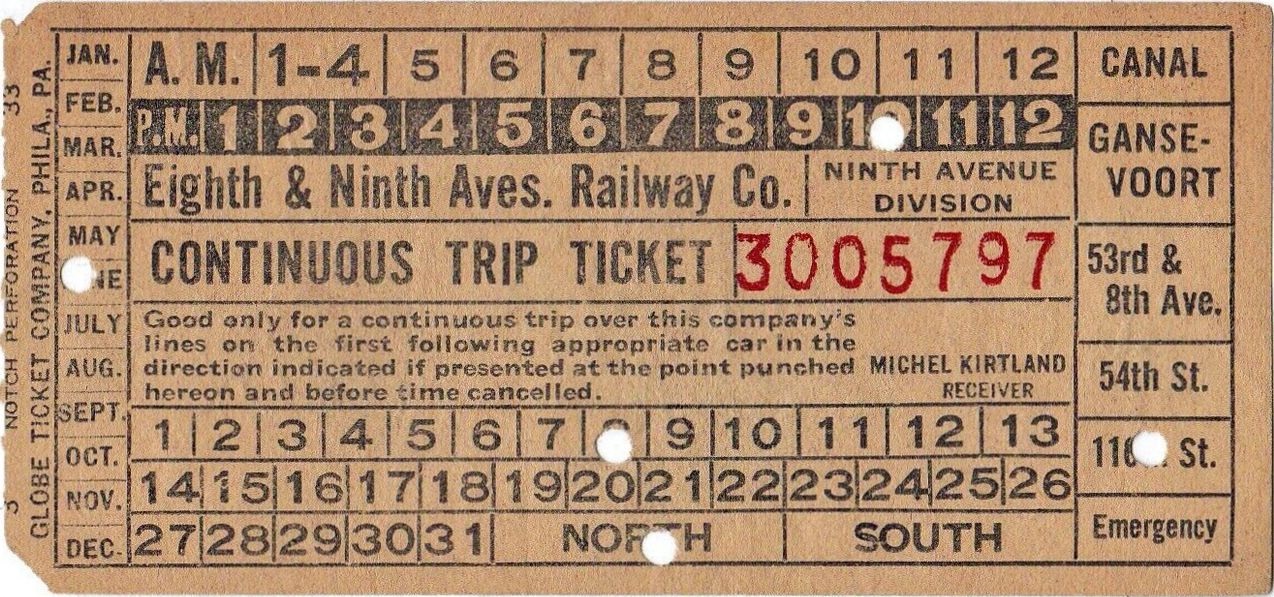 |
 |
| North - June 8, |
|
| Columbus - Lenox Avenue Line |
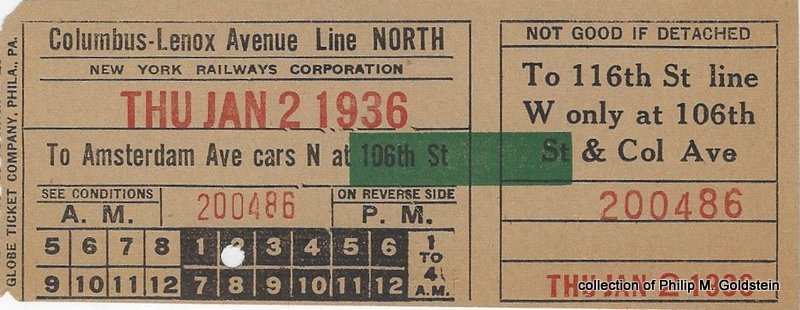 |
| North - AM/PM (buff) - Thursday January 2, 1936 New York Railways (no patent) Globe Ticket |
| 10th / Tenth Avenue 1884 -
Chartered in 1878, the Forty-Second Street, Manhattanville & St.
Nicholas Railway opened in 1884. Acquisition of this line in 1896
garnered the Third Avenue Railroad this lucrative 42nd Street crosstown
line.
|
|
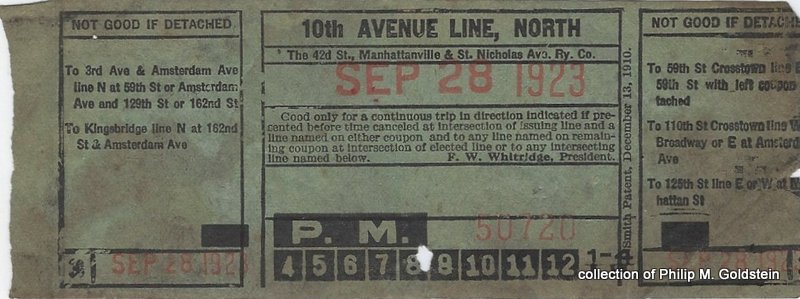 |
intentionally left blank |
| North - PM (green) - September 28, 1923 42nd St, Manhattanville & St. Nicholas Railway F. W. Whitridge, president Smith Patent |
|
| . | |
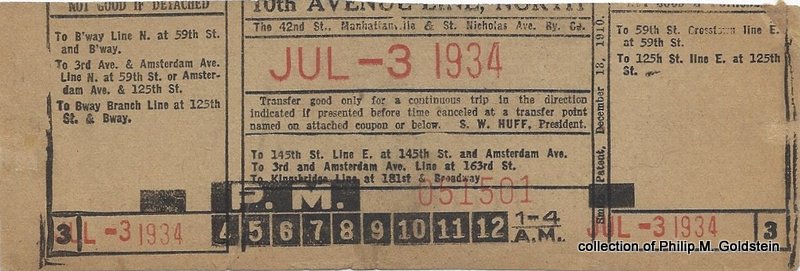 |
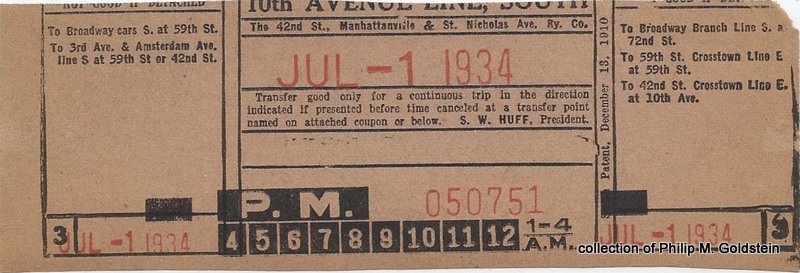 |
| North - PM (green) - July 3, 1934 42nd St, Manhattanville & St. Nicholas Railway S. W. Huff, president Smith Patent |
South - PM (pink) - July 1, 1934 42nd St, Manhattanville & St. Nicholas Railway S. W. Huff, president Smith Patent |
| West Belt Line |
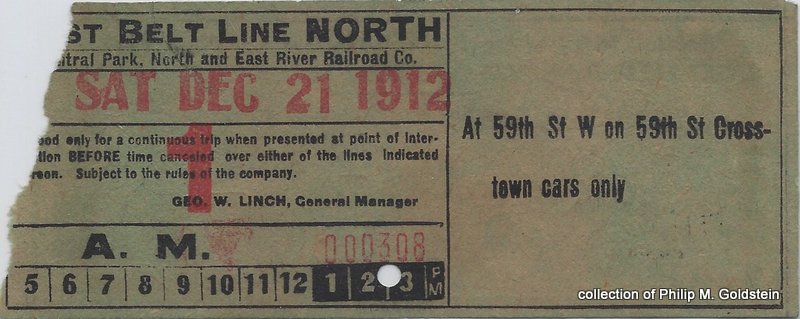 |
| North - AM (green) - Saturday December 21, 1912 Central Park, North & East River Railroad George W. Linch, general manager (no patent) |
| Bleecker Street Line |
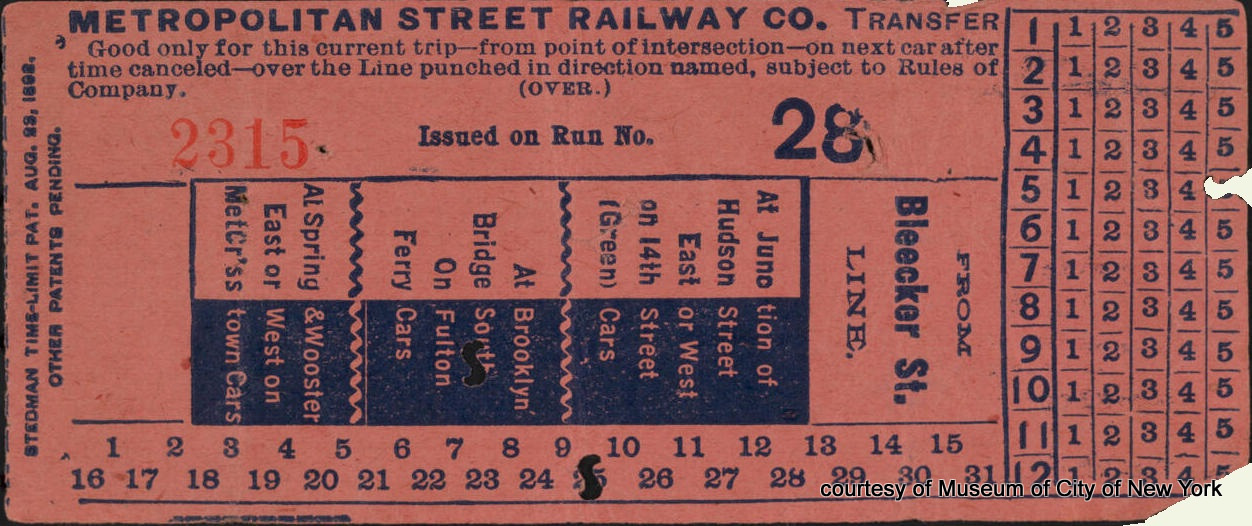 |
| from Bleecker St at Brooklyn Bridge South on Fulton Ferry Cars Metropolitan Street Railway Co. Stedman Time-Limit |
| Grand Street Line |
The company became under the
control of the Third Avenue Railway
System in 1897. Entered receivership on February 1, 1908 with F. W.
Whitridge as
receiver. The Public Service Commission granted permission to electrify
the Canal Street line on October 25, 1912. Routes operated were:
The Grand Street Crosstown route became the Avenue B and East Broadway Transit Co. route M8. |
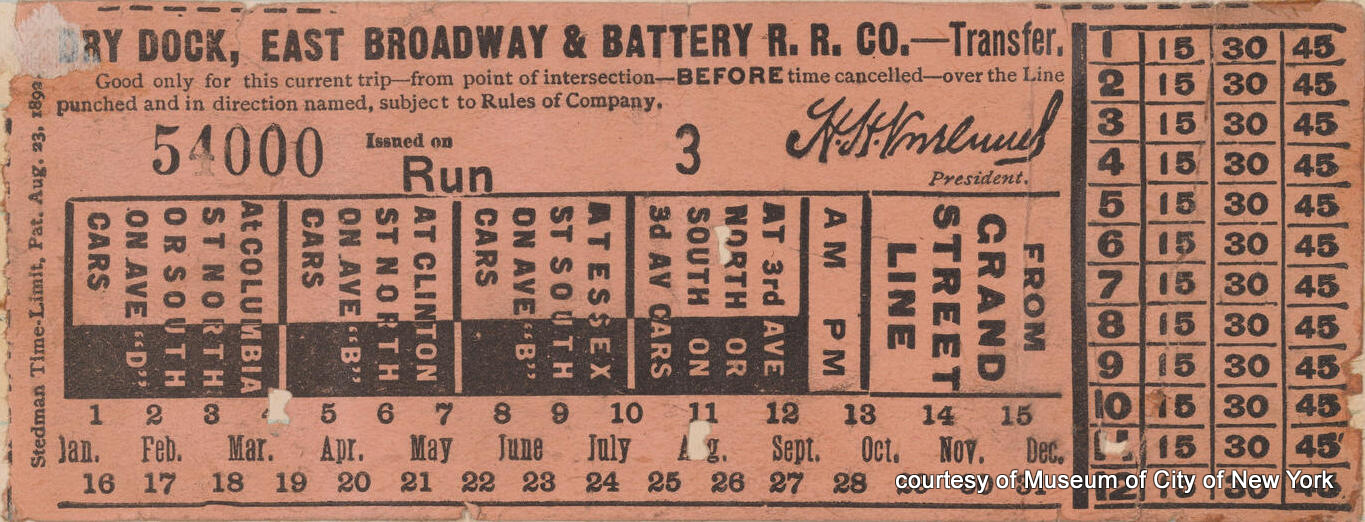 |
| From Grand Street Line at Third Avenue to north or south cars - August 4, ca. 1900 Stedman Time Limit H. H. Vreeland, president |
| . |
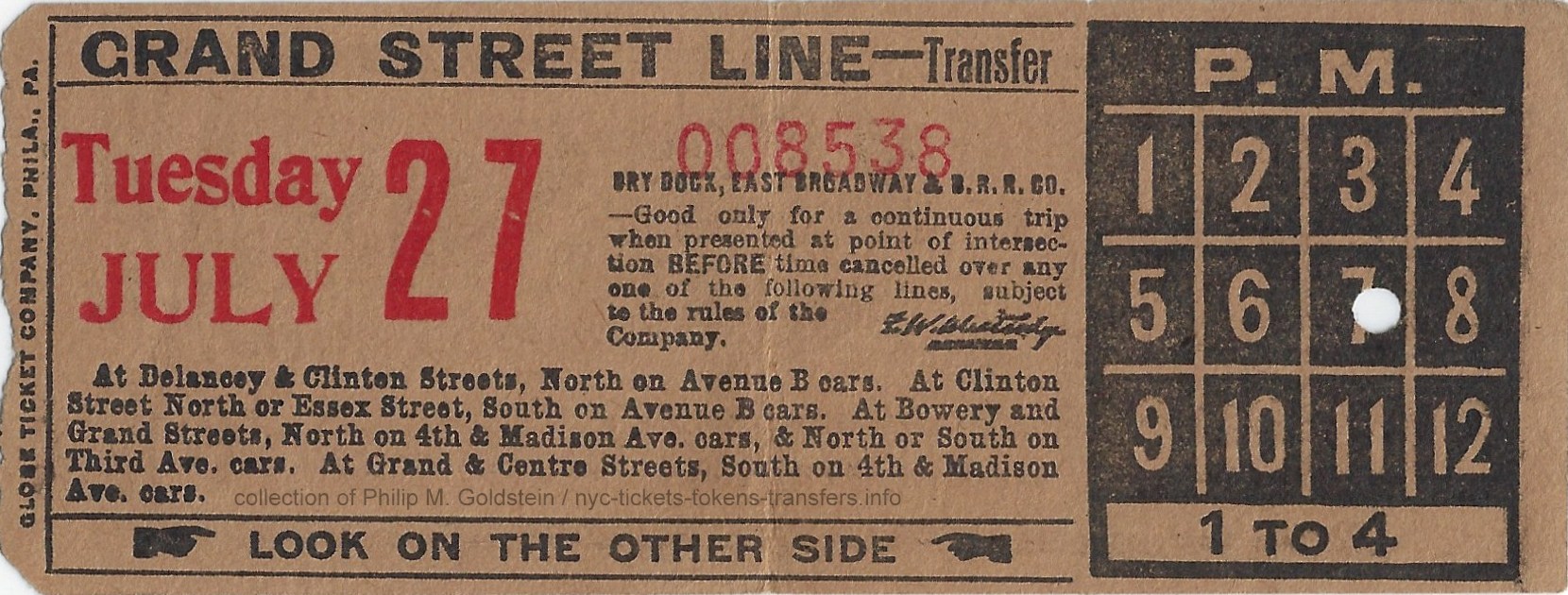 |
| PM (buff) - July 27, 1915? Dry Dock, East Broadway & Battery Railroad F. W. Whitridge, receiver Globe Ticket |
| 14th Street Line | |
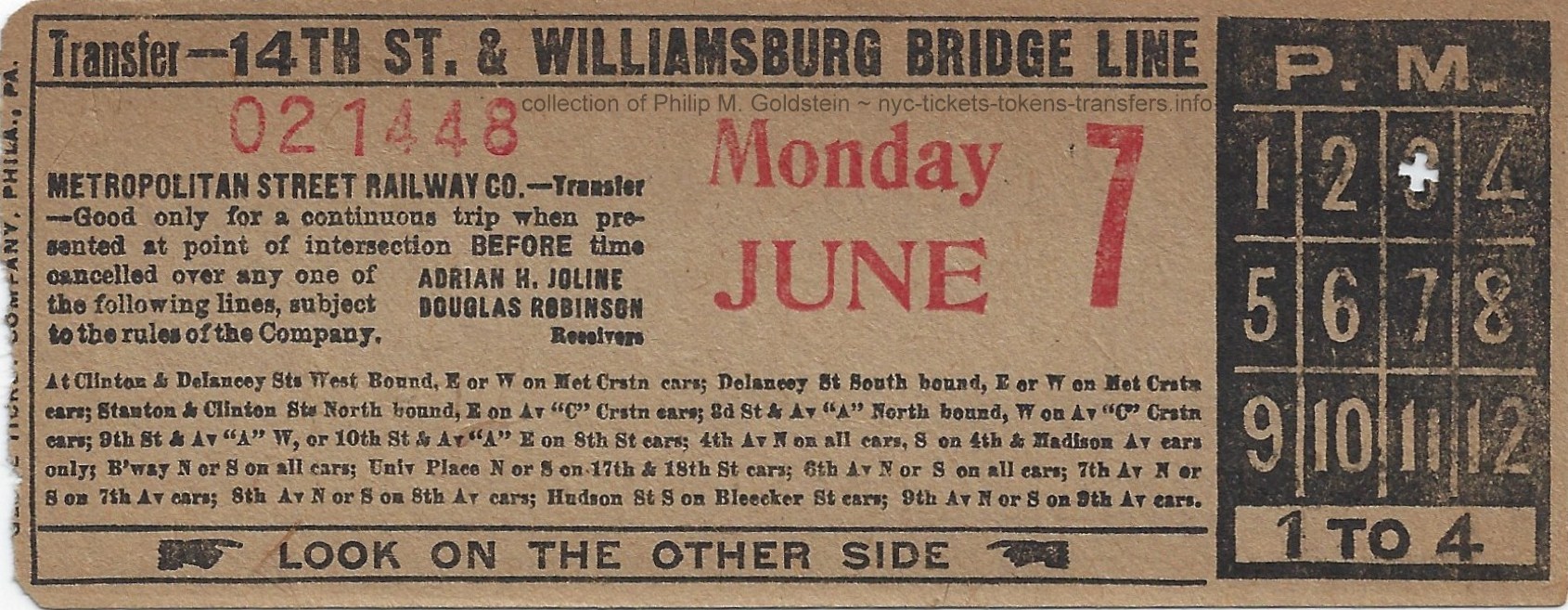 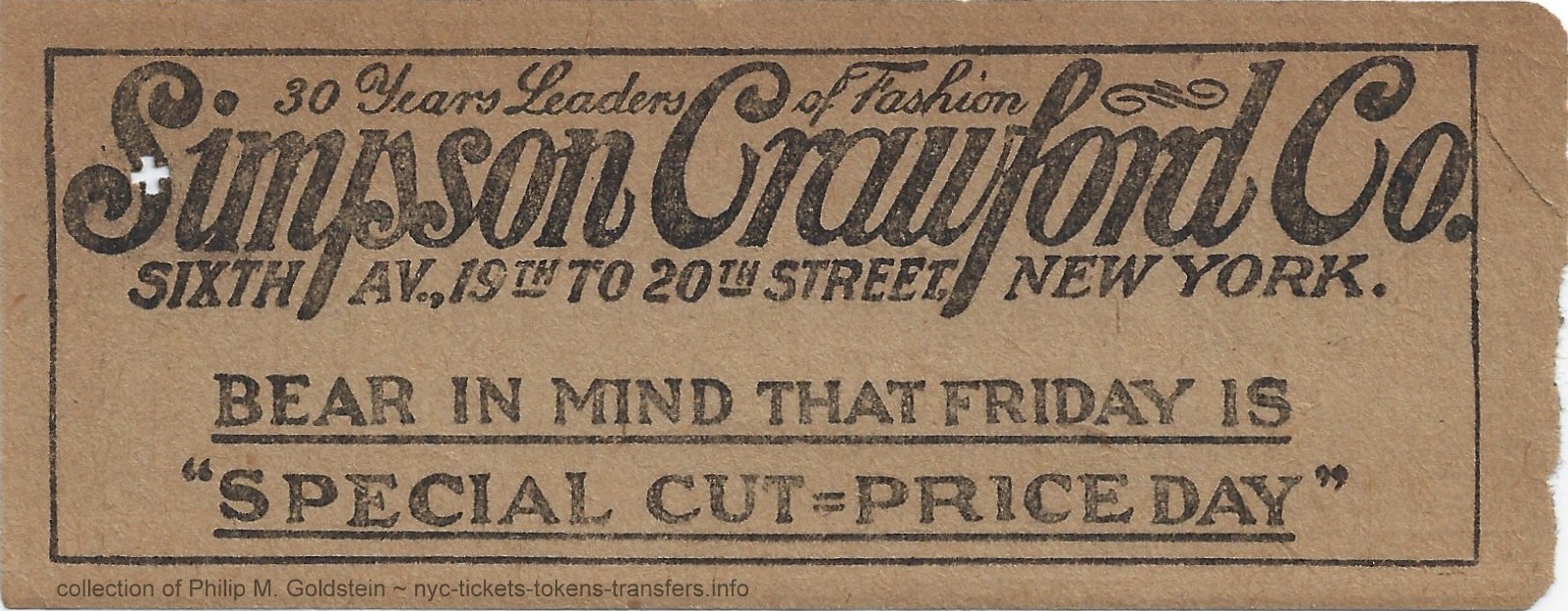 |
|
| PM (buff) - June 7, Metropolitan Street Railways Adrian H Joling, Douglas Robinson receivers Globe Ticket |
|
| 23rd Street Line | |
 |
|
| eastbound - AM/PM (buff) - Friday November 30, 1917 New York Railways T. P. Shonts, president Globe Ticket |
|
| 34th Street Crosstown Line | |
 |
 |
| (direction not specified) - AM/PM (buff) - Saturday October 2, 1926 New York Railways H. J. Sheeran, president (on back) Smith Patent |
|
| 42nd Street Crosstown Line | |
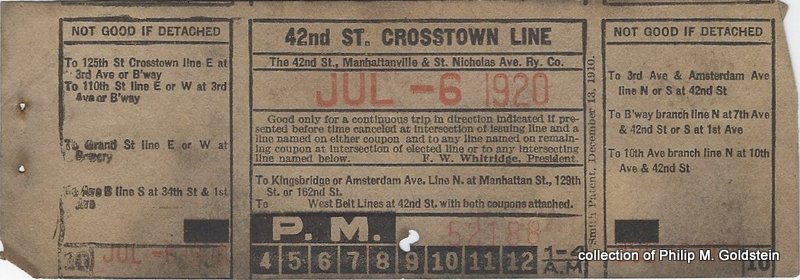 |
 |
| (direction not specified) - PM (purple) - July 6, 1920 42nd St, Manhattanville & St. Nicholas Railway F. W. Whitridge, president Smith Patent |
(direction not specified) - AM (buff) - November 23, 1934 42nd St, Manhattanville & St. Nicholas Railway S. W. Huff, president Smith Patent |
| 59th Street Crosstown Line |
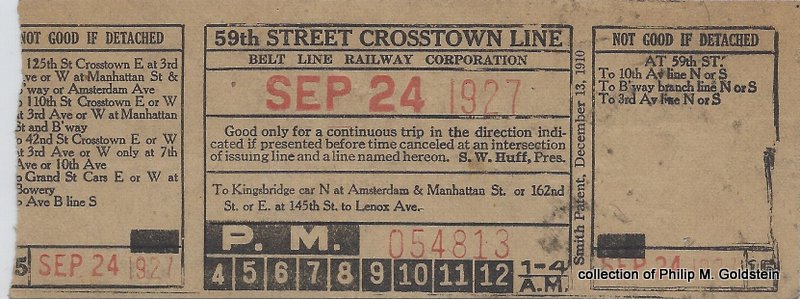 |
| (direction not specified) - PM (buff) - September 24, 1927 Belt Line Railway Corp S. W. Huff, president Smith Patent |
| 86th Street Crosstown Line |
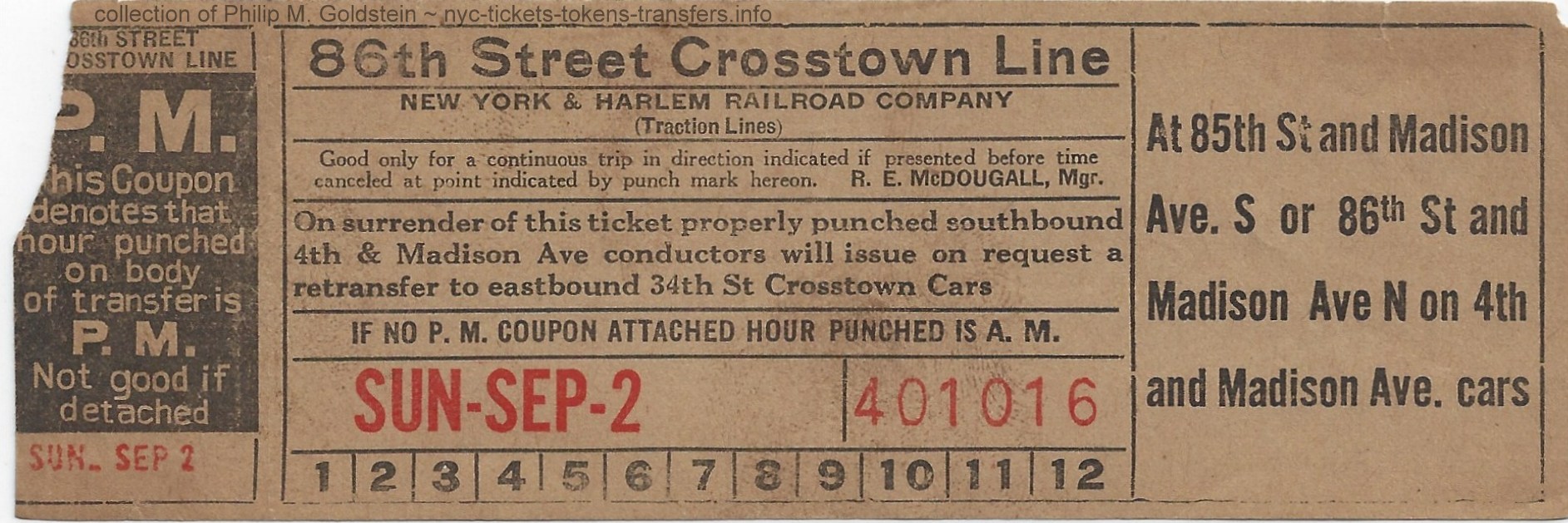 |
| September 2, detachable PM coupon New York & Harlem Railroad Co. R. E. McDougall, manager Smith Patent |
| . |
| AM - January 18, 1915 New York Railways Co. T. P. Shonts, president Smith Patent |
| 116th Street Crosstown Line |
 |
| hour punch AM / PM (buff) - June 1, 1935 New York Railways Corp H. J. Sheeran, president (on reverse) Globe Ticket |

| Jamaica Central Railways Inc. 1926-1933 Founded in 1926 as a reorganization of the Long Island Electric Railway.
which within three years had replaced all electric trolleys operated by Jamaica Central.In 1930, this company formed a bus subsidiary named Jamaica Buses, |
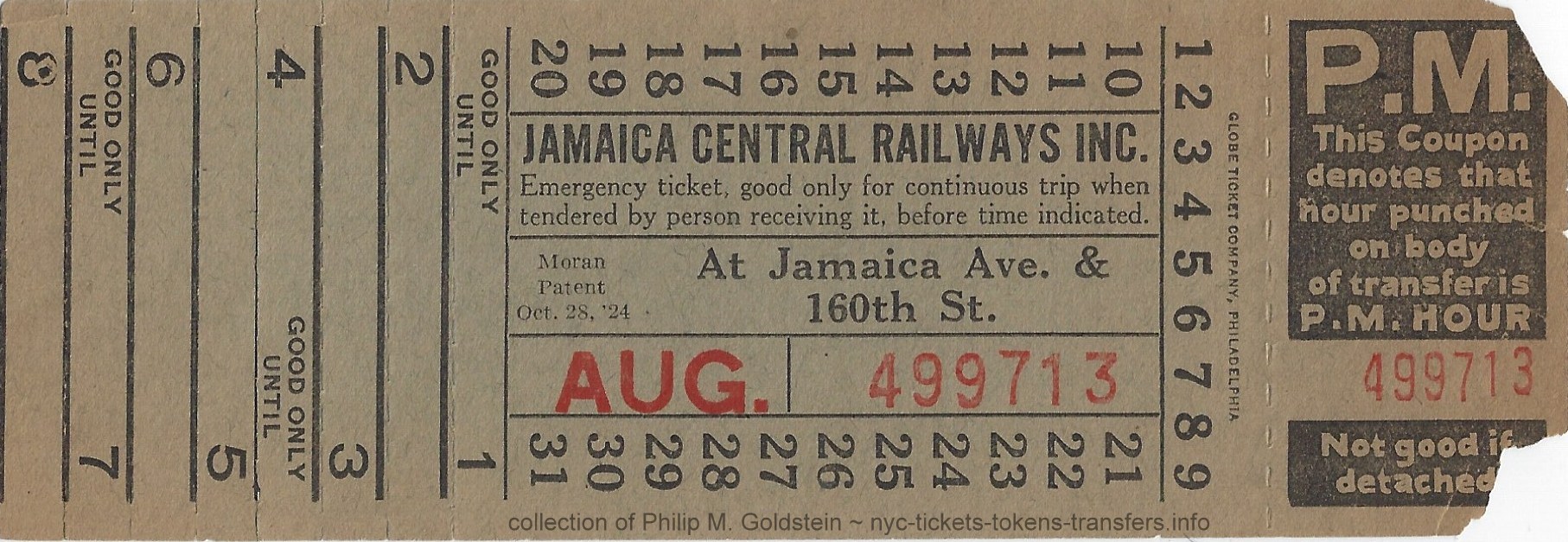 |
| (green) at Jamaica Avenue & 160th Street - August 1926-1933 30 day, detachable PM coupon Globe Ticket 2" x |
| Manhattan & Queens Traction Corp. 1912 - 1943 To date, only one known surface traction (trolley) company used a
zoned fare system and issued zone checks within the City of New York: that being the Manhattan
& Queens Traction Corp. There might be others, but they have not
come to light as yet.
The M&QT operation began as part of the South Shore Traction Company with lines in Suffolk County, but these were sold off to Suffolk Traction to finance the Queens line. This line operated from its Manhattan Terminal at the Queensboro Bridge, and was steadily expanded to Woodside, Elmhurst, Forest Hills and reaching Jamaica in 1914. This route was known as the "Queens Boulevard Line" Its terminal in Jamaica was accomplished through trackage rights acquired with the Brooklyn, Queens County & Suburban Railroad (a subsidiary of the Brooklyn Rapid Transit). The M&QT also had a spur industrial track spur along Van Dam Street in Long Island City, and a very small extension south of the Jamaica Station, that was part of a extension that never came to fruition. Zone 1 began at the Manhattan Terminal of the Queensboro Bridge, routed over the Queensboro Bridge, and along Queens Boulevard to Grand Street in Elmhurst. This was changed in 1920 to Old Mill Road (which is now known as 63rd Road / Junction Boulevard) in Elmhurst. Zone 2 began at Grand Avenue in Elmhurst; to the LIRR Jamaica Terminal on Sutphin Boulevard. M&QT fares prior to the Zoned System were 6 to 11 cents. It requested of and was approved by the Public Service Commission to emplace a zoned fare system on November 1, 1923. The fare became 5 cents for Zone 1 travel, 5 cents for Zone 2 travel, and 3 cents for the Queensboro Bridge Local Line. In 1937, the M&QT would recharter itself into the Manhattan & Queens Bus Corp, and operate the Q60 - Queens Boulevard bus line. In 1943, the company was bought out by Green Bus. For an explanation on how Zone Checks worked, please refer to Zone Checks |
|
 |
 |
| Continuing Trip 12 month, 30 day, clock punch cancellation Globe Ticket 5 1/4" x 2" |
2nd Fare Zone (blue) 3" x 1" |
| . | |
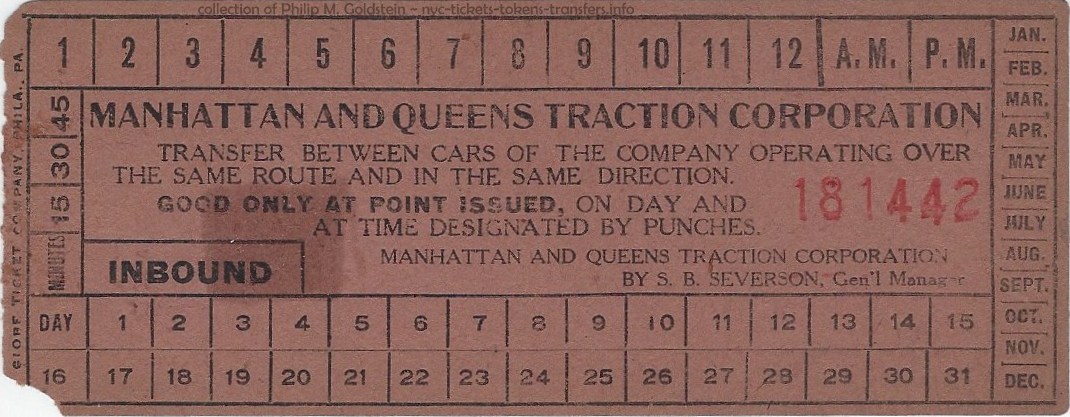 |
|
| S. B. Severson, general manager (1917- 1919) 12 month, 30 day, hour & 15 minute punch cancellation Globe Ticket 5 3/16" x 2" |
|
| . | |
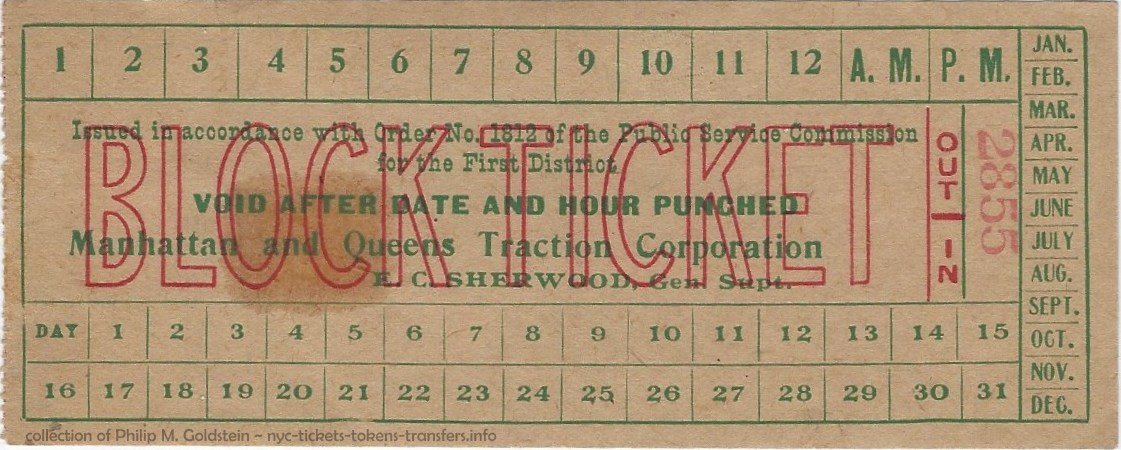 |
|
| Block Ticket E. C. Sherwood, general superintendent (1914 - ?) 12 month, 30 day, hour punch cancellation 5 3/16" x 2" |
|
| . . |
|
| New York & Queens County Railway 1896 - 1932 |
|
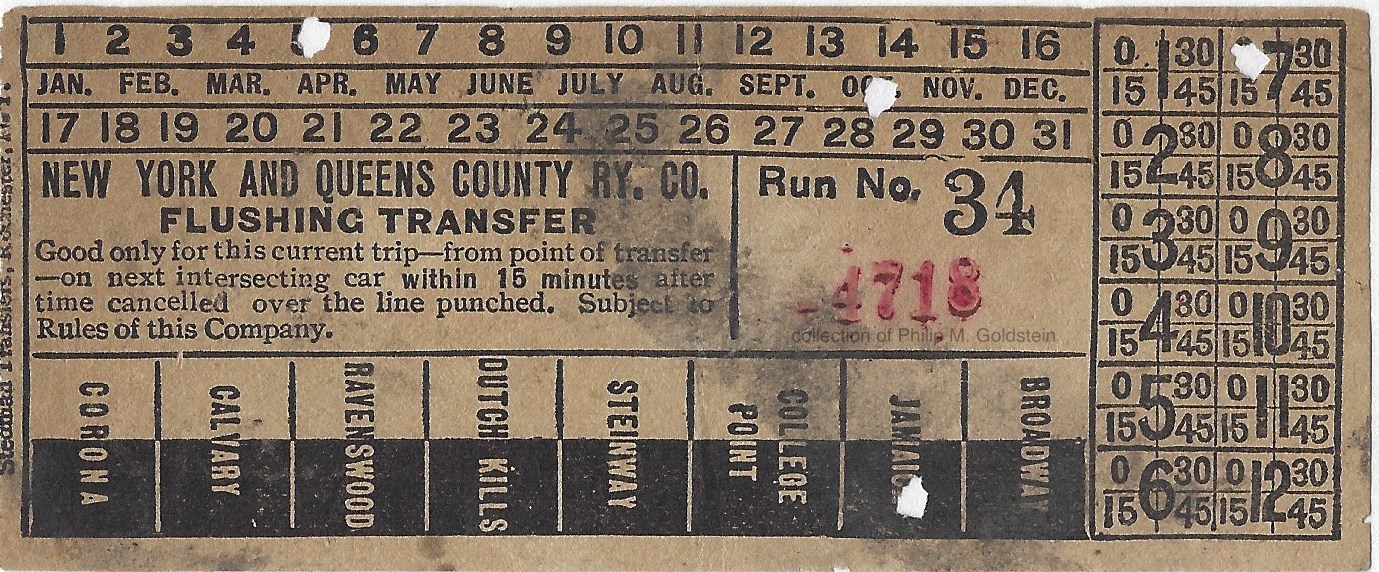 |
|
| Jamaica Transfer, Run 7 - September 25 (orange) 12 month, 30 day, hour & 15 minute punch cancellation Globe Ticket 4 1/4" x 2 |
Flushing Transfer, Run 34 - October 5 (buff) 12 month, 30 day, hour & 15 minute punch cancellation Stedman Transfers 4 9/16" x 1 7/8" |
| . | |
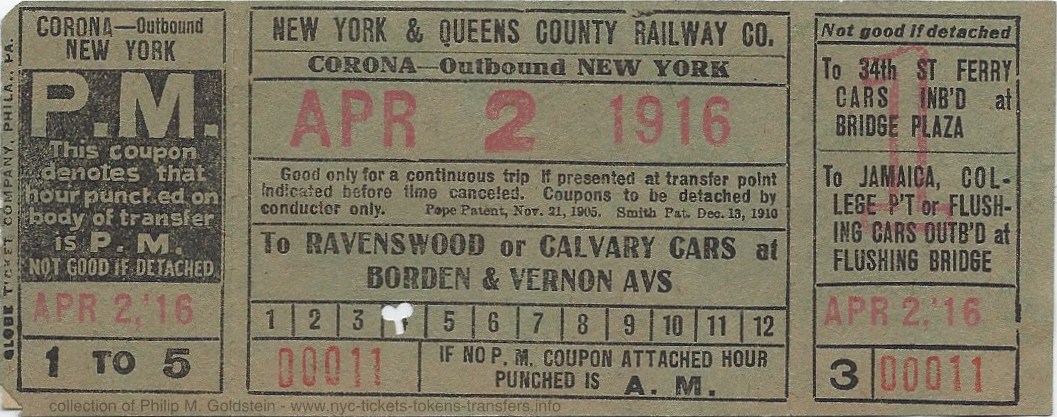 |
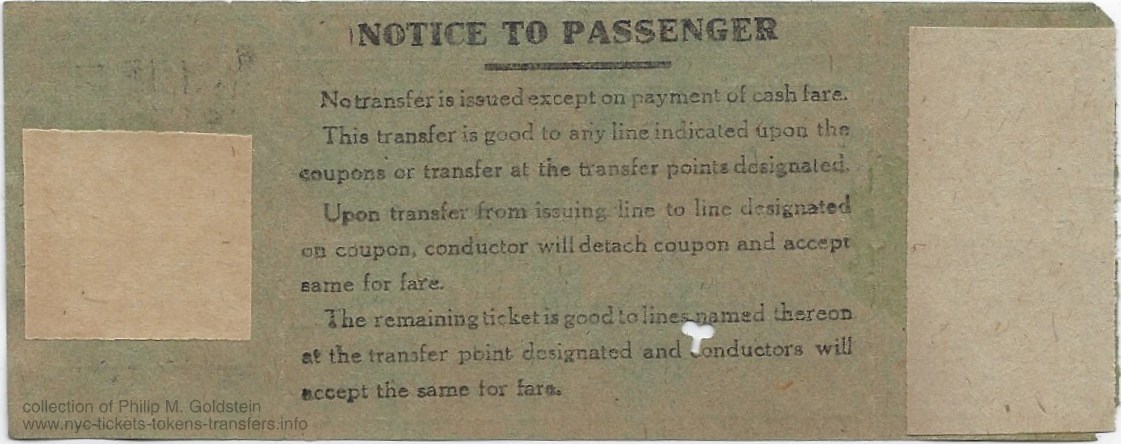 |
| Corona Outbound (green) PM detachable coupon Globe Ticket note dual Pope Patent & Stedman Patent 5 1/4" x 2" |
|
| Steinway Lines (Receivership: S. W. Huff (president of Third Avenue Railway) & R. C. Lee (and insurance broker) May 10, 1922 - Fall 1939
In 1896, the Steinway Railway was merged with the New York &
Queens County Railway Company, which itself became a subsidiary of the
Interborough Rapid Transit Company (IRT).
This new company prospered until the Long Island Rail Road reached Penn Station in 1910, and the IRT was extended to Corona and Astoria in 1917. Oddly enough, IRT’s trains now competed with their own subsidiary. During the post-World War I inflation, most transit lines operated at a loss, but they were forced to retain the five-cent fare. When Steinway Railway defaulted on the bonds’ interest, payable January 1, 1922; The president of the Third Avenue Railway: Slaughter W. Huff, and an insurance broker, R. C. Lee, were appointed as receivers of Steinway Lines. Steinway Lines was then separated from NY&QC Railway. Huff & Lee started operating the original Steinway Lines on May 10, 1922, charging a separate 5 cent fare without transfer privileges to NY&QC Rwy. lines. Steinway’s fleet of old cars were transferred to NY&QC Rwy, and were replaced by the purchase of second-hand cars as well as transfer of the oldest cars then operating on the Third Avenue Railway to the Steinway Lines. During the intervening years, streetcars were frequently transferred between Steinway Lines and Third Avenue Railway, on a interchange track which was located just east of East 59th Street and Second Avenue. This track (with no overhead trolley and no underground conduit) connected the eastbound Queensboro Bridge track with the westbound East 59th Street track. Between September and December of 1939, the company was renamed Steinway Omnibus, and began operating internal combustion powered buses over the former streetcar lines. In 1959 the name changed again to Steinway Transit.
|
||||||||||||||||||||||||||||||||||||
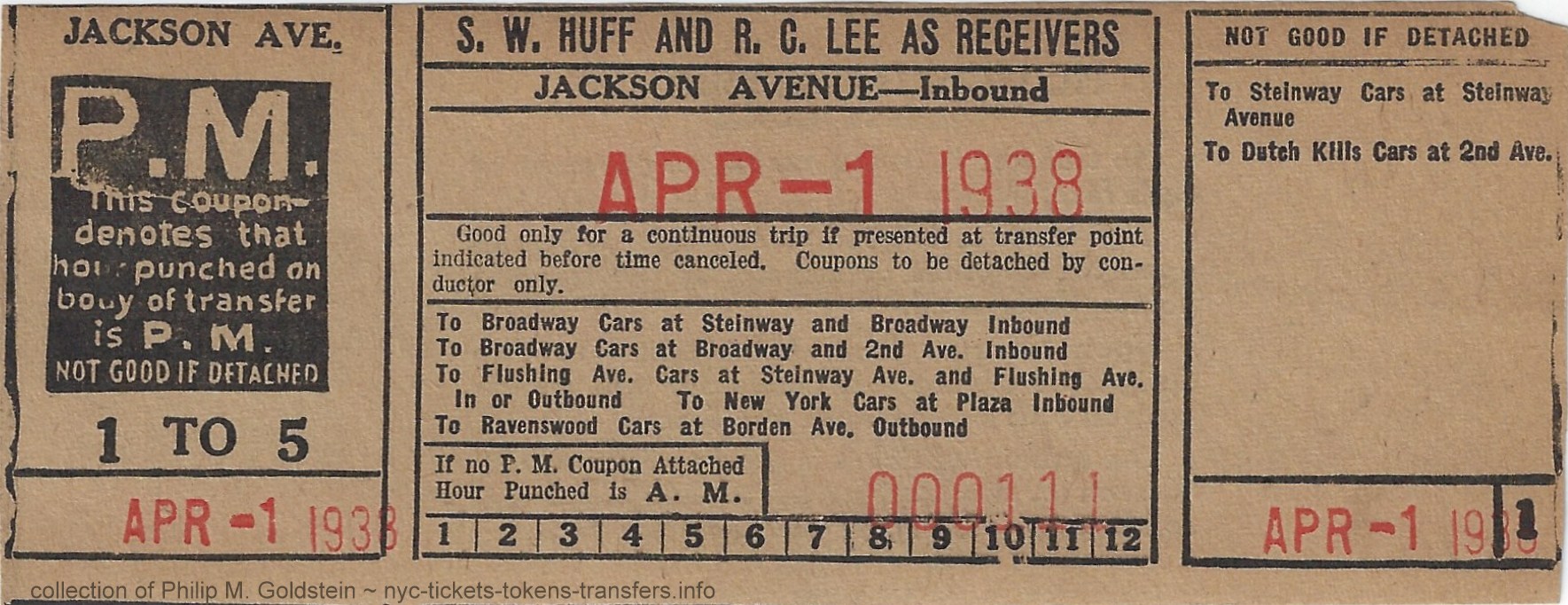 Jackson Avenue Inbound - April 1 1938 (buff) PM detachable coupon S. W. Huff and R. C. Lee as receivers at top 2 1/16" x 5 3/8" |
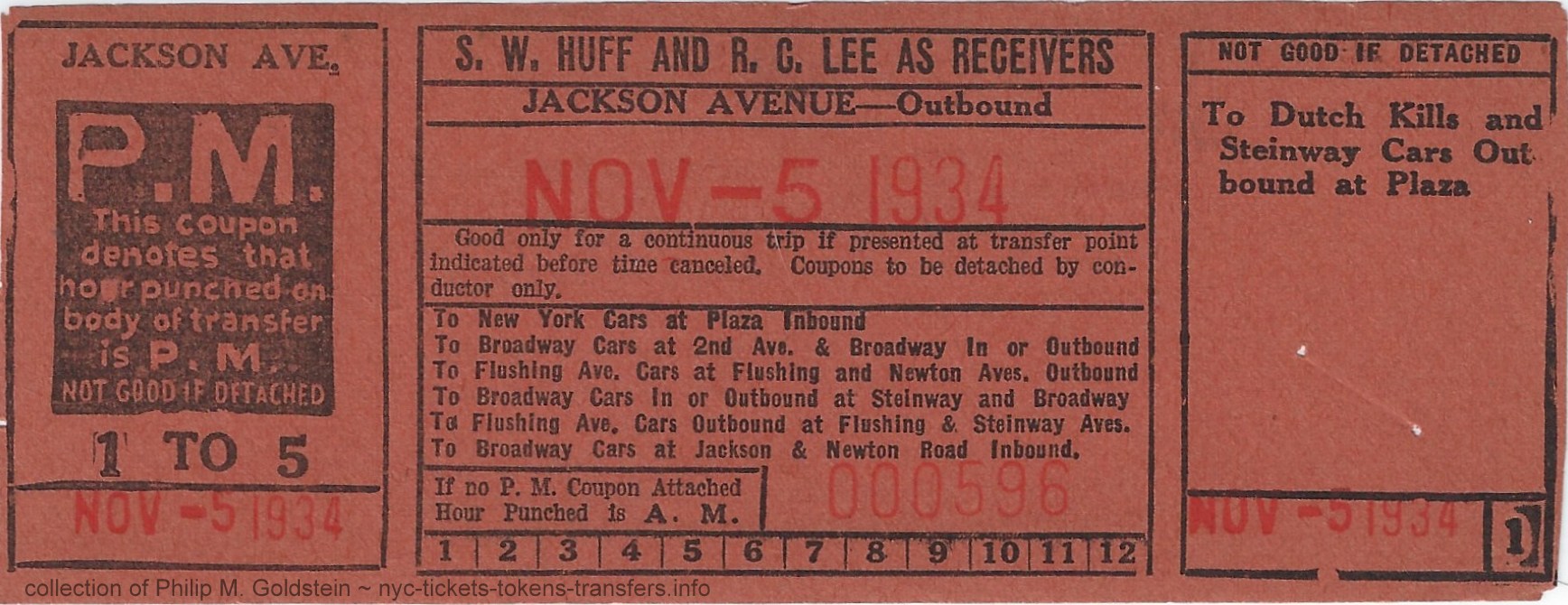 Jackson Avenue Outbound - November 5, 1934 (orange) PM detachable coupon S. W. Huff and R. C. Lee as receivers at top 2 1/16" x 5 7/16" |
|||||||||||||||||||||||||||||||||||
| . | ||||||||||||||||||||||||||||||||||||
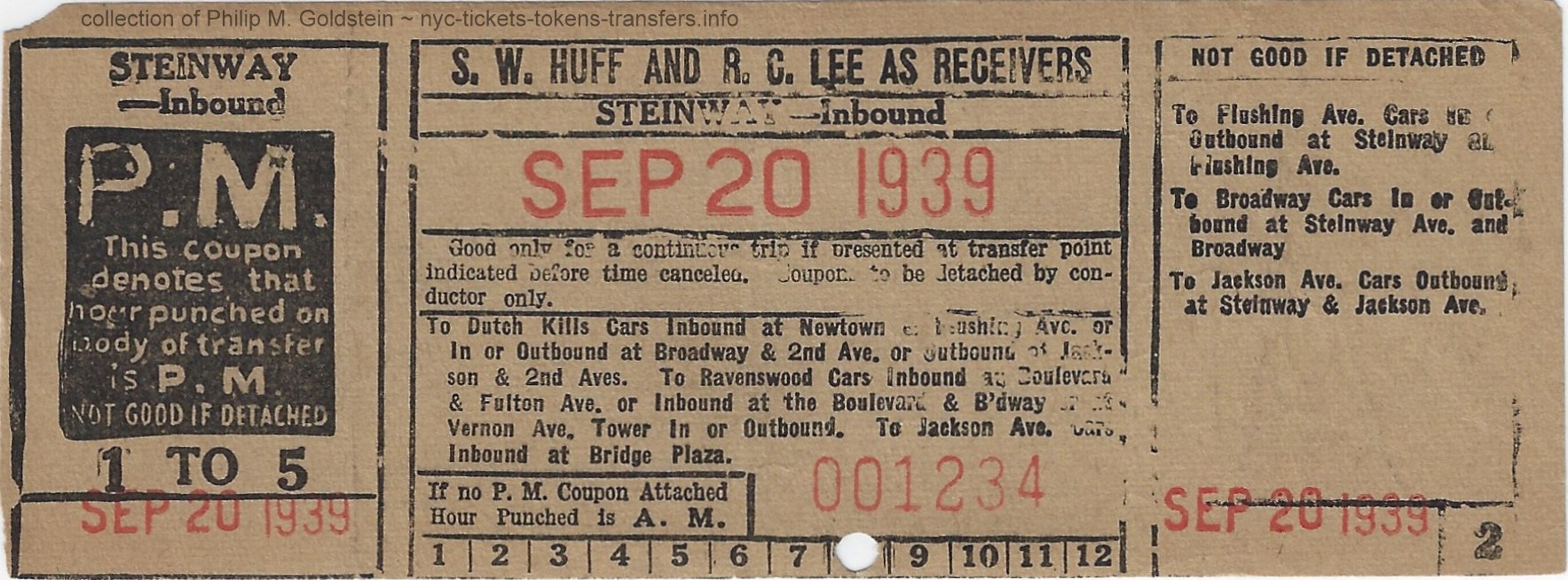 Steinway Inbound - September 20, 1939 (buff) PM detachable coupon S. W. Huff and R. C. Lee as receivers at top 2 1/16" x 5 9/16" |
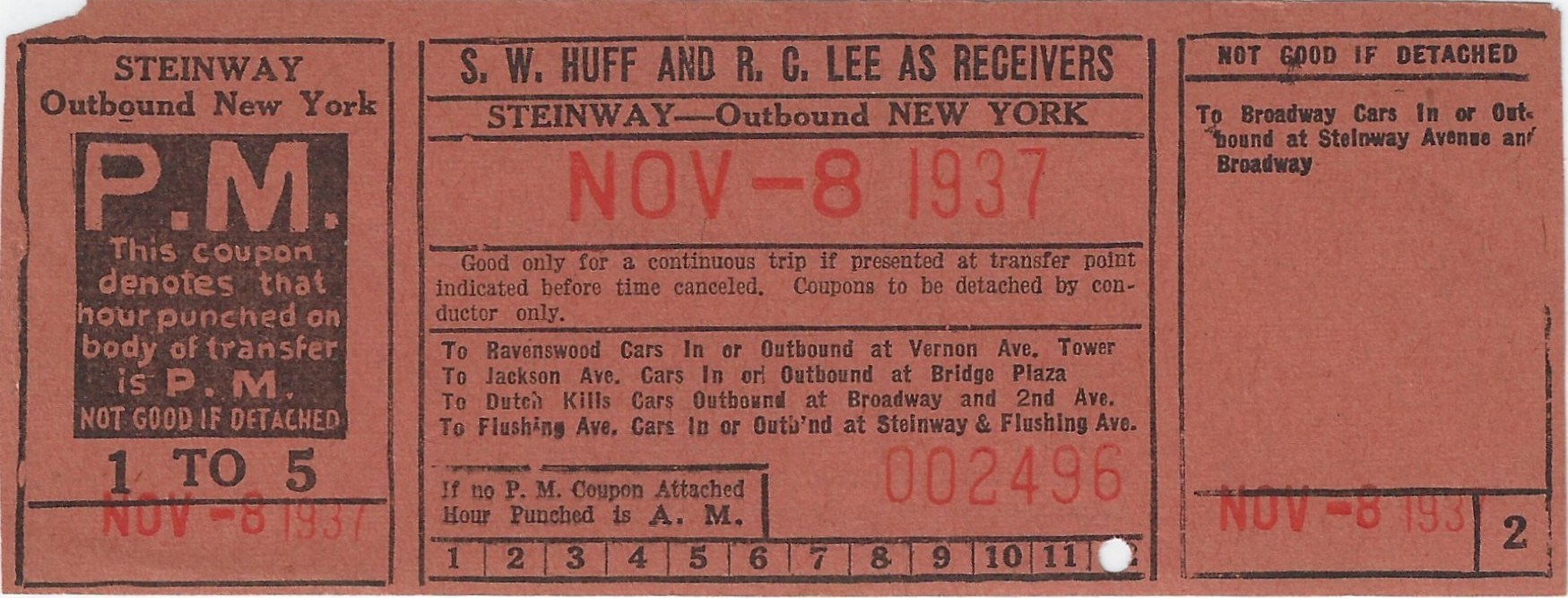 Steinway Outbound - November 8, 1937 (orange) PM detachable coupon S. W. Huff and R. C. Lee as receivers at top 2 1/16" x 5 7/16" |
|||||||||||||||||||||||||||||||||||
| . | ||||||||||||||||||||||||||||||||||||
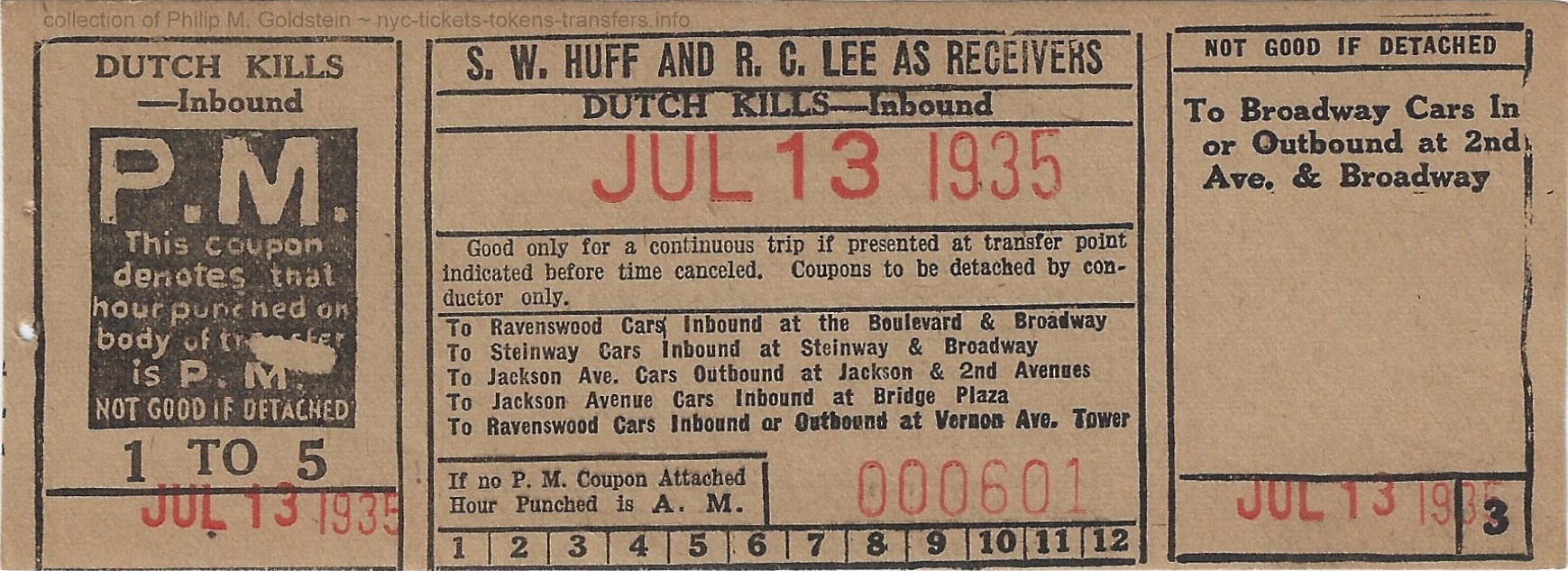 Dutch Kills Inbound - July 13, 1935 (buff) PM detachable coupon S. W. Huff and R. C. Lee as receivers at top 2 1/16" x 5 9/16" |
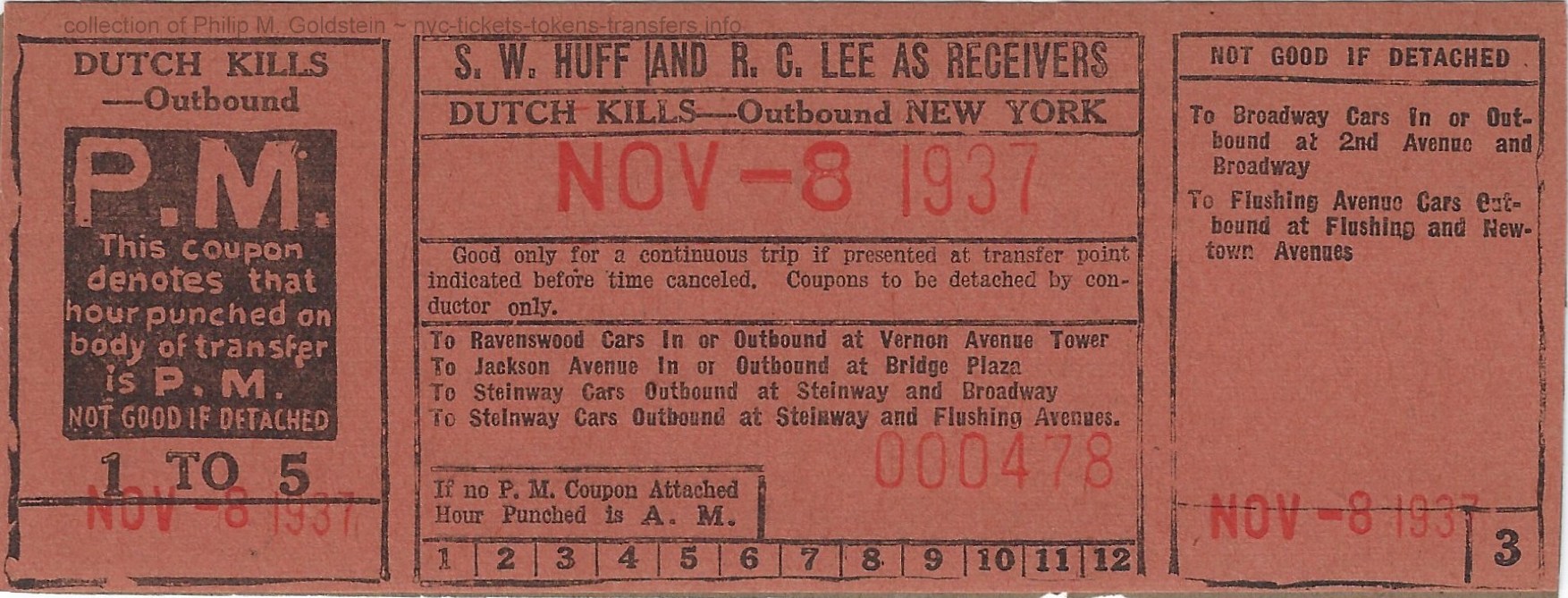 Dutch Kills Outbound - November 8, 1937 (orange) PM detachable coupon S. W. Huff and R. C. Lee as receivers at top 2 1/16" x 5 7/16" |
|||||||||||||||||||||||||||||||||||
| . | ||||||||||||||||||||||||||||||||||||
| intentionally left blank | 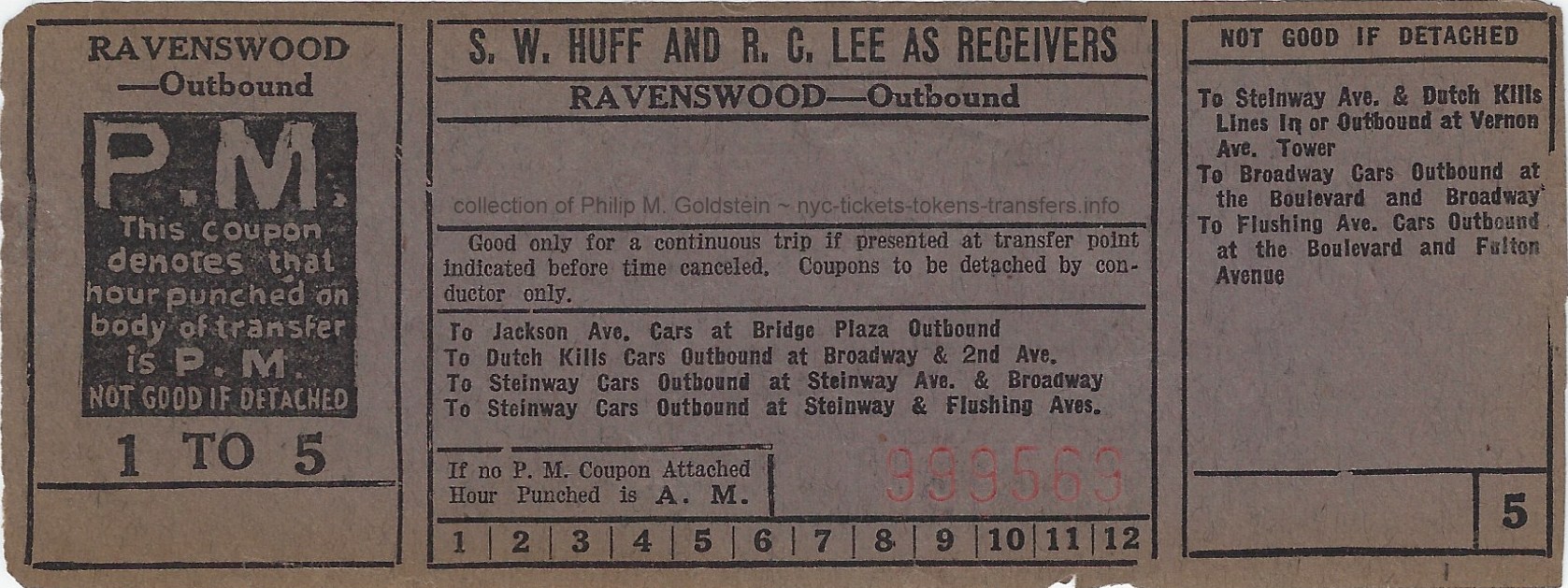 Ravenswood Outbound - undated (purple) PM detachable coupon S. W. Huff and R. C. Lee as receivers at top 2 1/16" x 5½" |
|||||||||||||||||||||||||||||||||||
| . | ||||||||||||||||||||||||||||||||||||
| intentionally left blank |  Broadway Outbound - February 13, 1935 (orange) PM detachable coupon S. W. Huff and R. C. Lee as receivers at top 2 1/16" x 5½" |
|||||||||||||||||||||||||||||||||||
| New York and Queens Transit Corporation 1932 - 1937 (to Queens Nassau Transit Lines - bus) |
|
 Form 1 - AM (green) day punch, hourly detach Moran Patent |
 Form 2 - PM (salmon) day punch, hourly detach Moran Patent |
| Queensboro Bridge Railway | |
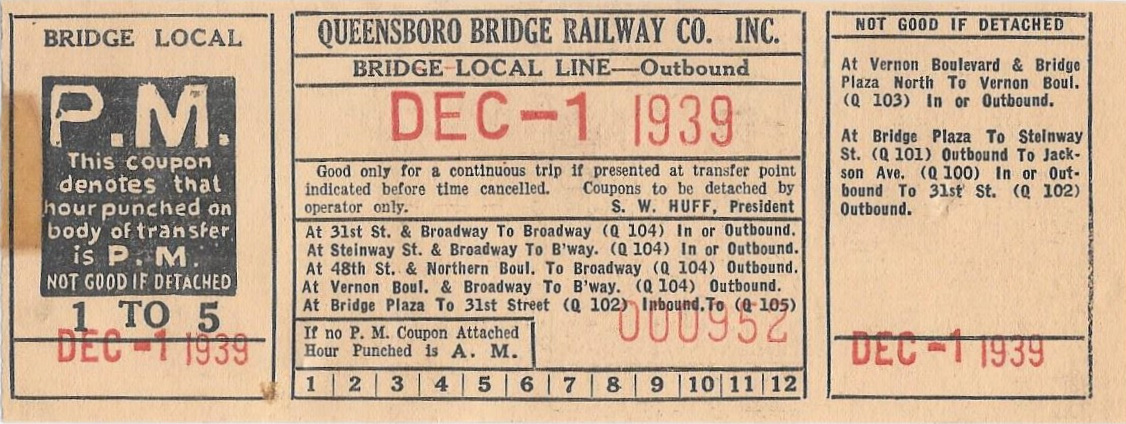 |
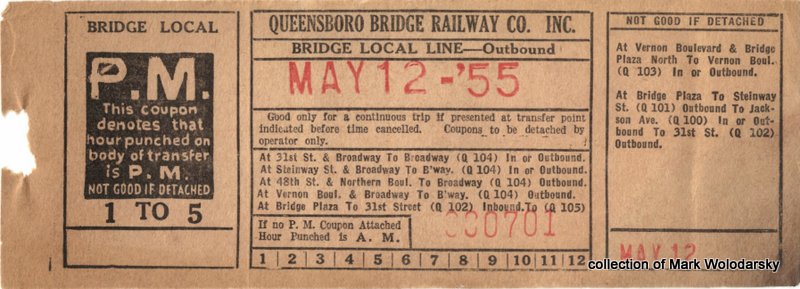 |
| Bridge Local Line - Outbound - December 1, 1939 (buff) PM detachable coupon S. W. Huff, president |
Bridge Local Line - Outbound - May 12, 1955 (last day of Third Avenue Elevated) (buff) PM detachable coupon (name redacted) |
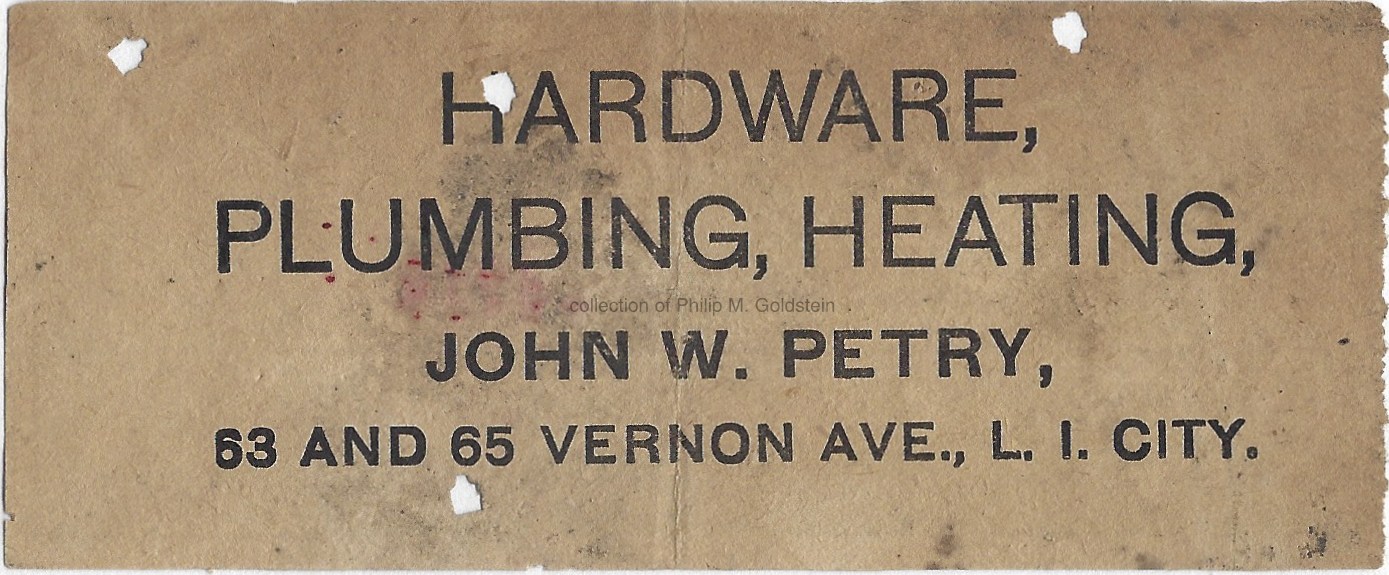 |
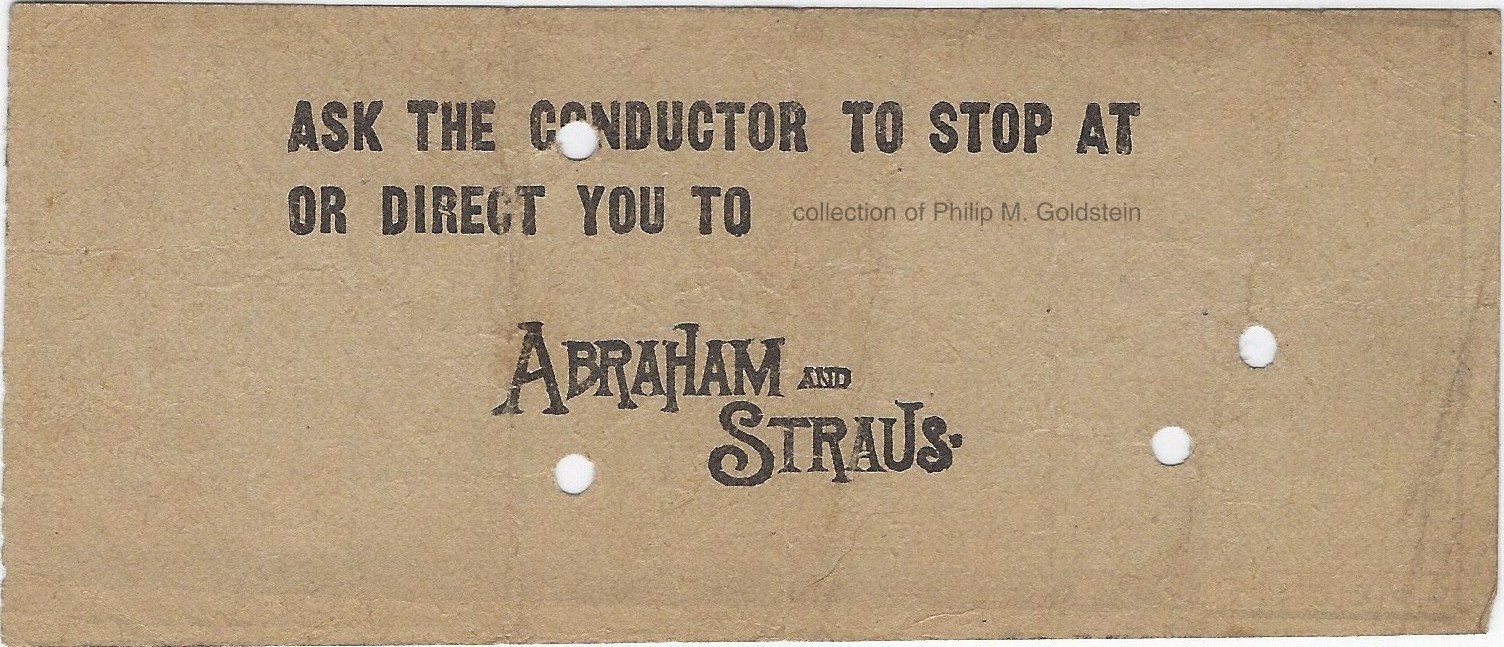 |
|
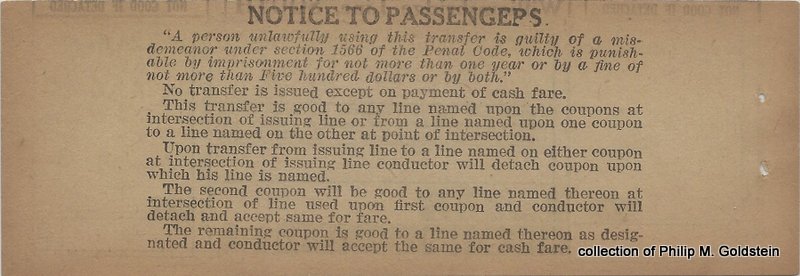 |
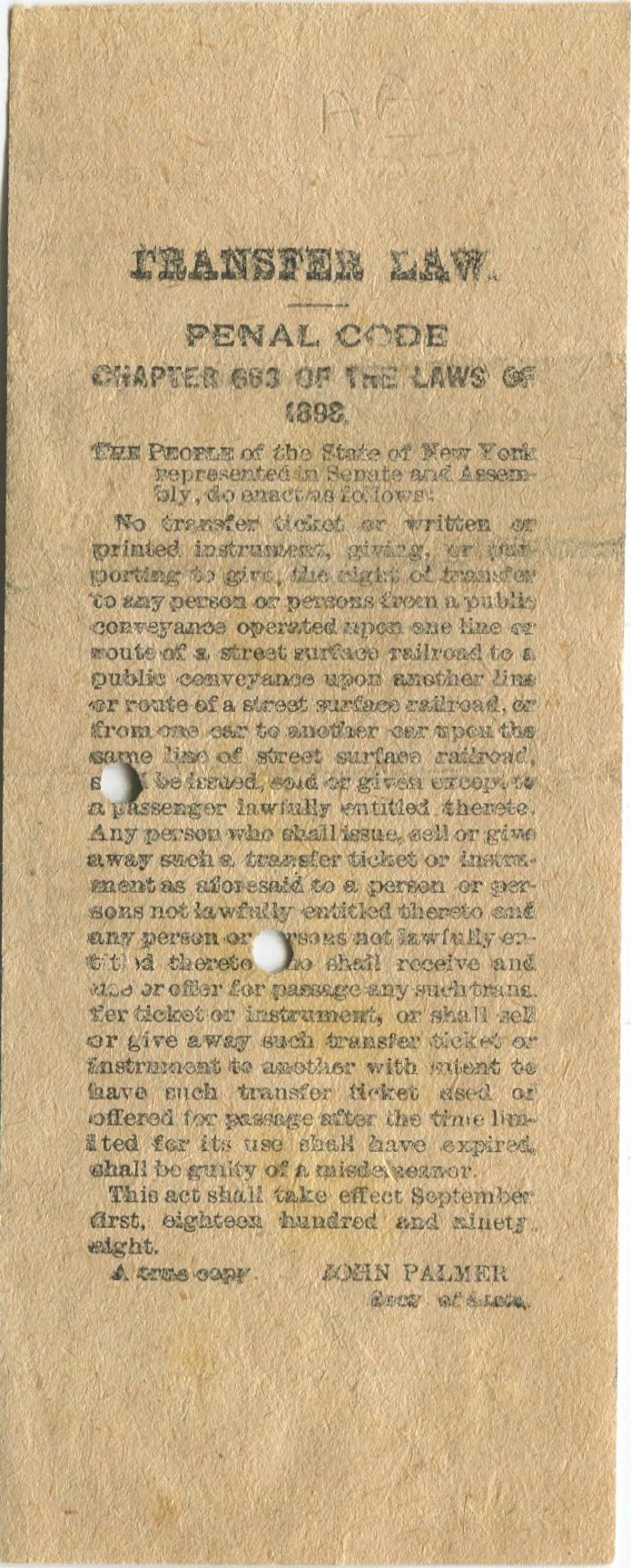 |
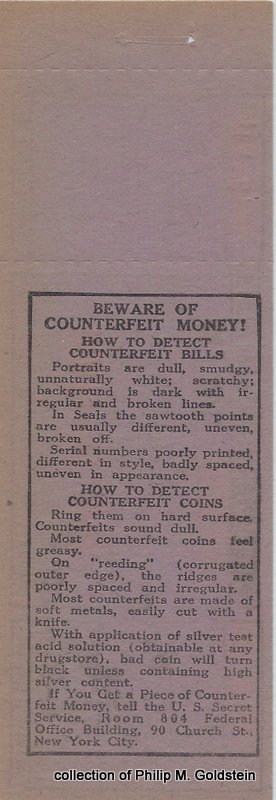 |
| mostly common; however issues with advertising from well known businesses and department stores, 10% premium. | ||
| Line Number | From | To | Streets | Abandoned | Notes |
| 1 | Port Ivory | St. George Ferry Terminal | Richmond Terrace | January 21, 1934 | now the S40 bus |
| 2 | Shore Acres | St. George Ferry Terminal | Bay Street | January 7, 1934 | now the S51 bus |
| 3 | Port Richmond | St. George Ferry Terminal | Richmond Terrace, Clove Road, Castleton Avenue, Brook Street, Victory Boulevard, and Bay Street | January 14, 1934 | now the S46 bus |
| 4 | Bulls Head | Port Richmond | Richmond Avenue, Forest Avenue, and Port Richmond Avenue | December 31, 1933 | now the S59 bus |
| 5 | Ward Hill | St. George Ferry Terminal | Jersey Street and Richmond Terrace | December 31, 1933 | now the S52 bus |
| 6 | Port Richmond | St. George Ferry Terminal | Richmond Terrace | January 21, 1934 | now the S40 bus |
| 7 | Port Richmond | St. George Ferry Terminal | Richmond Terrace, Jewett Avenue, Victory Boulevard, and Bay Street | January 26, 1934 | originally the Midland Railway's Silver Lake Line; now the S62 and S66 buses |
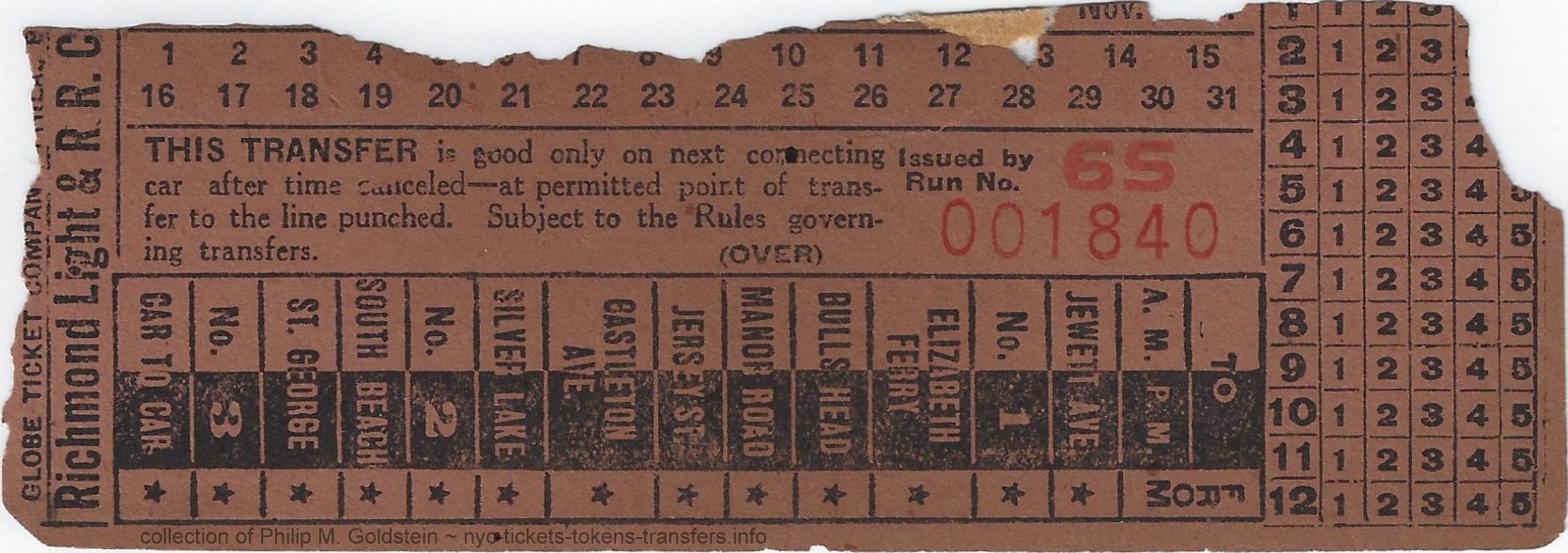 |
| (brown) 6S - 12 month, 30 day, hour, 10 minute punch cancellation Globe Ticket 5¼" x 2" |
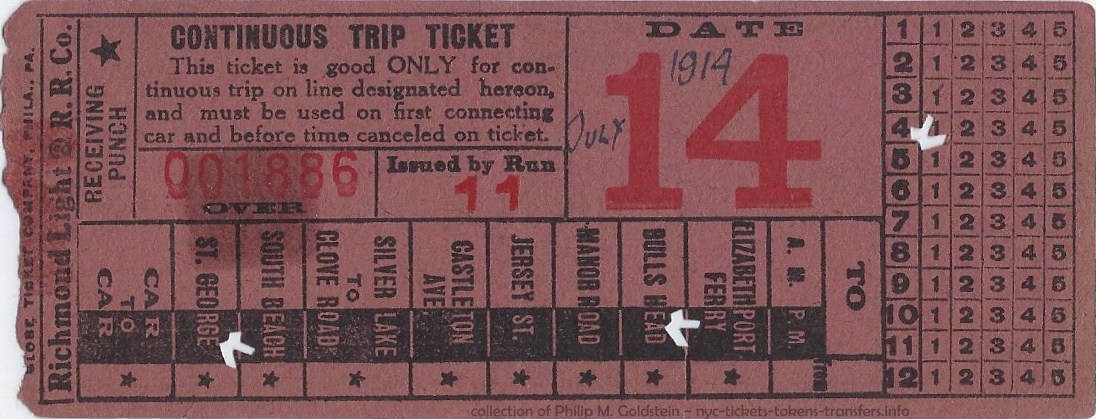 |
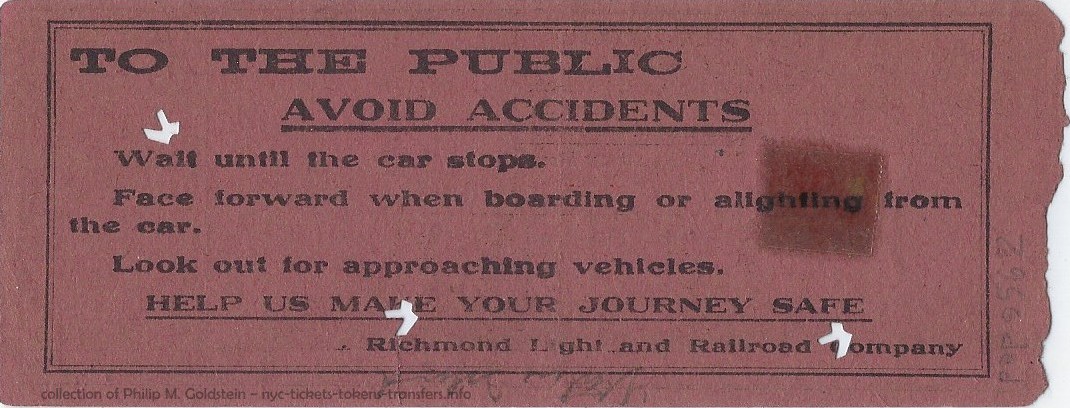 |
| July 14, 1914 (purple) 12 month, 30 day, hour, 10 minute punch cancellation Globe Ticket 5 5/16" x 2 1/16" |
|
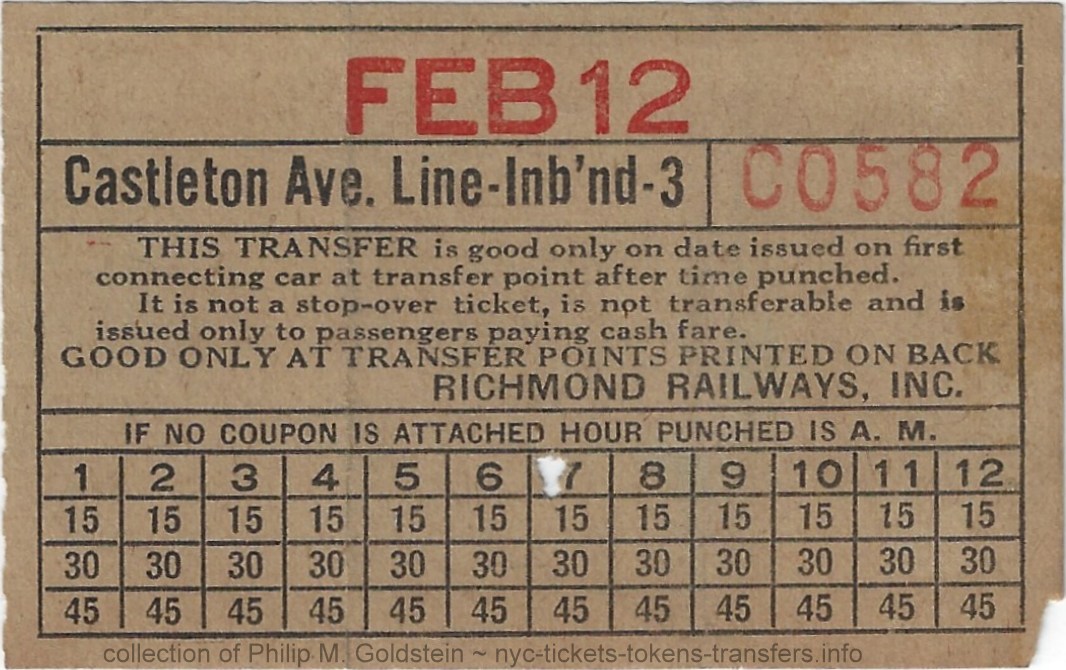 |
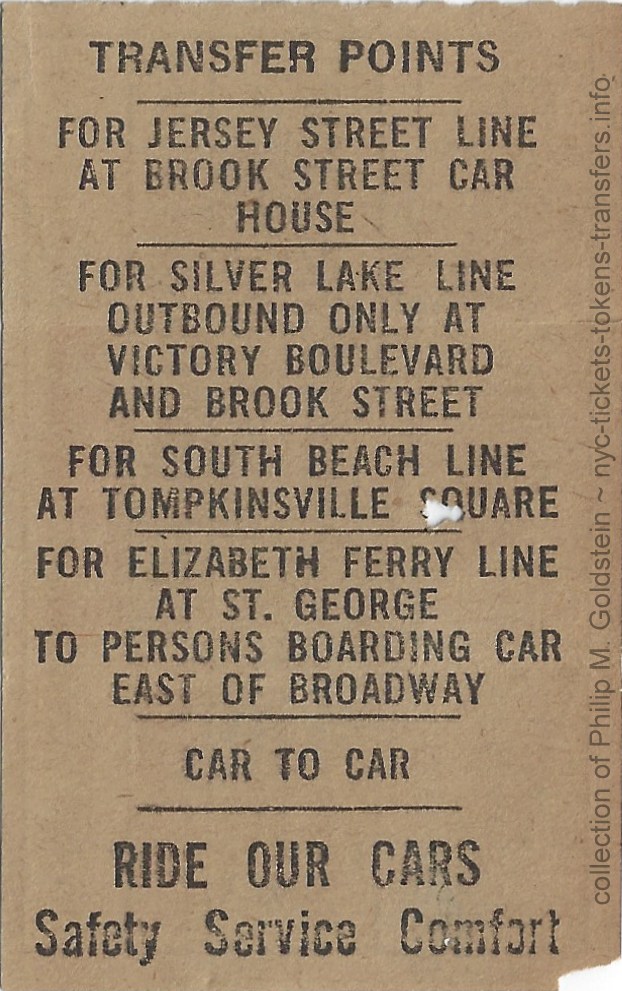 |
| Richmond Railways - 1927-1933 3¼" x 2" |
|
.
.
Staten Island Midland Railroad
| Line Name | From | To | Streets | Abandoned | Notes |
| Midland Beach | Midland Beach | St. George Ferry Terminal | Midland
Avenue, Lincoln Avenue, Richmond Road, Van Duzer Street, Broad Street,
Canal Street, Wright Street, Van Duzer Street, Victory Boulevard, and Bay Street |
1927 | operated as the S72 bus until 1992 |
| Concord | Port Richmond | St. George Ferry Terminal | Richmond
Terrace, Jewett Avenue, Victory Boulevard, Clove Road, Richmond Road,
Van Duzer Street, Broad Street, Canal Street, Wright Street, Van Duzer Street, Montgomery Street, Hyatt Street, and Bay Street |
September 18, 1920 October 16, 1927 |
now the S53, S66, and S74 buses |
| Manor Road | Todt Hill | Livingston | Manor Road, Delafield Avenue, Clove Road, Castleton Avenue, and Broadway | August 21, 1927 | now the S54 bus |
| Richmond | Richmondtown | St. George Ferry Terminal | Richmond
Road, Van Duzer Street, Broad Street, Canal Street, Wright Street, Van Duzer Street, Victory Boulevard, and Bay Street |
October 16, 1927 | now the S74 bus |
| Silver Lake | Port Richmond | St. George Ferry Terminal | Richmond Terrace, Jewett Avenue, Victory Boulevard, and Bay Street | taken over by the Richmond Light and Railroad Company as route 7 in 1927 |
|
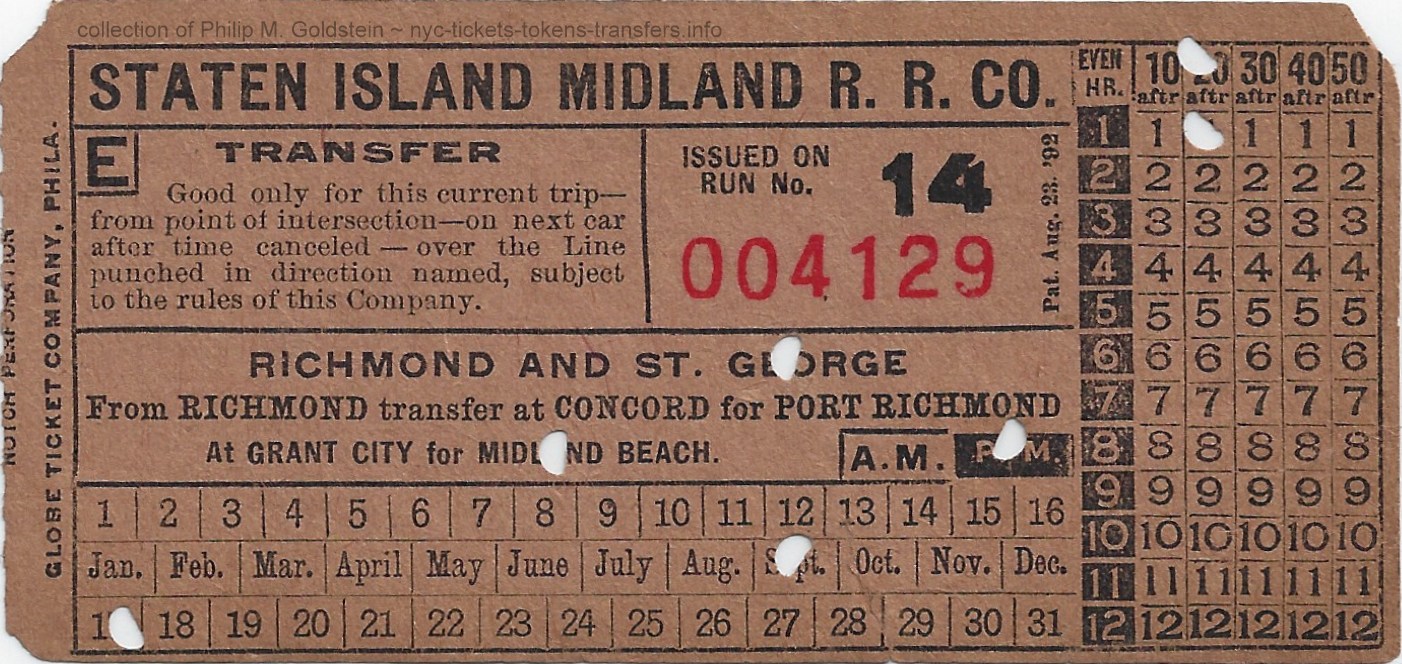 |
|
| Richmond and St. George - September 17, ? (1920-1927) From Richmond transfer at Concord for Port Richmond At Grant City for Midland Beach 2" x 4¼" |
|
 |
||
 |
 |
|
 |
.
All
content, graphics, and text in part or in whole, unless otherwise noted.
This
website and its authors are not affiliated, employed nor represent the
Metropolitan Transportation Authority, New York City Transit Authority,
The Transit Museum, the City of New York, the State of New York or any
other municipal governmental
agency; or any private company contracted by the previous agencies; and
no such affiliation is implied or suggested.